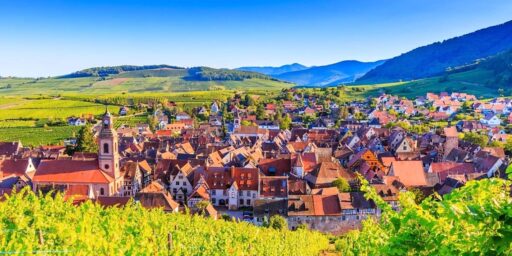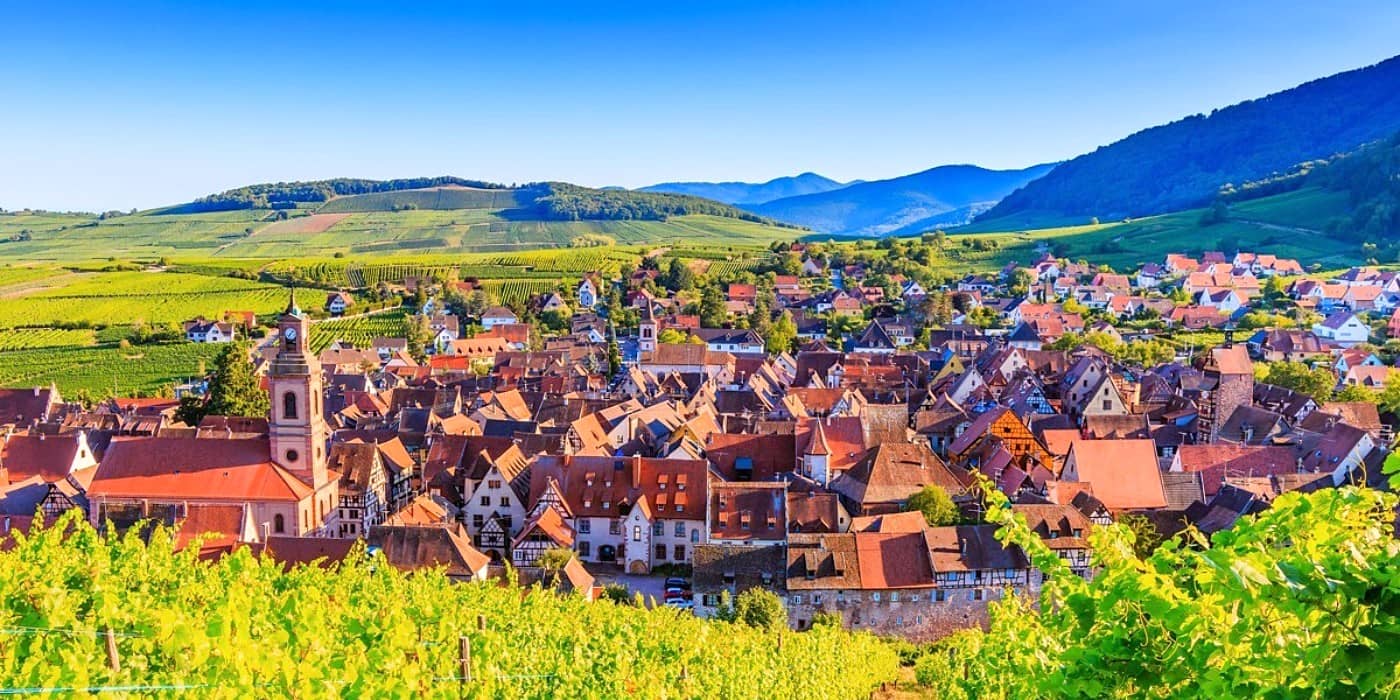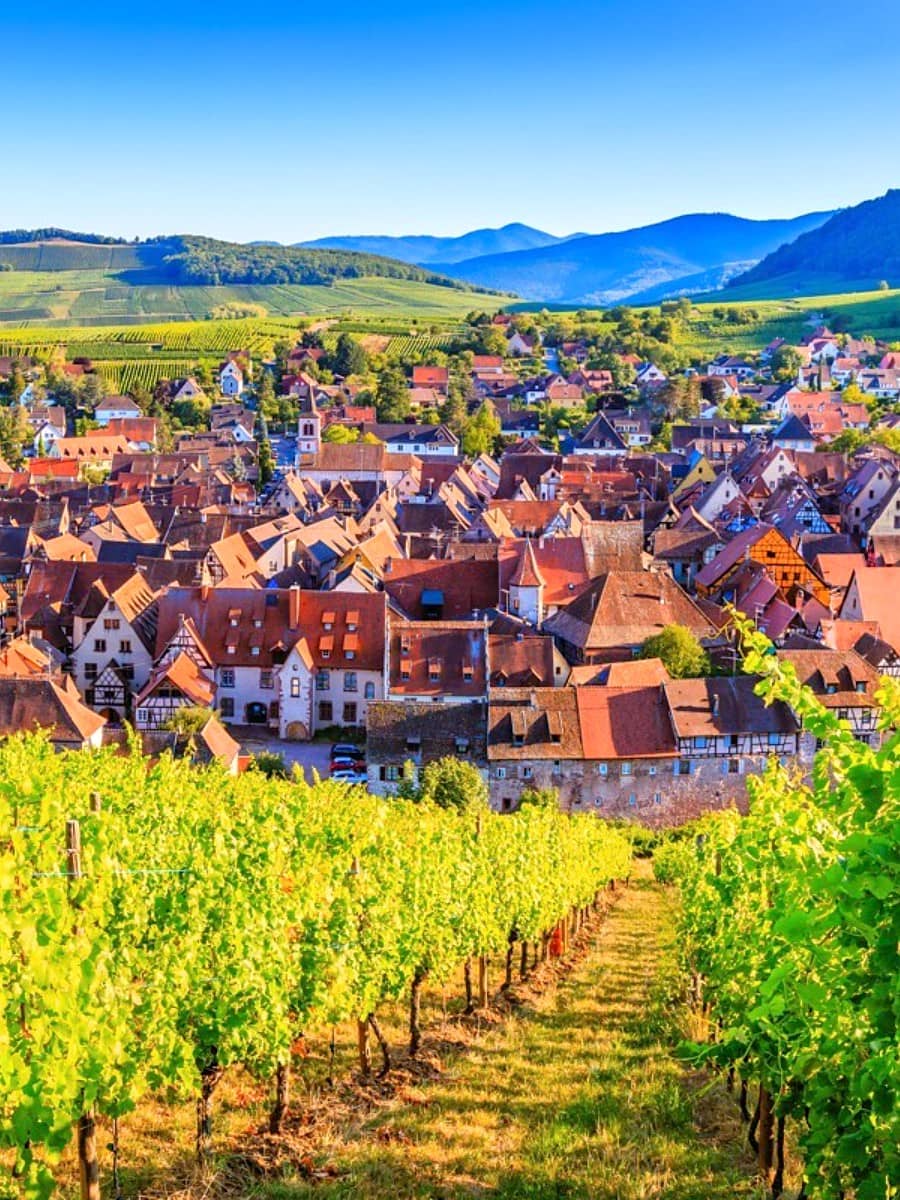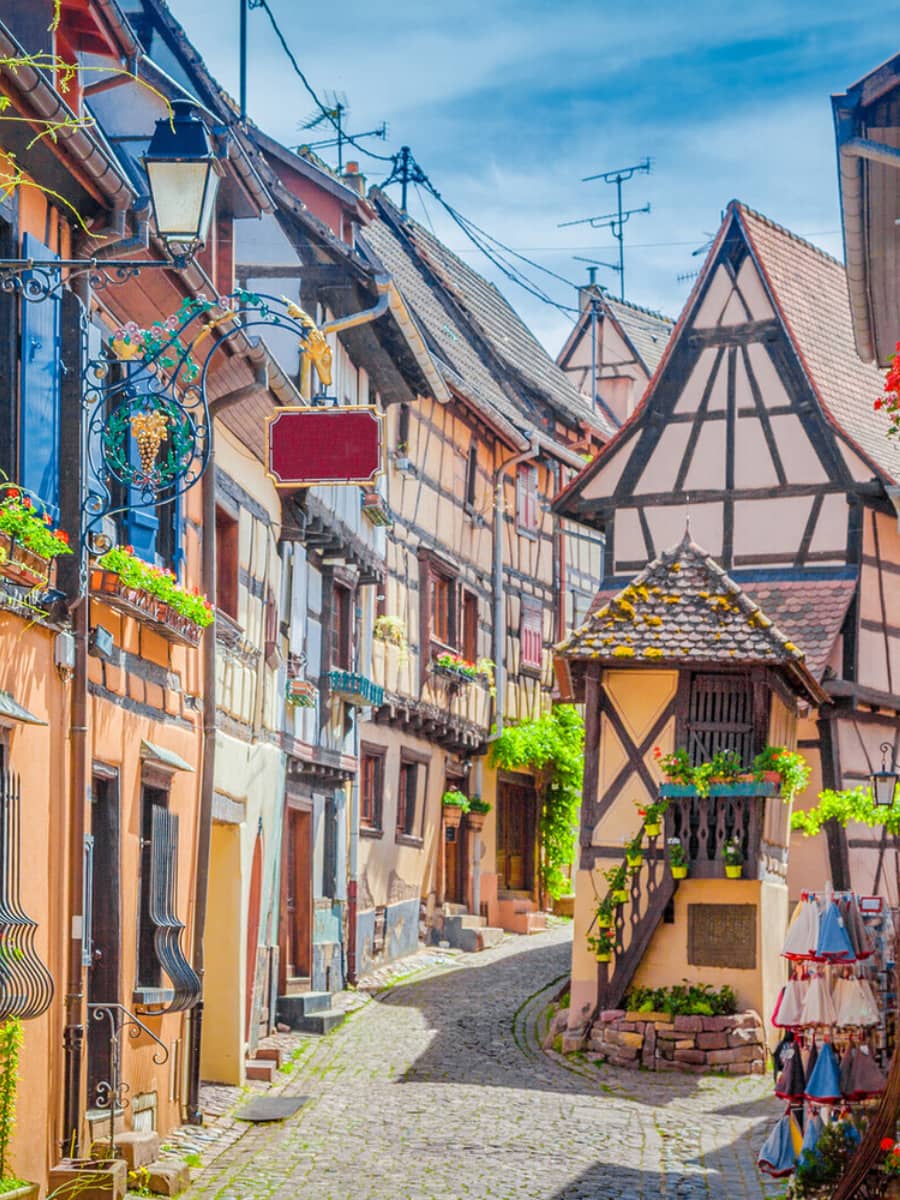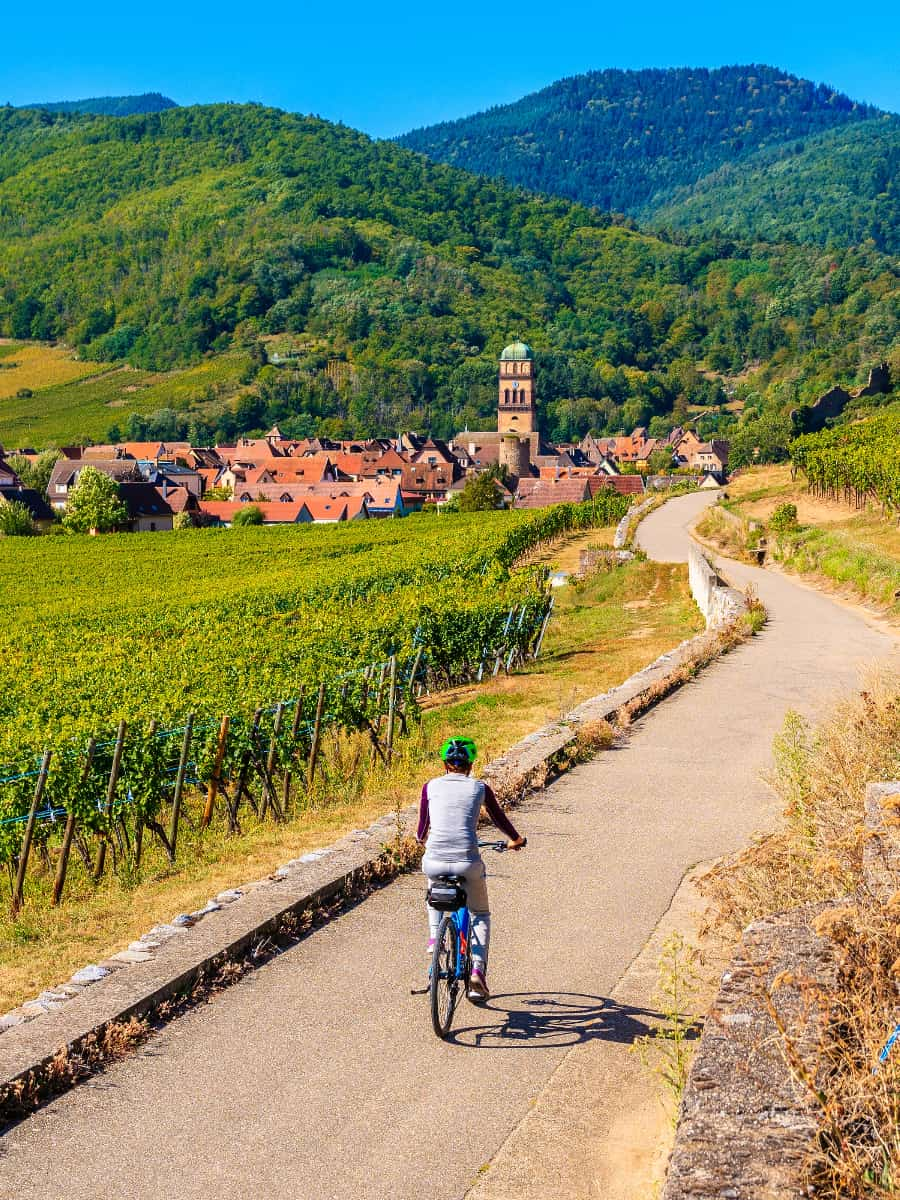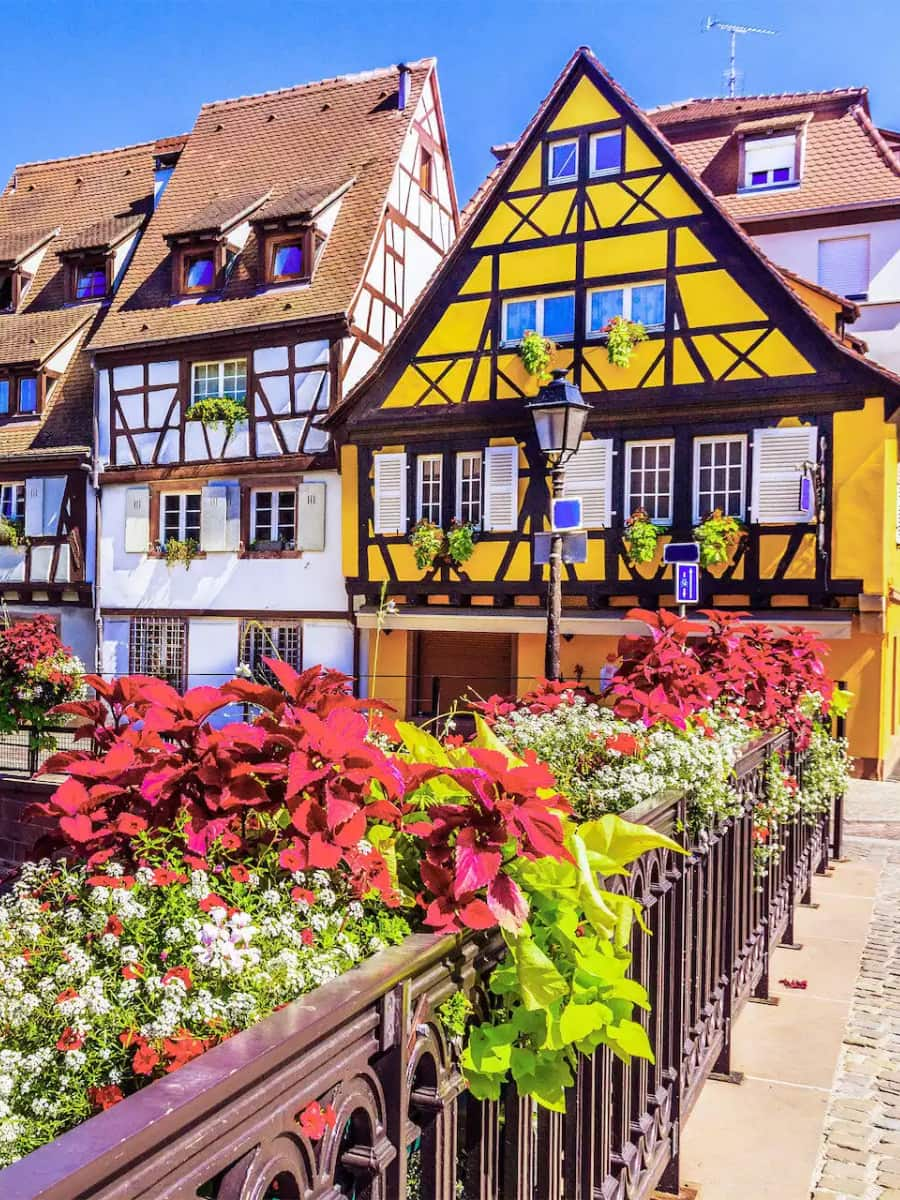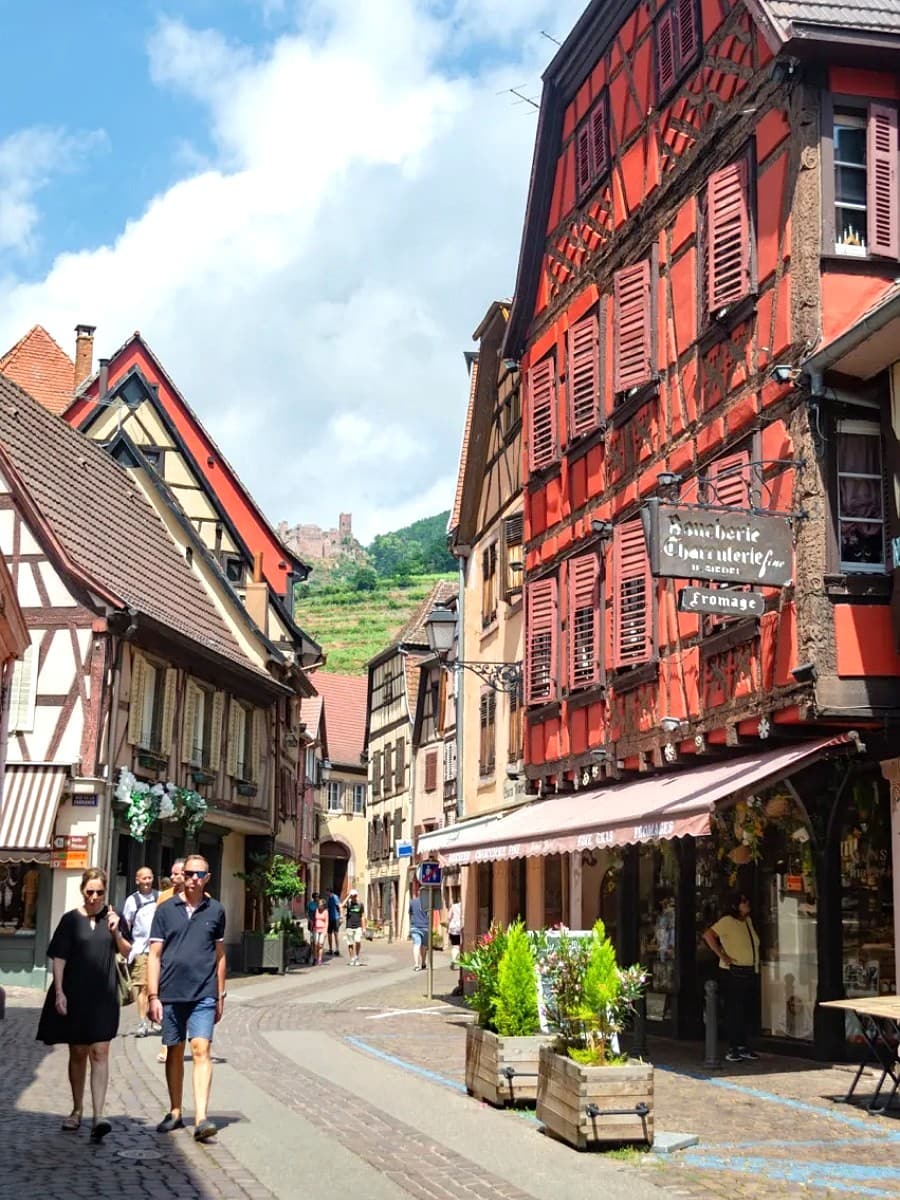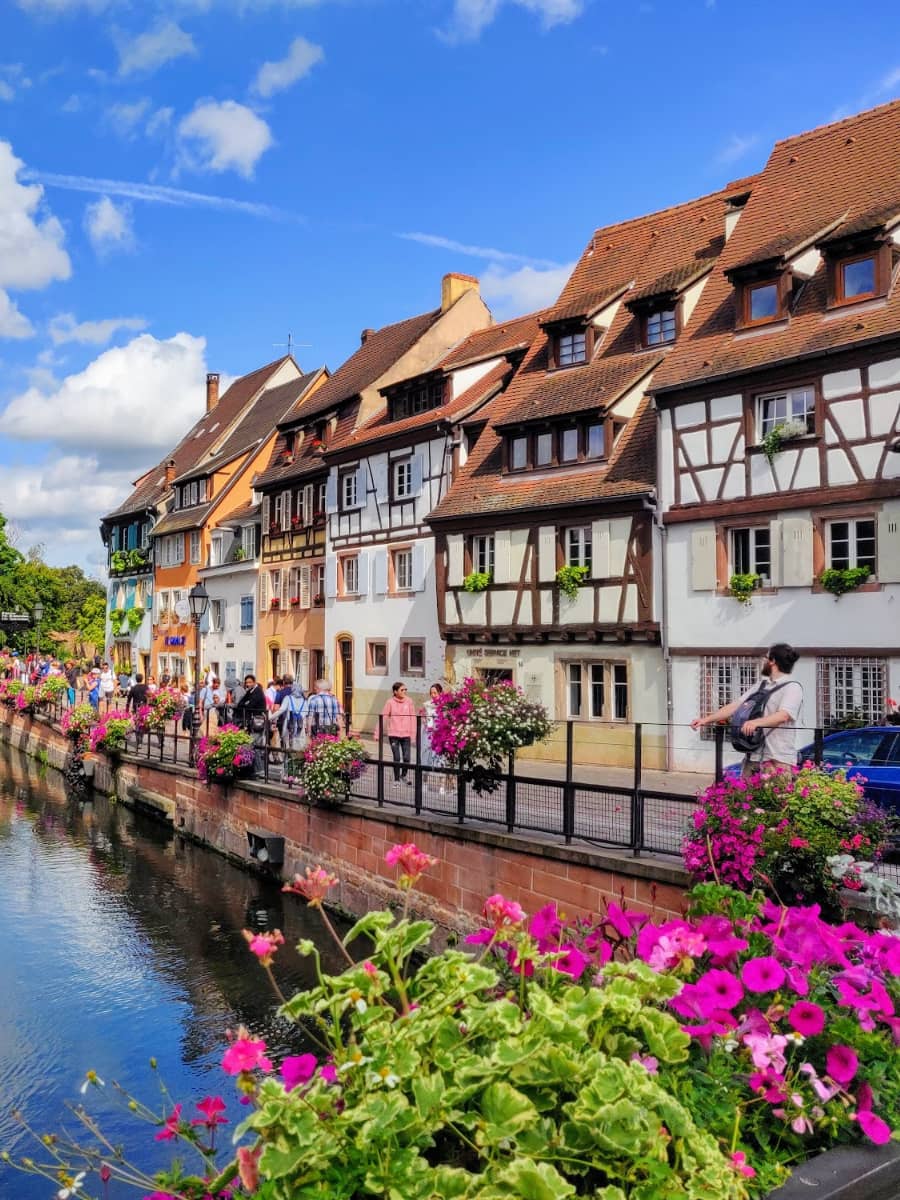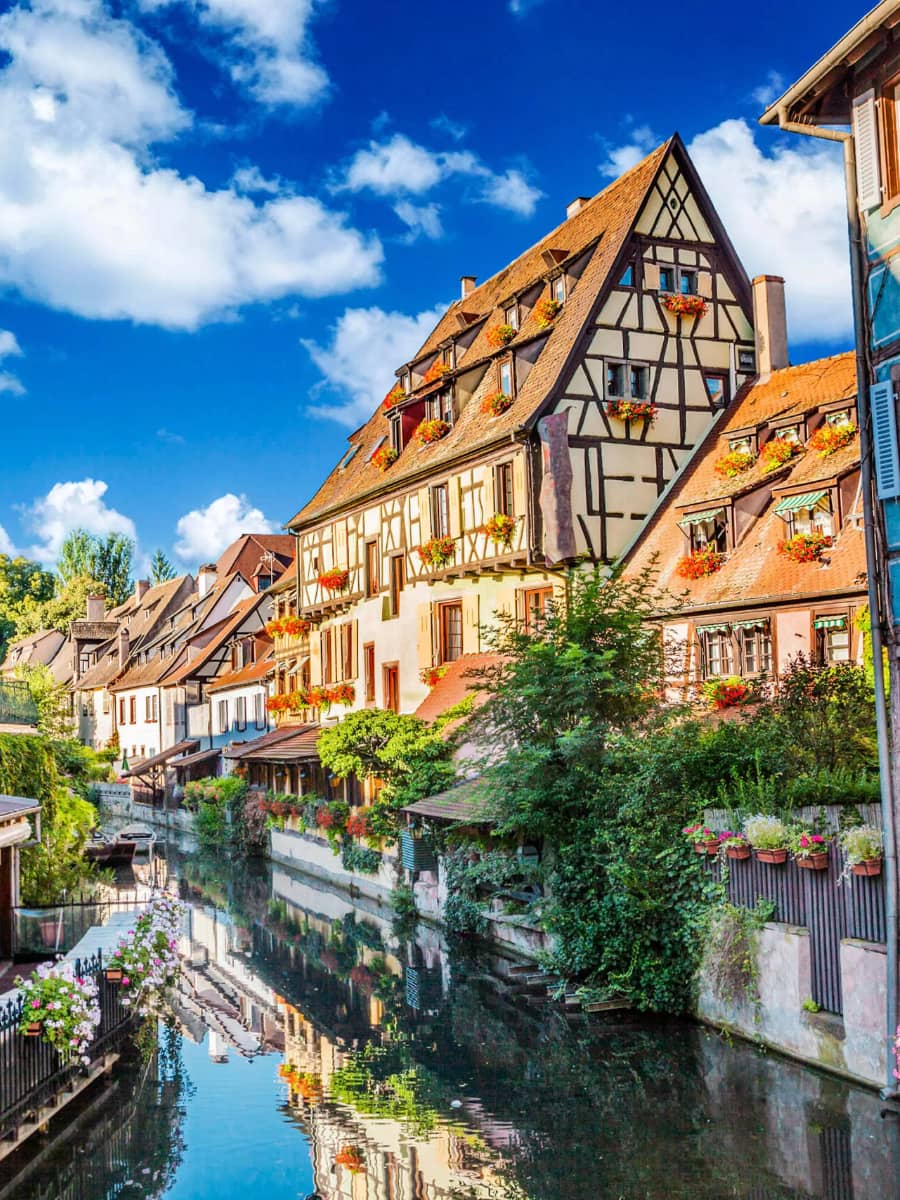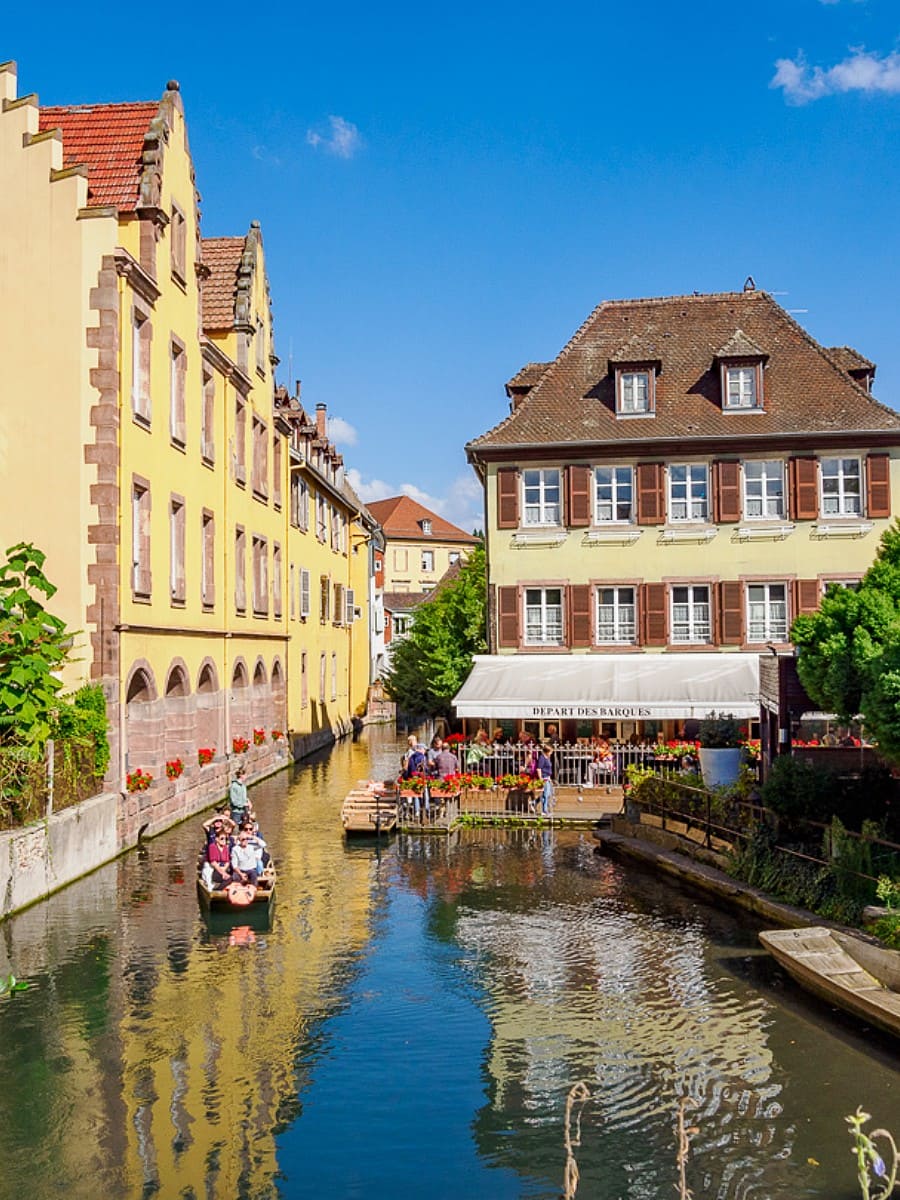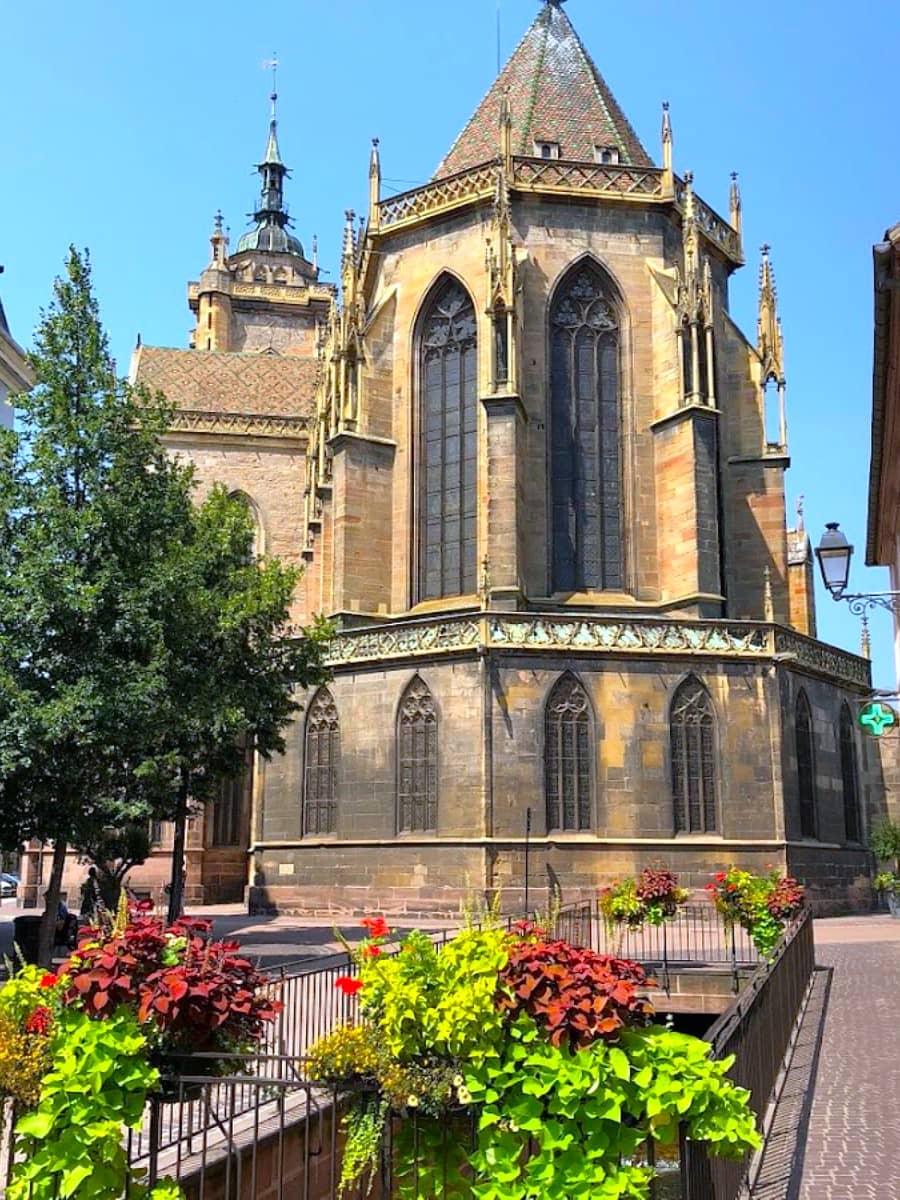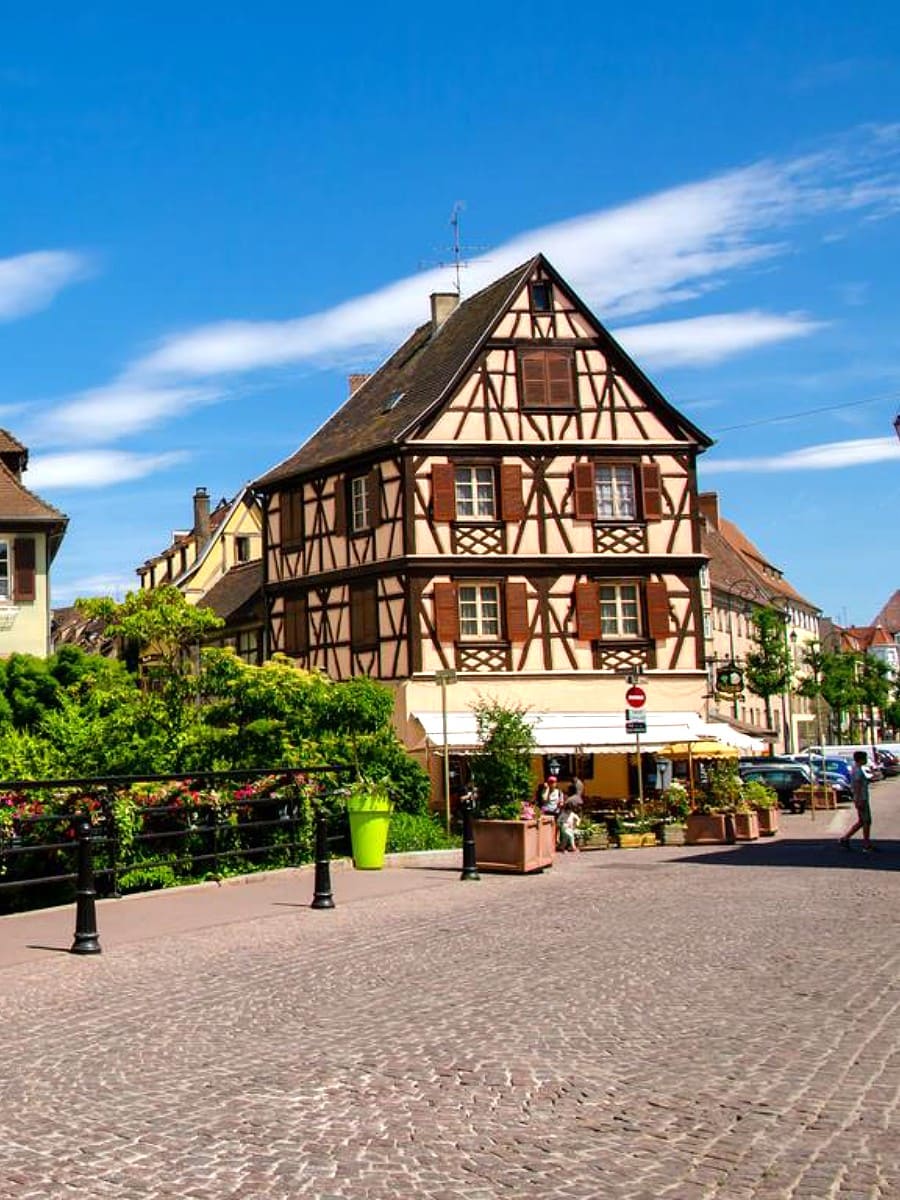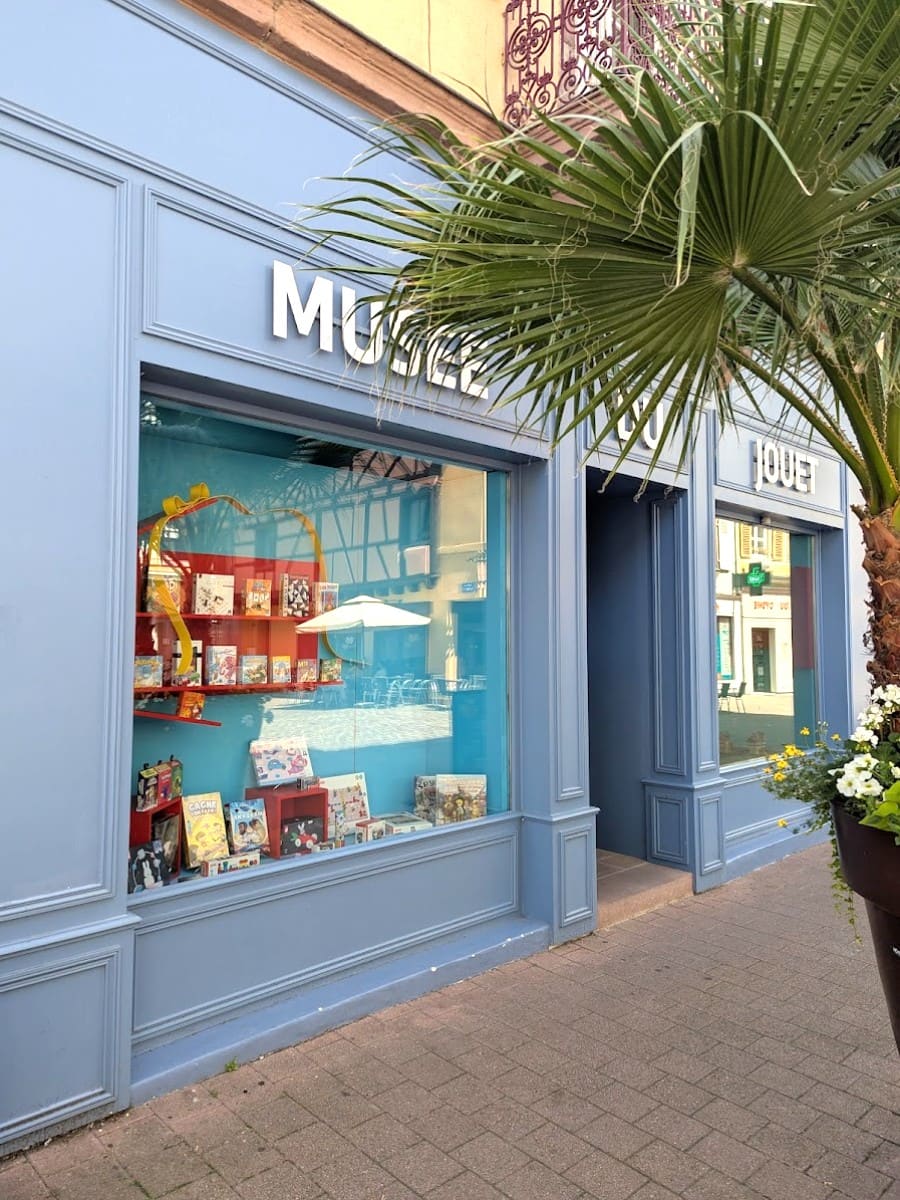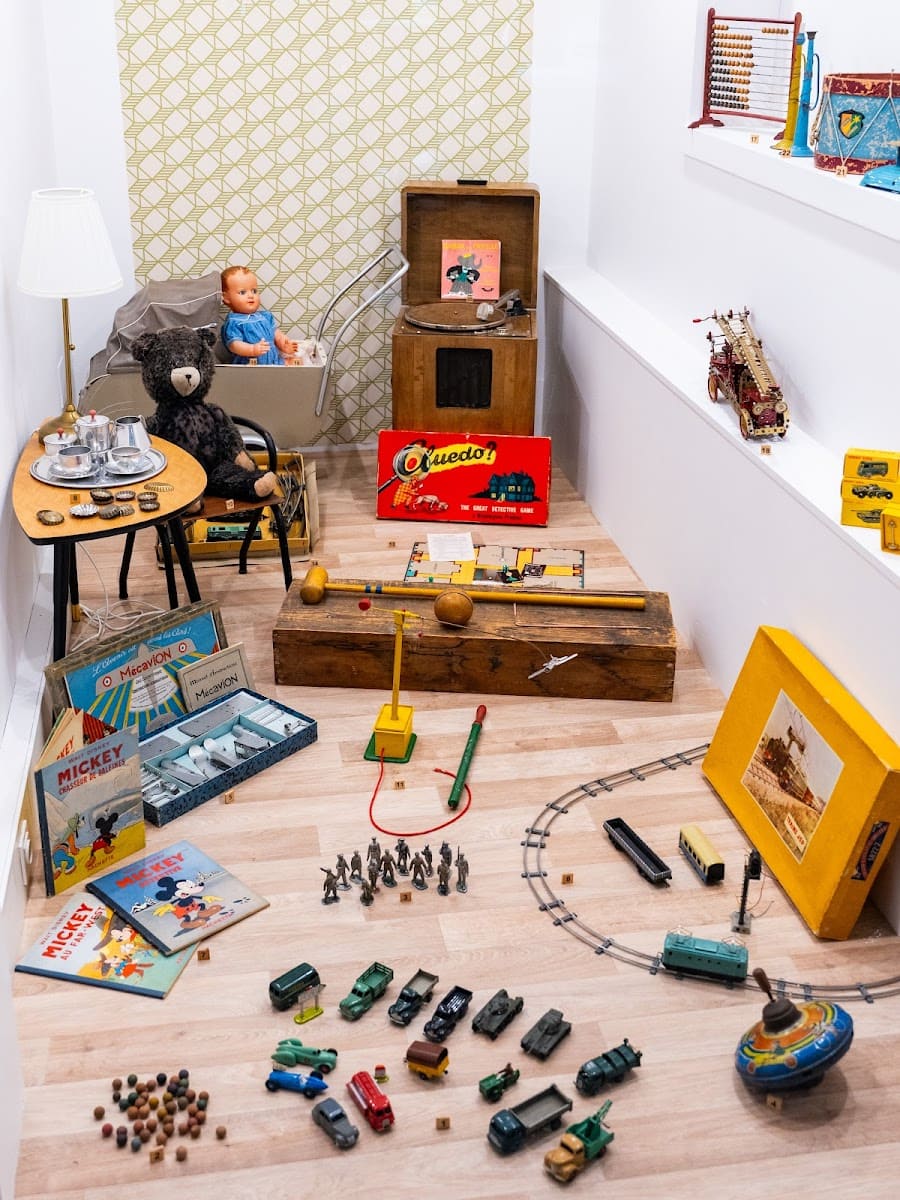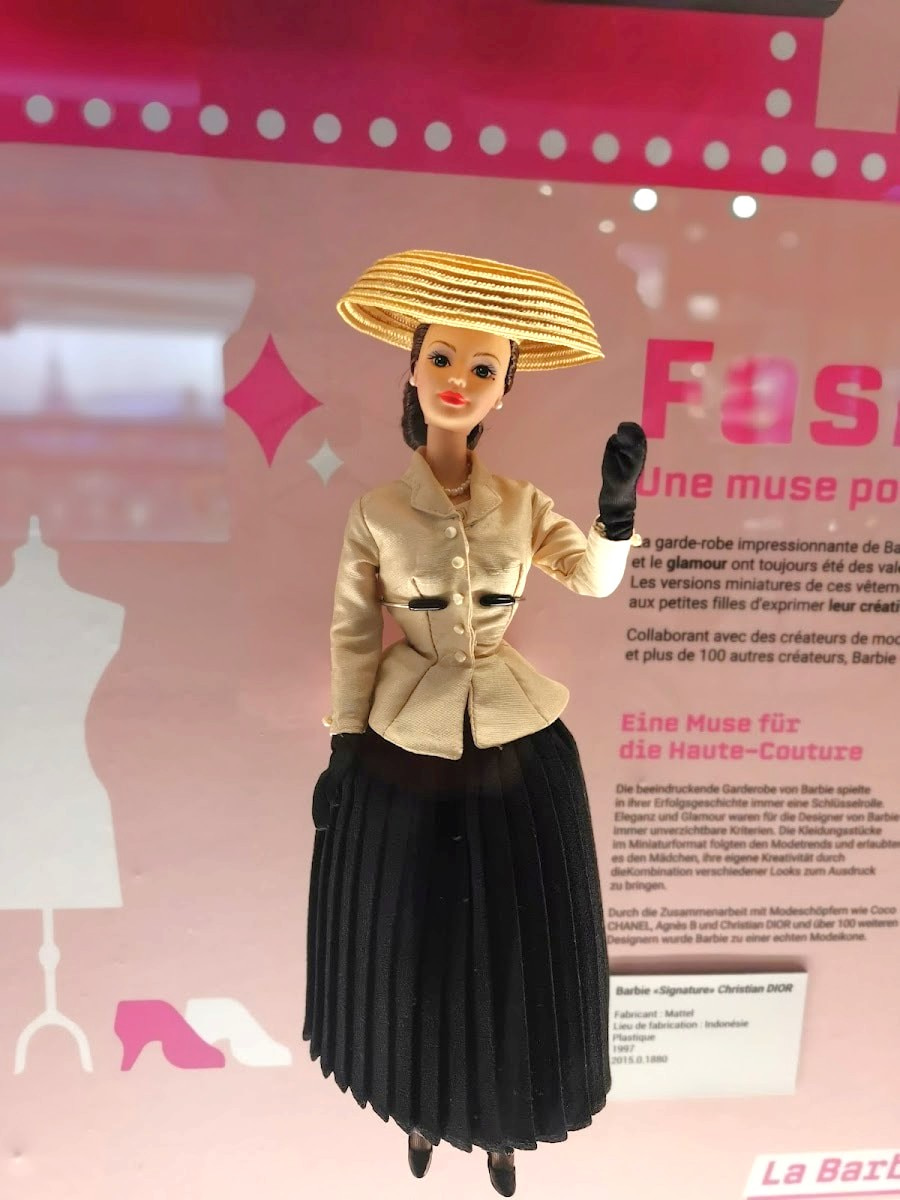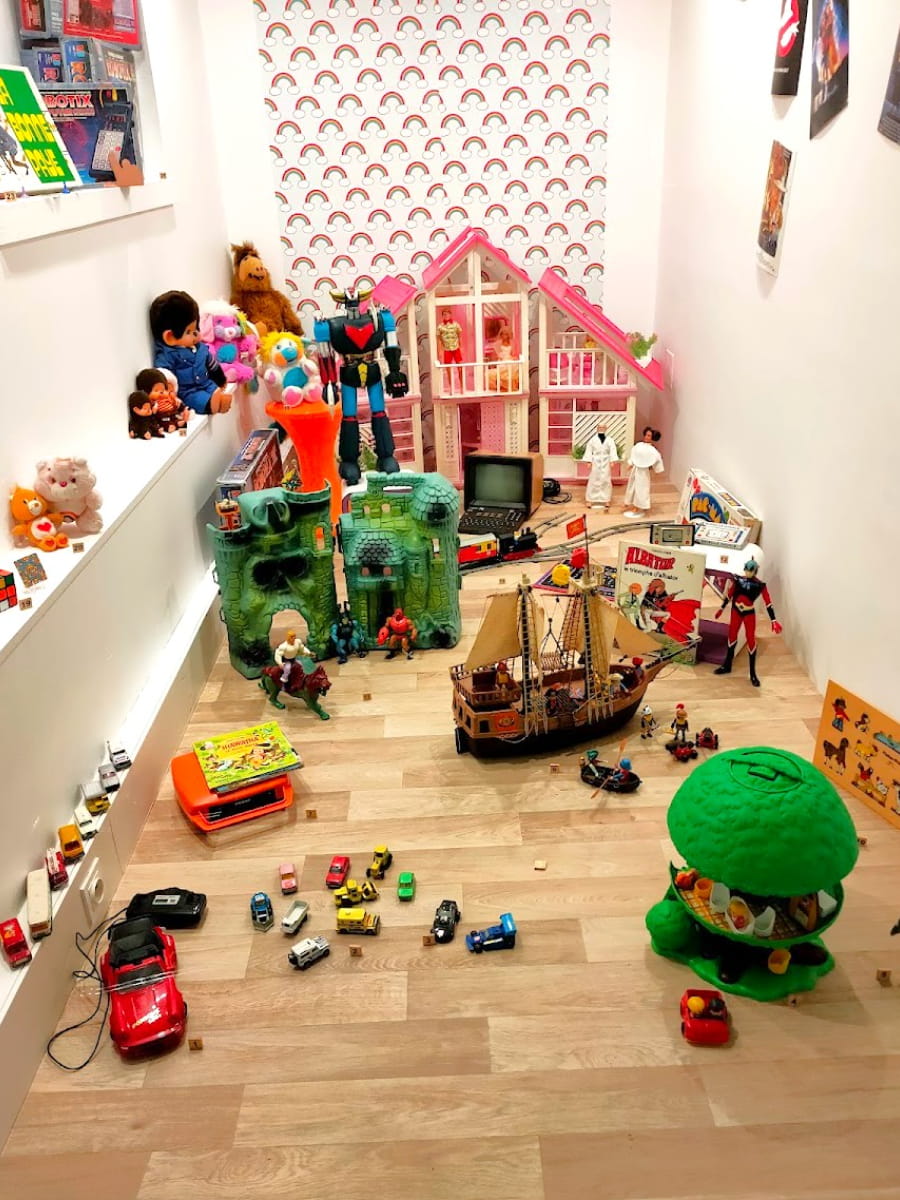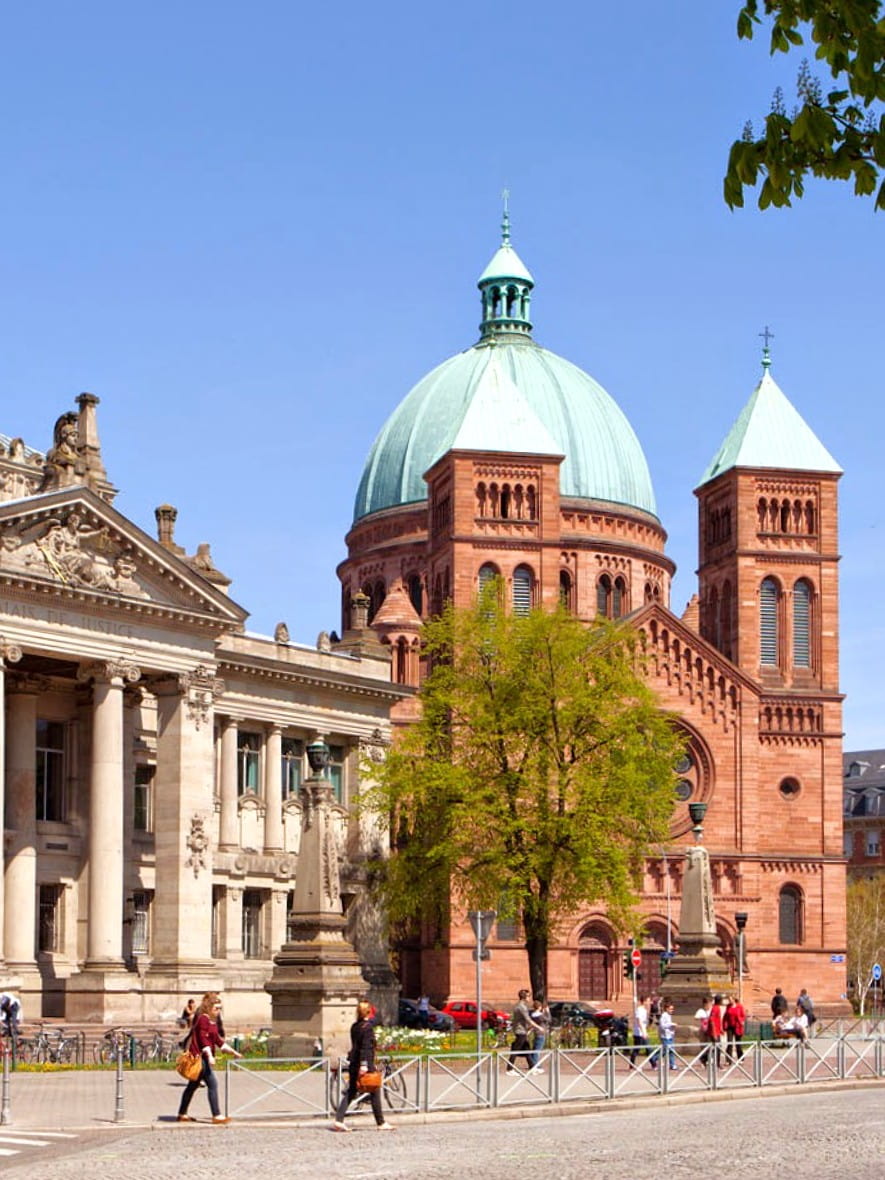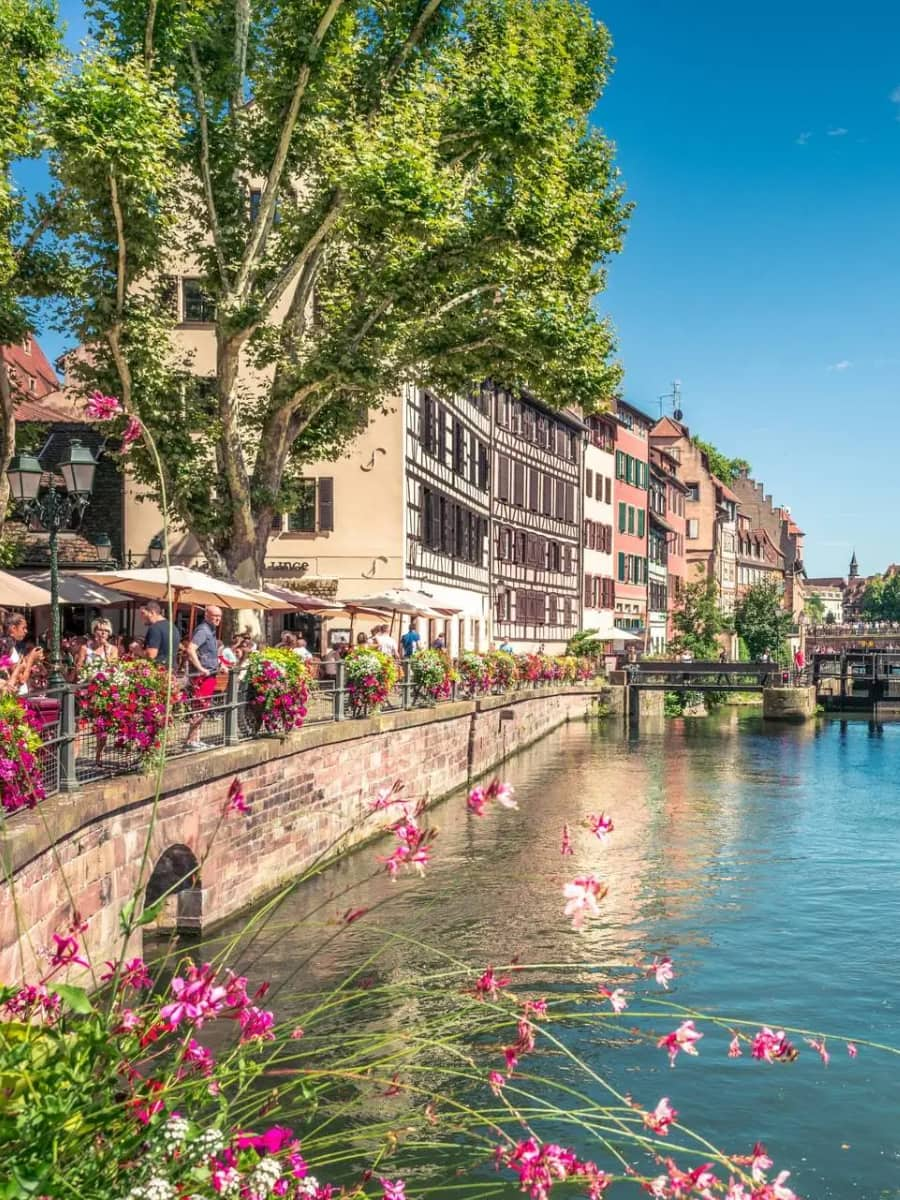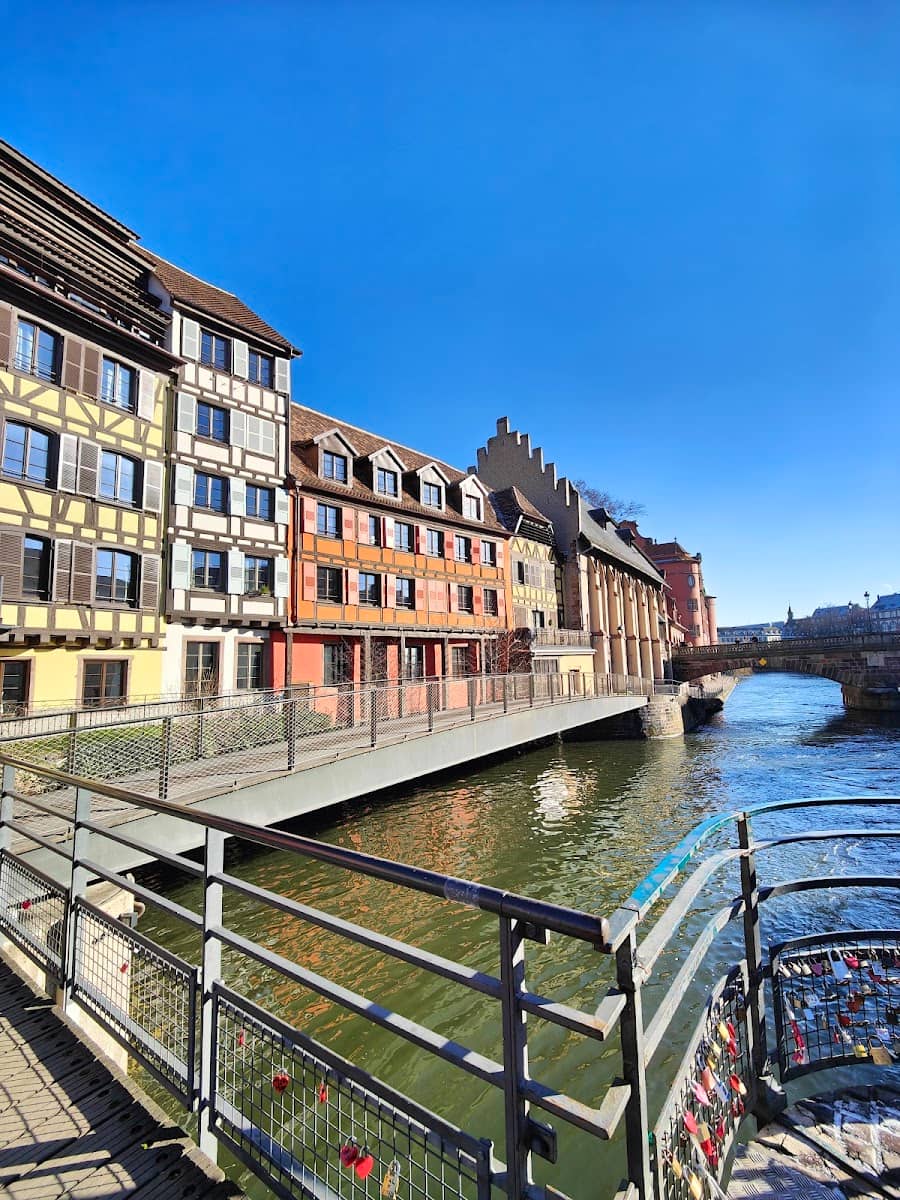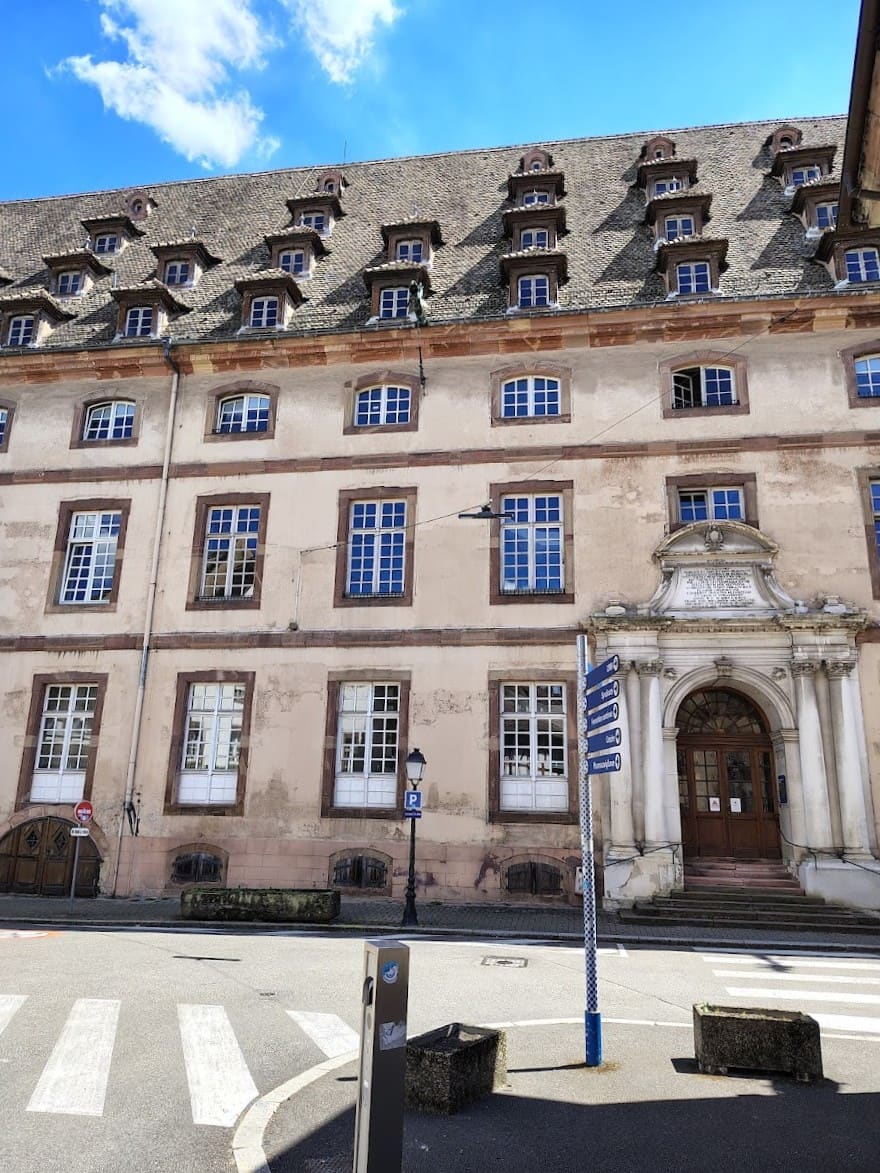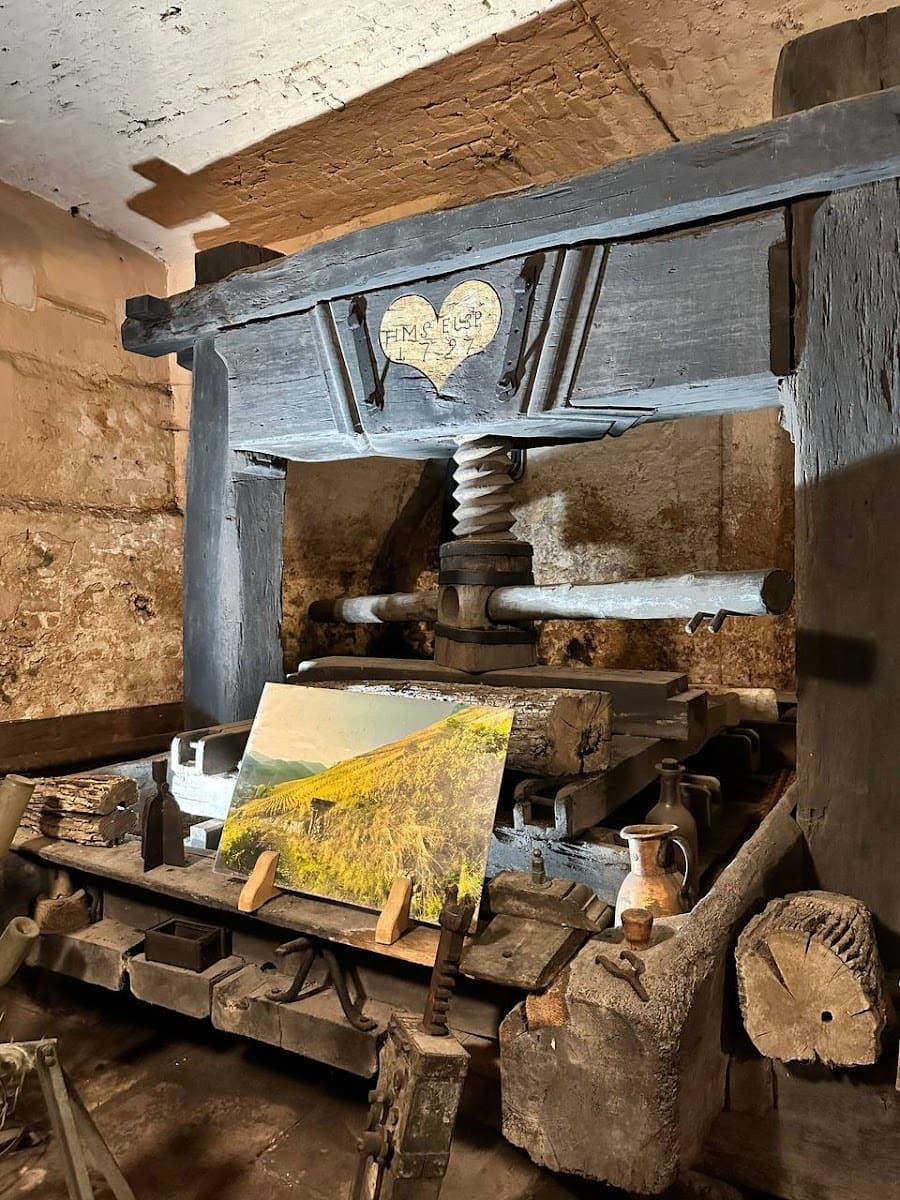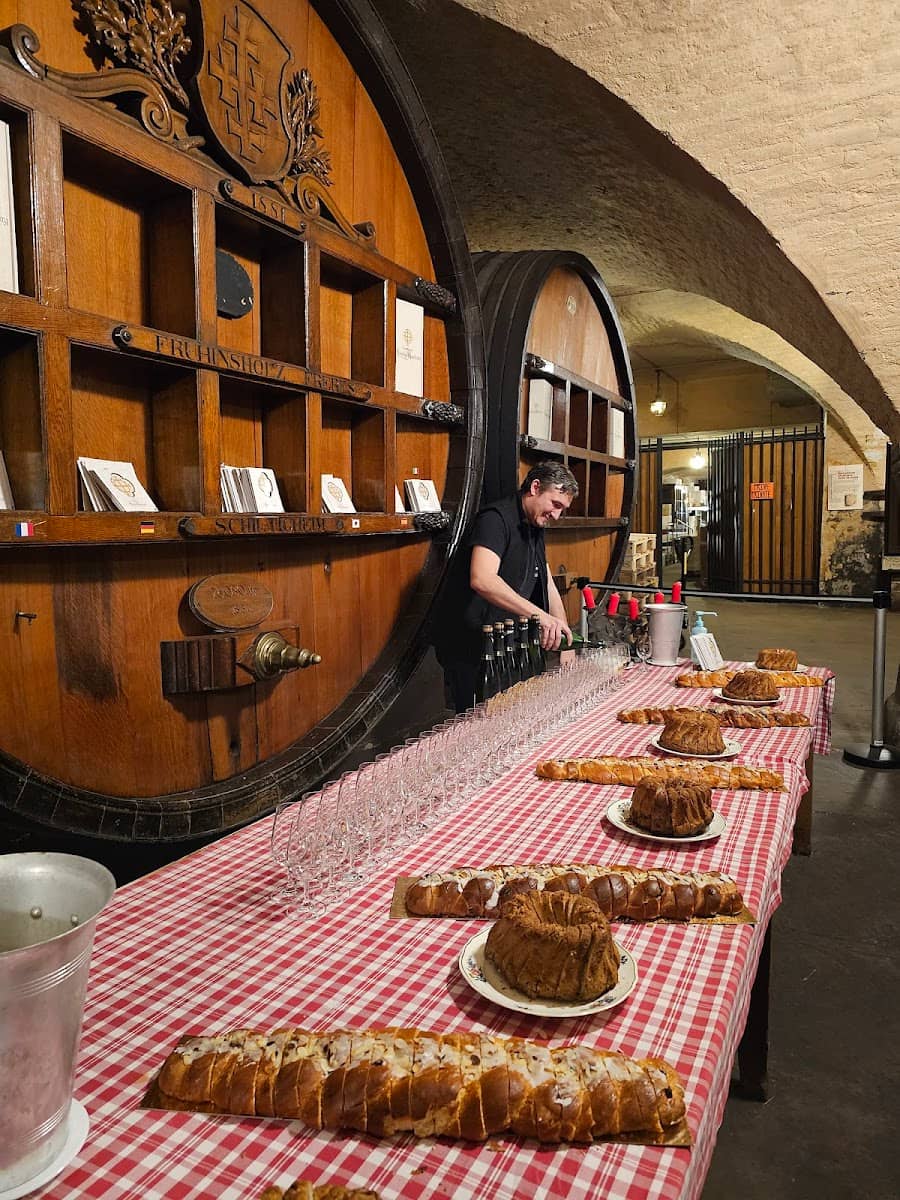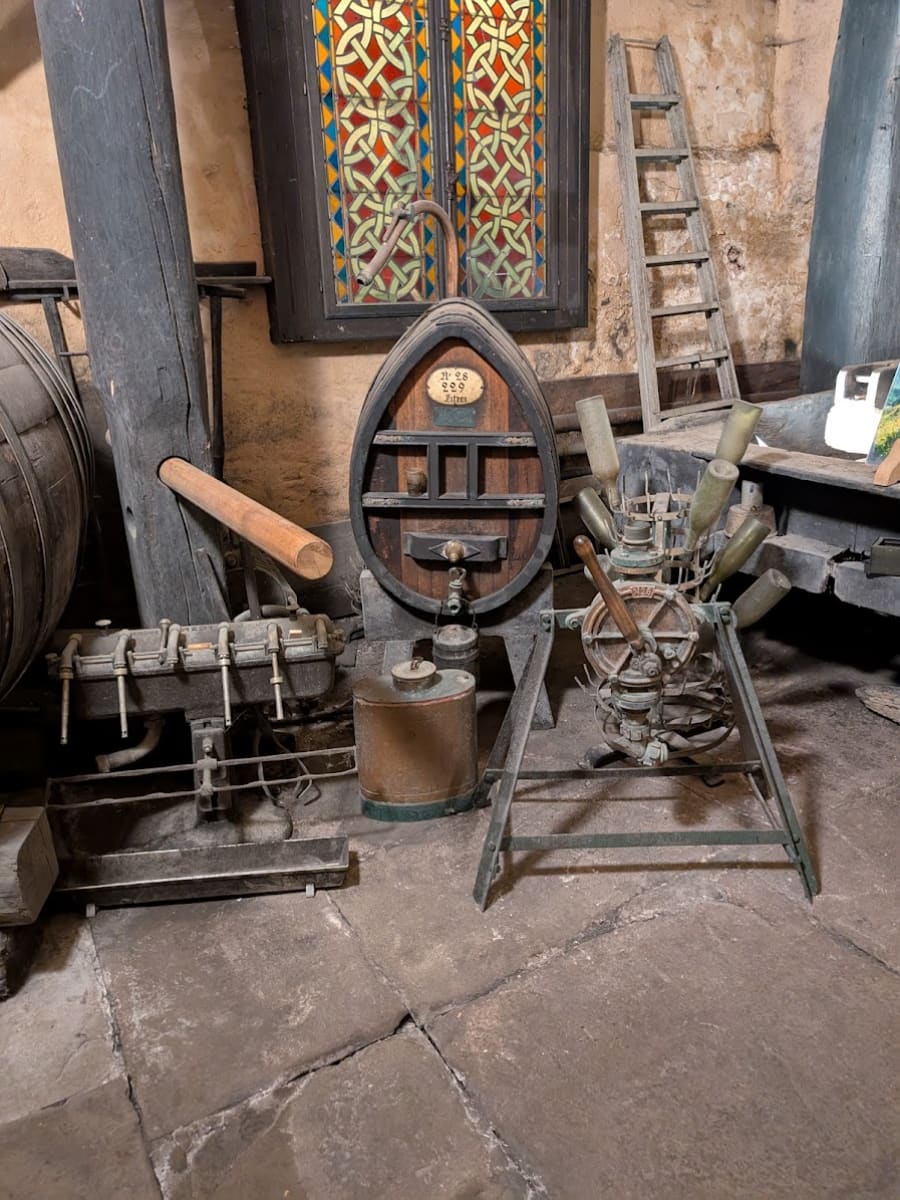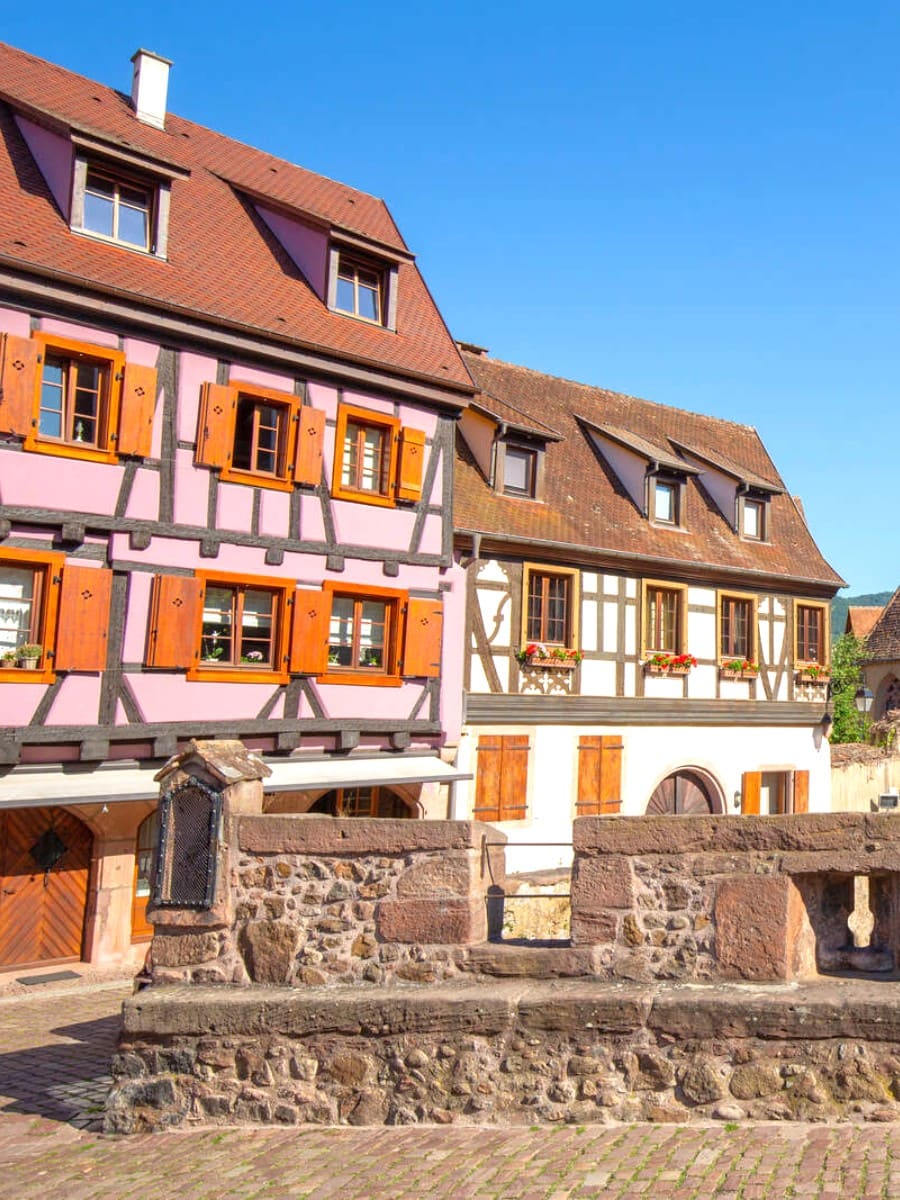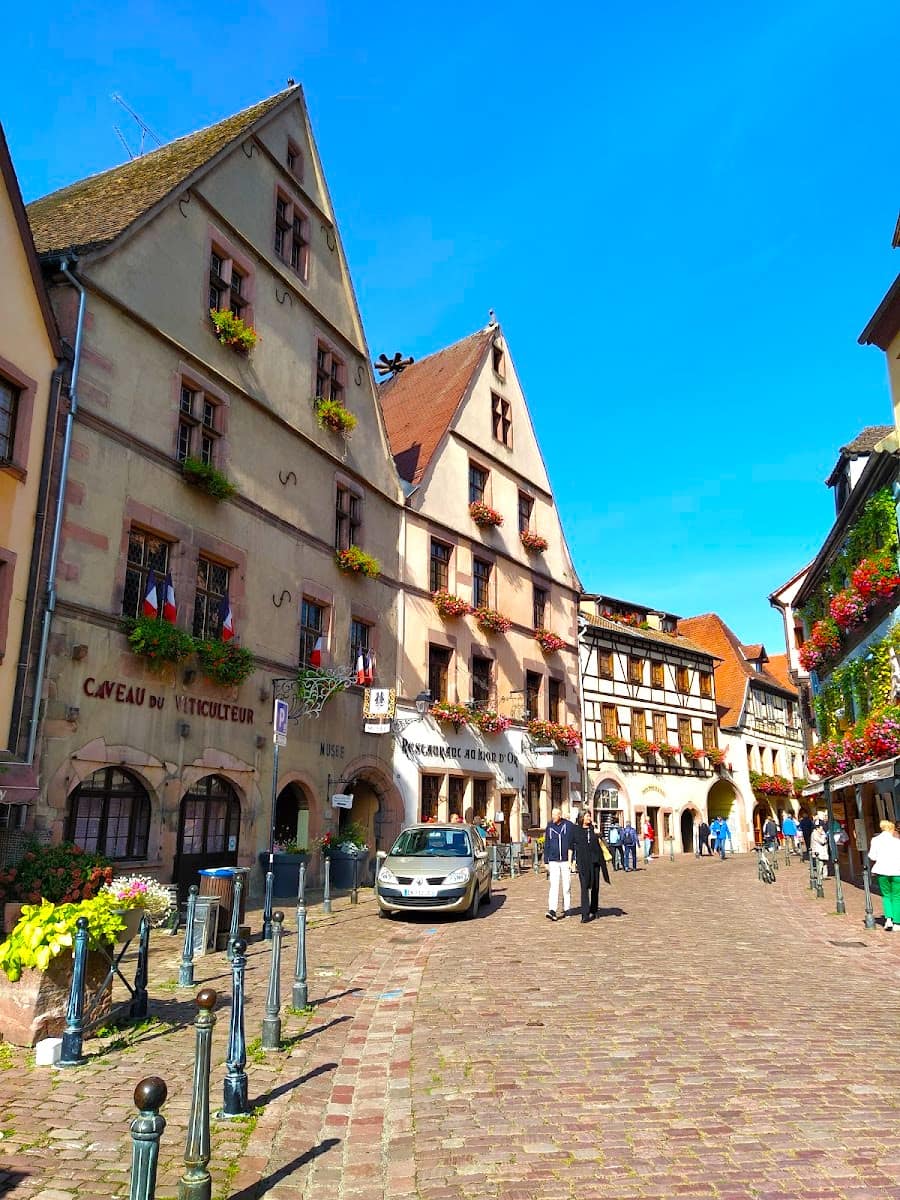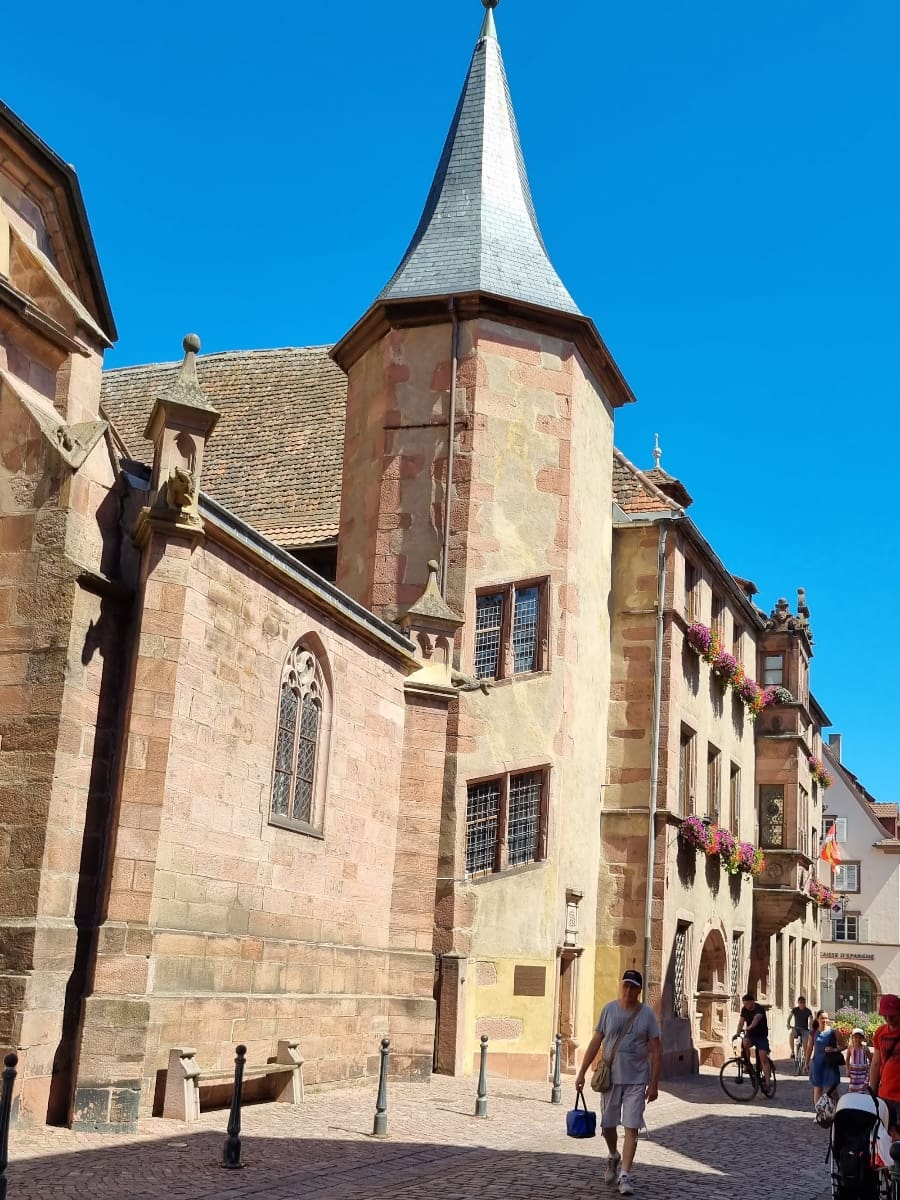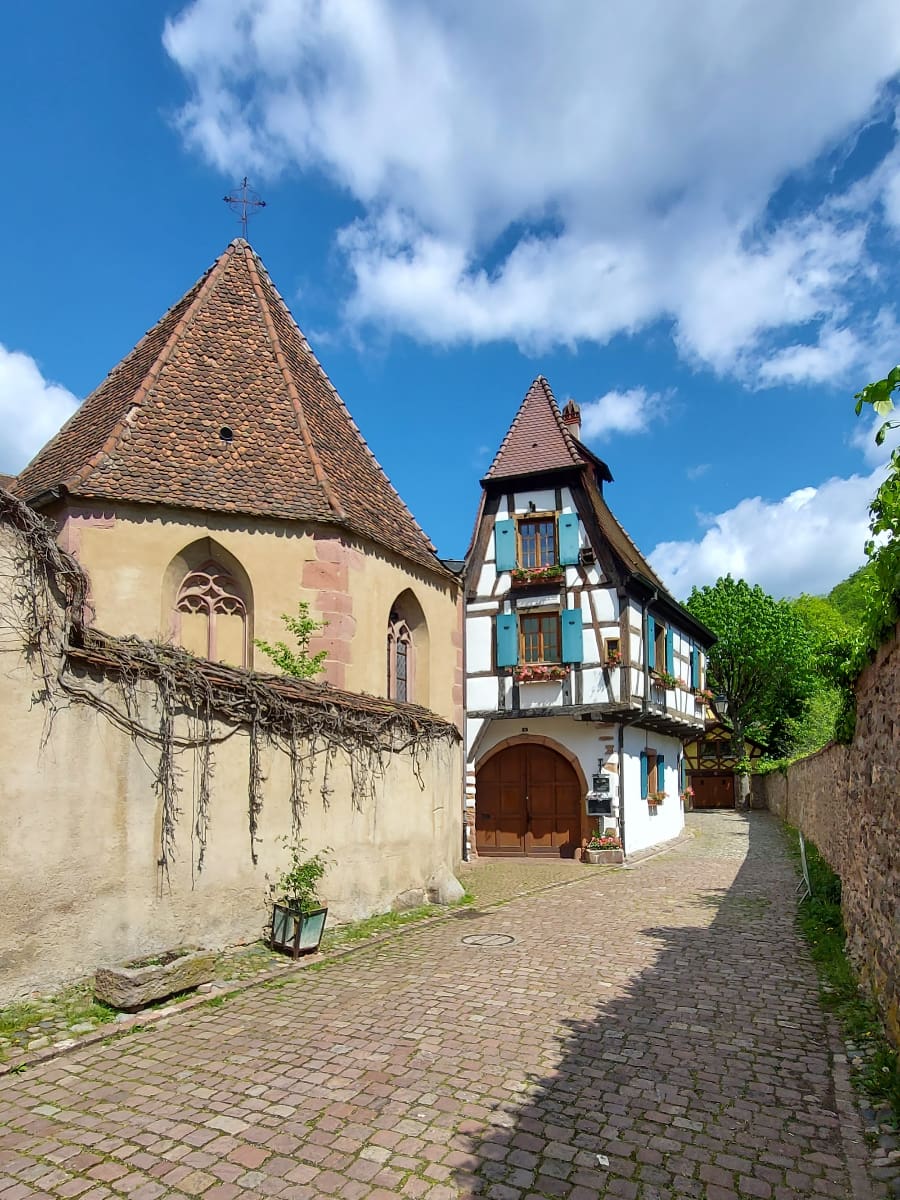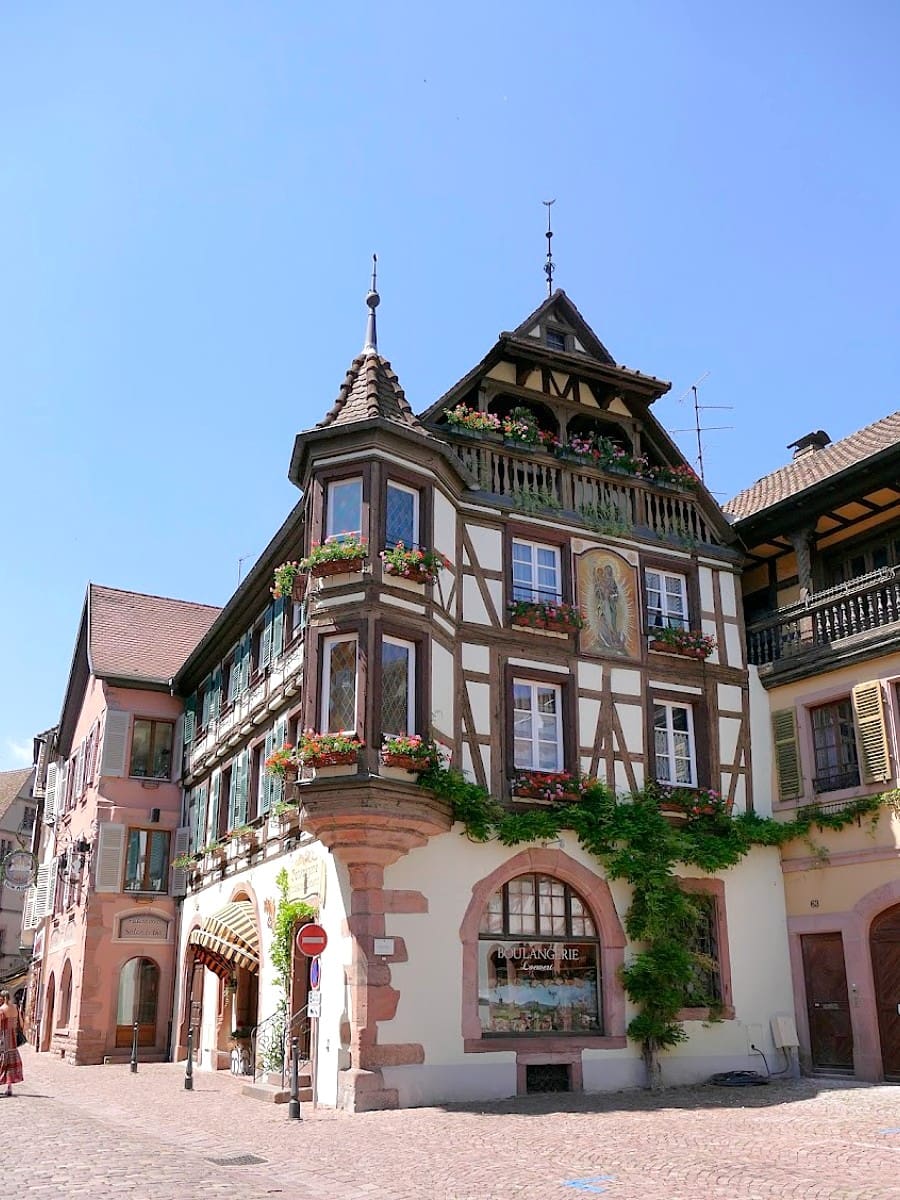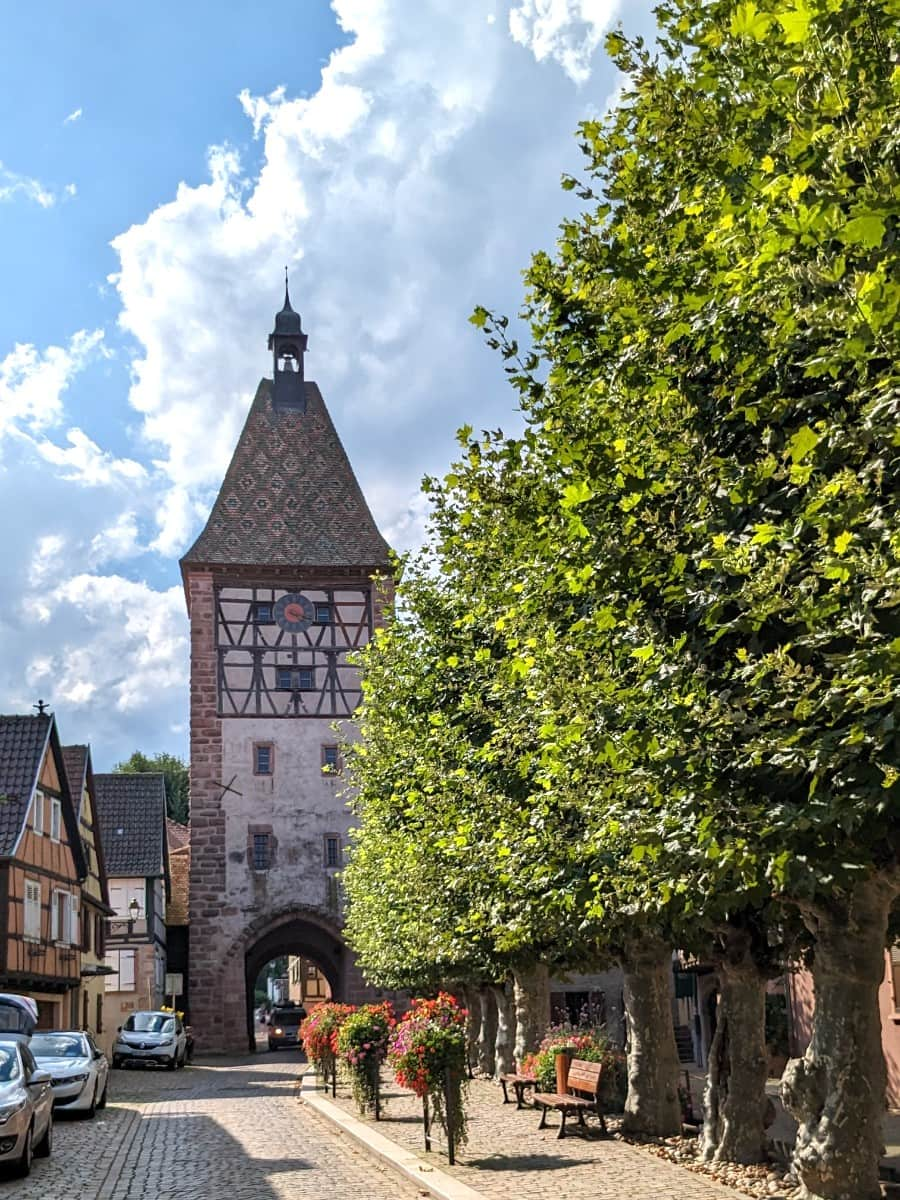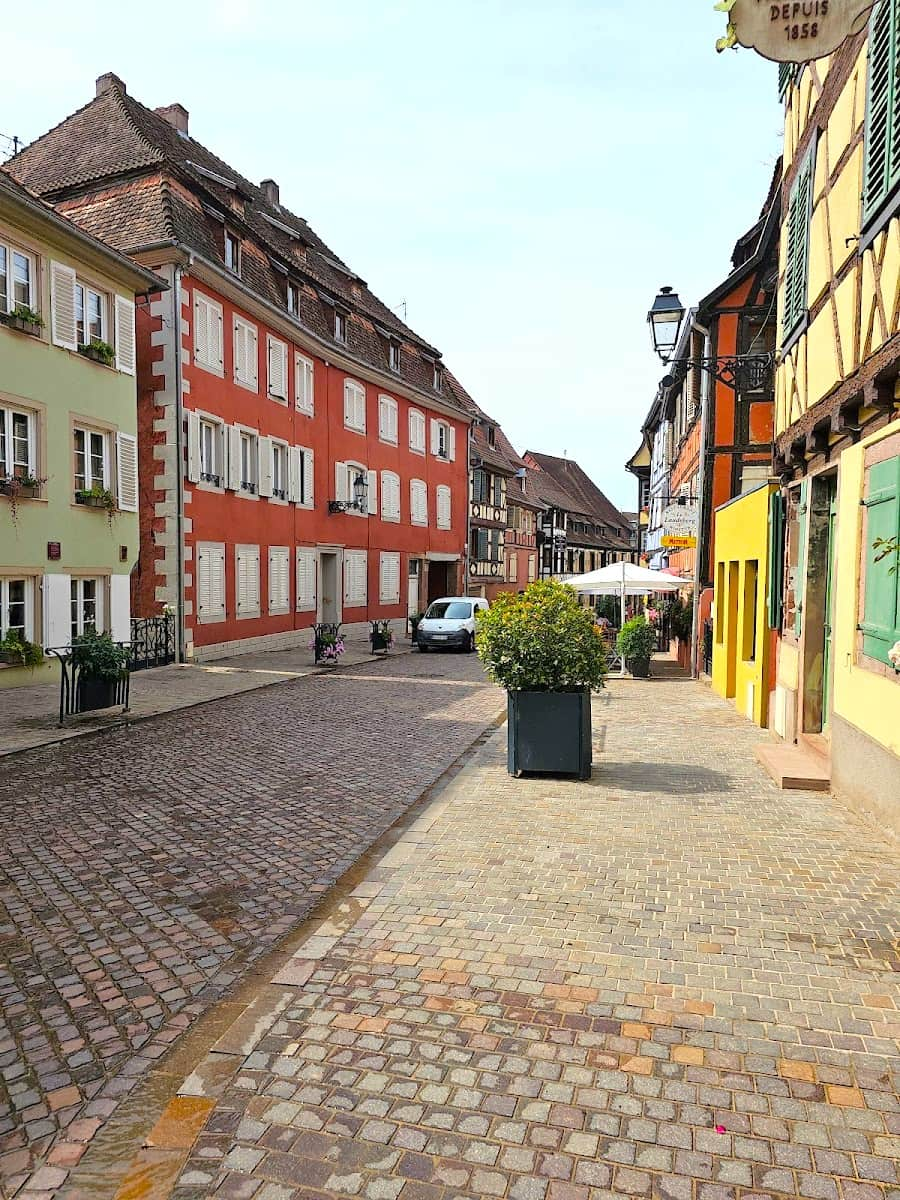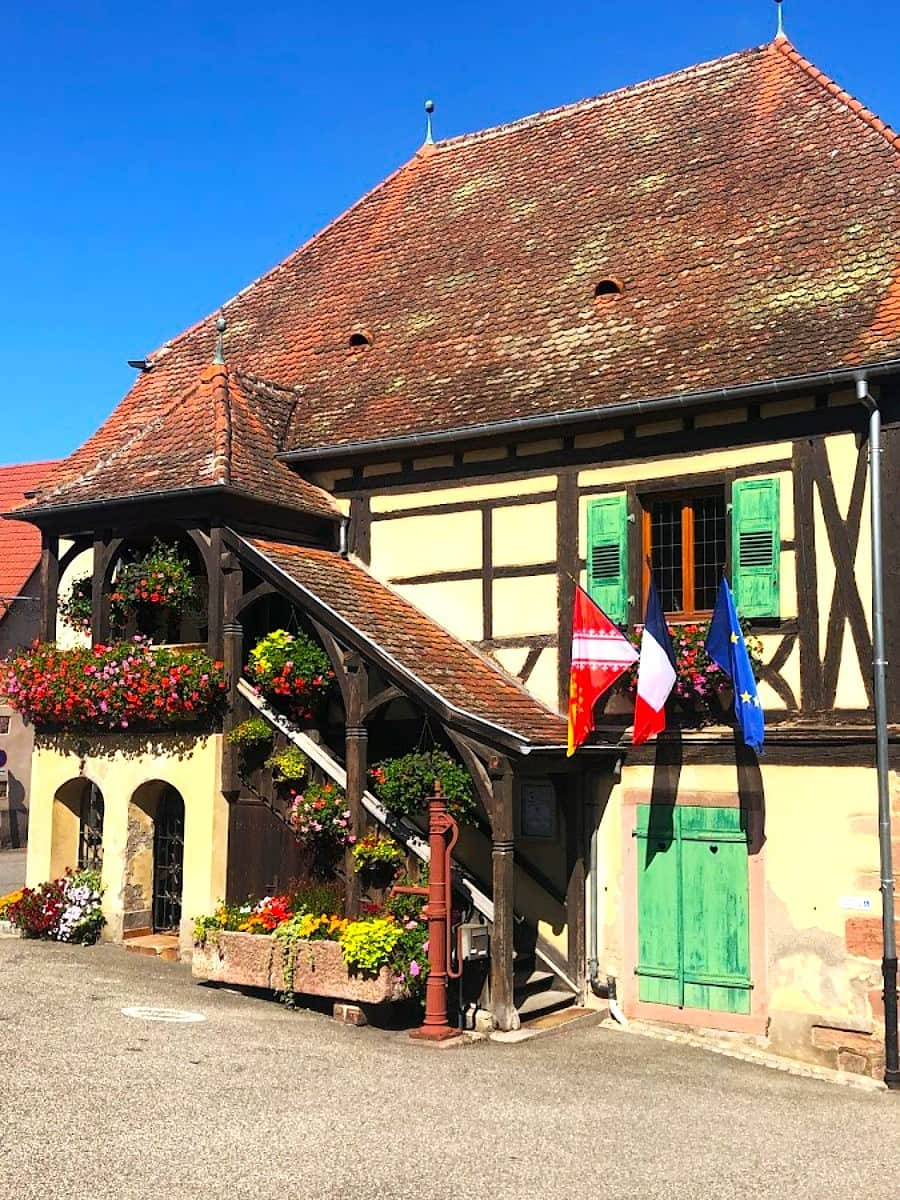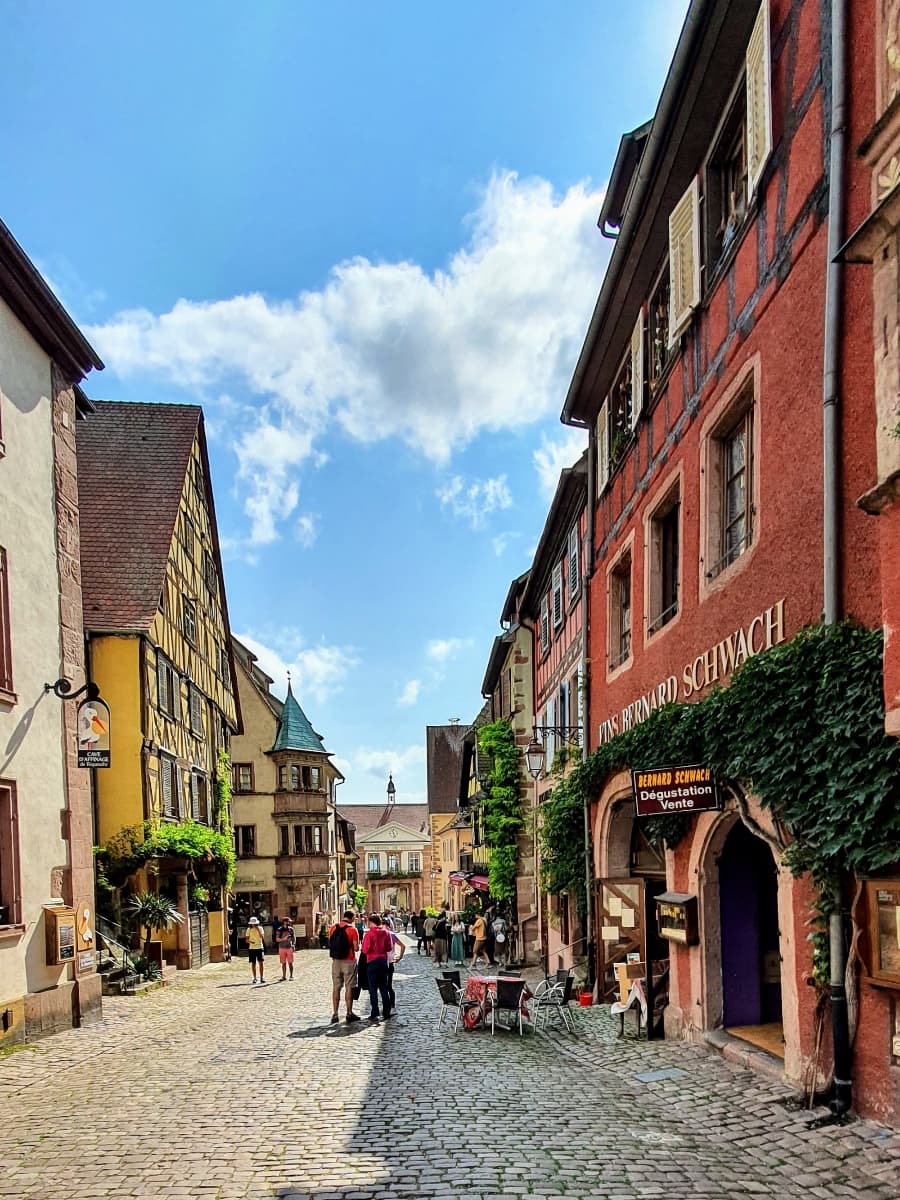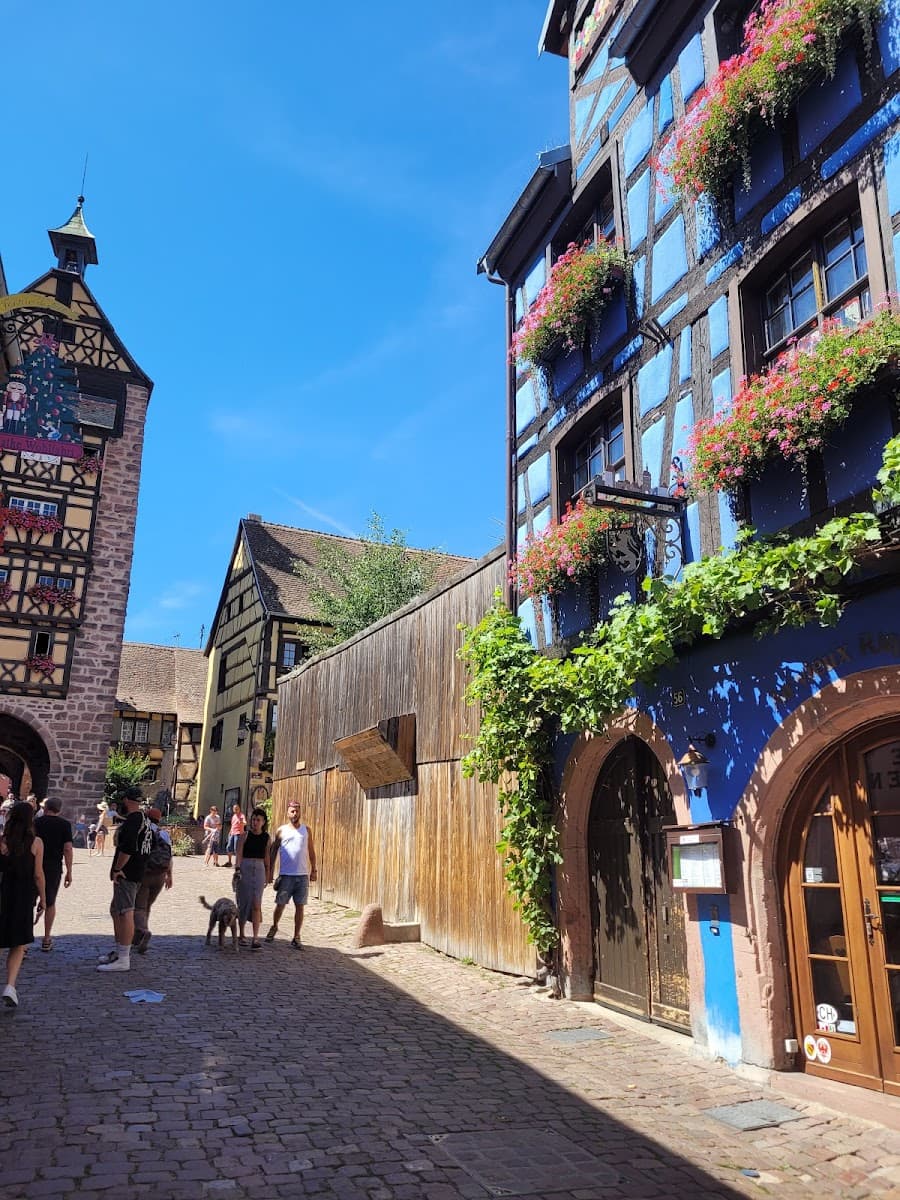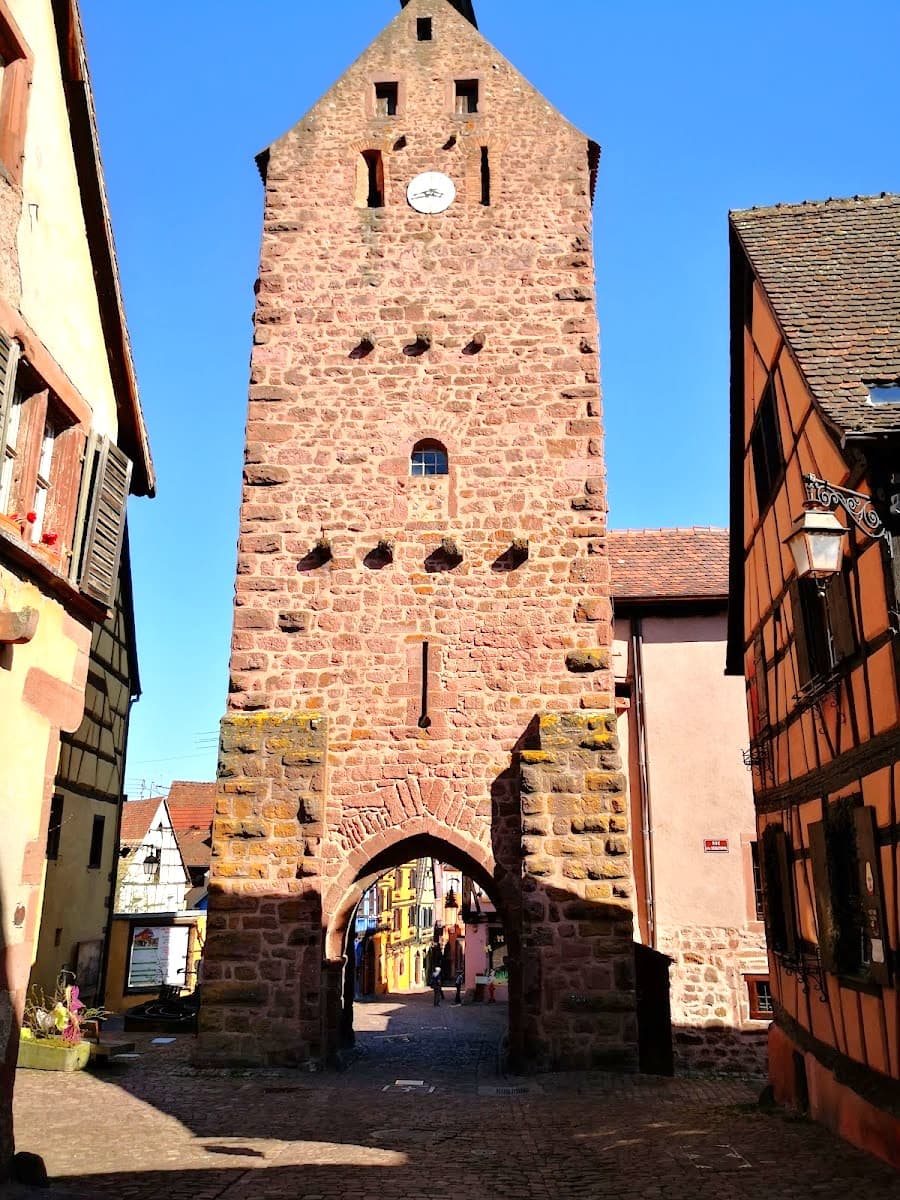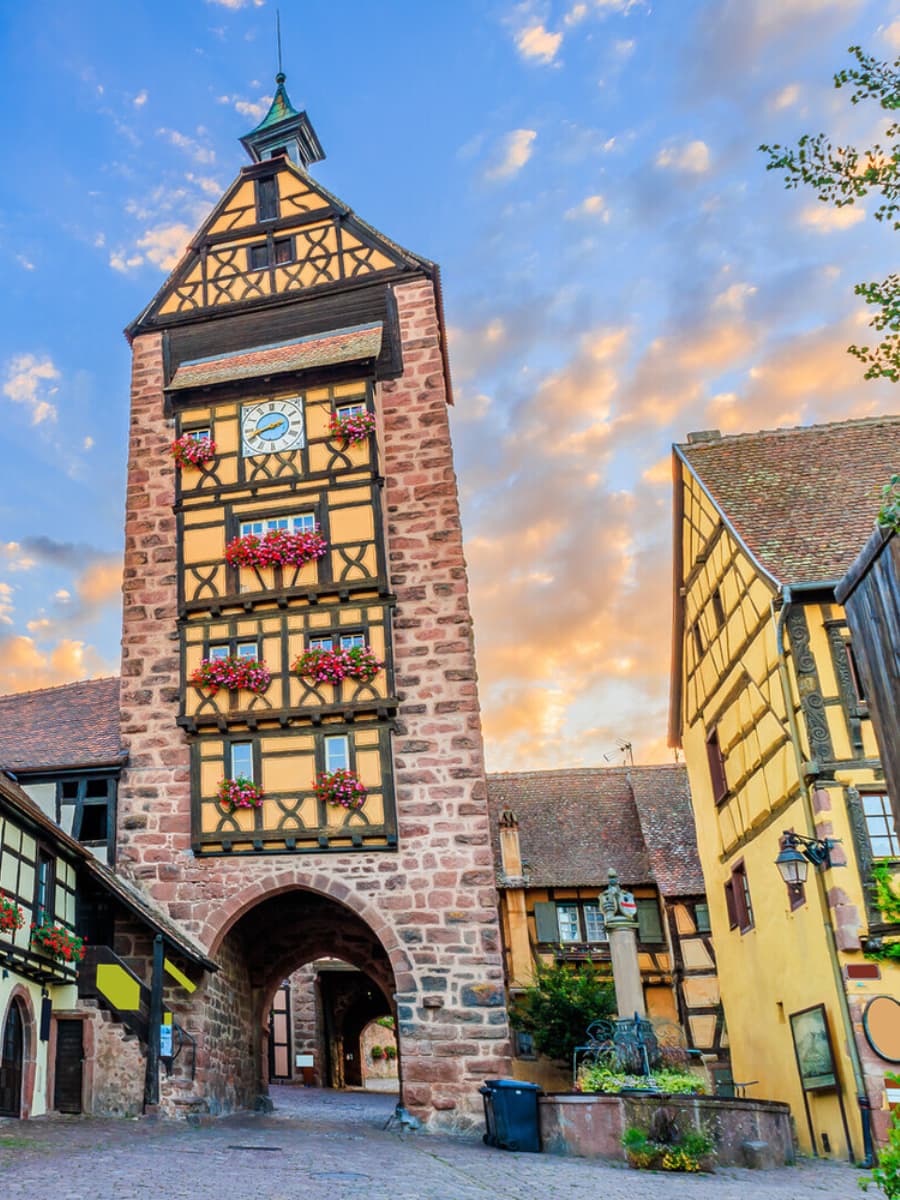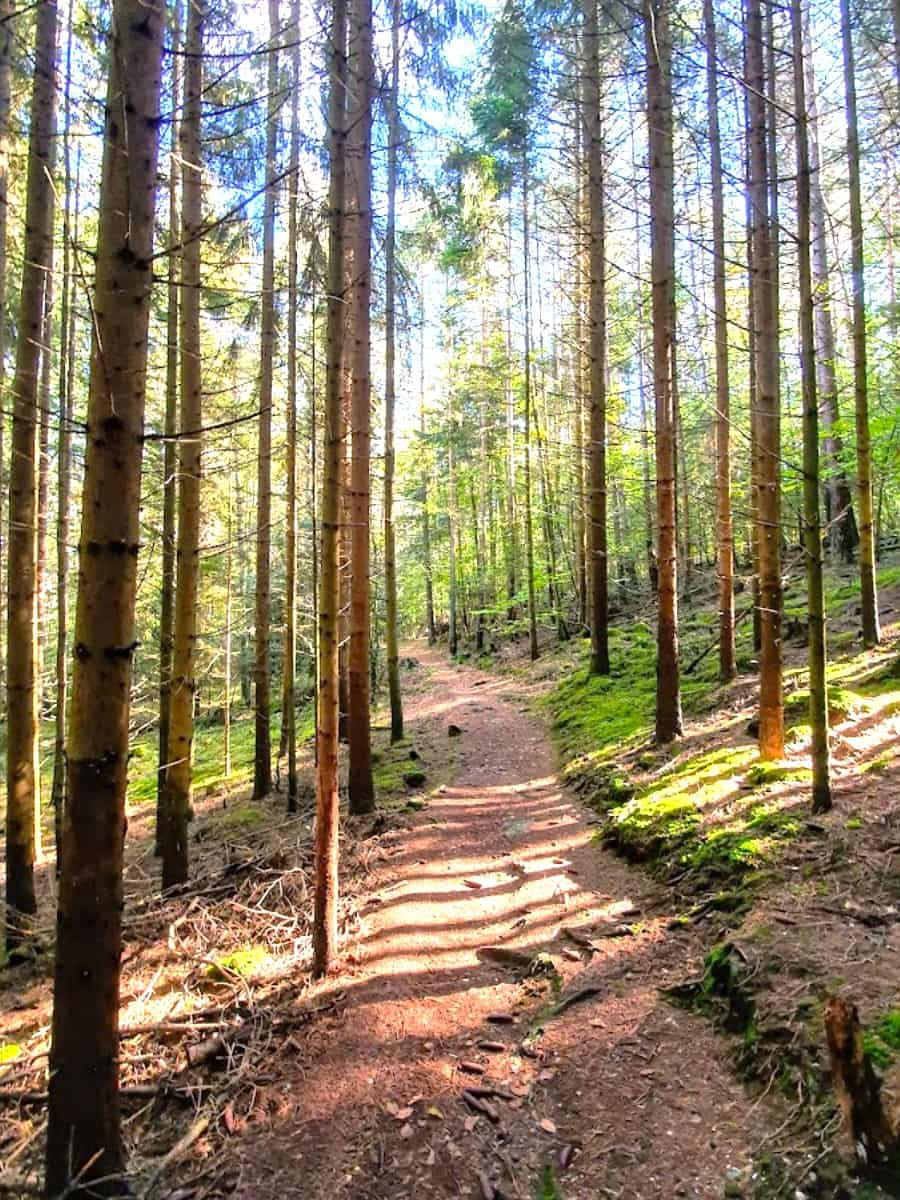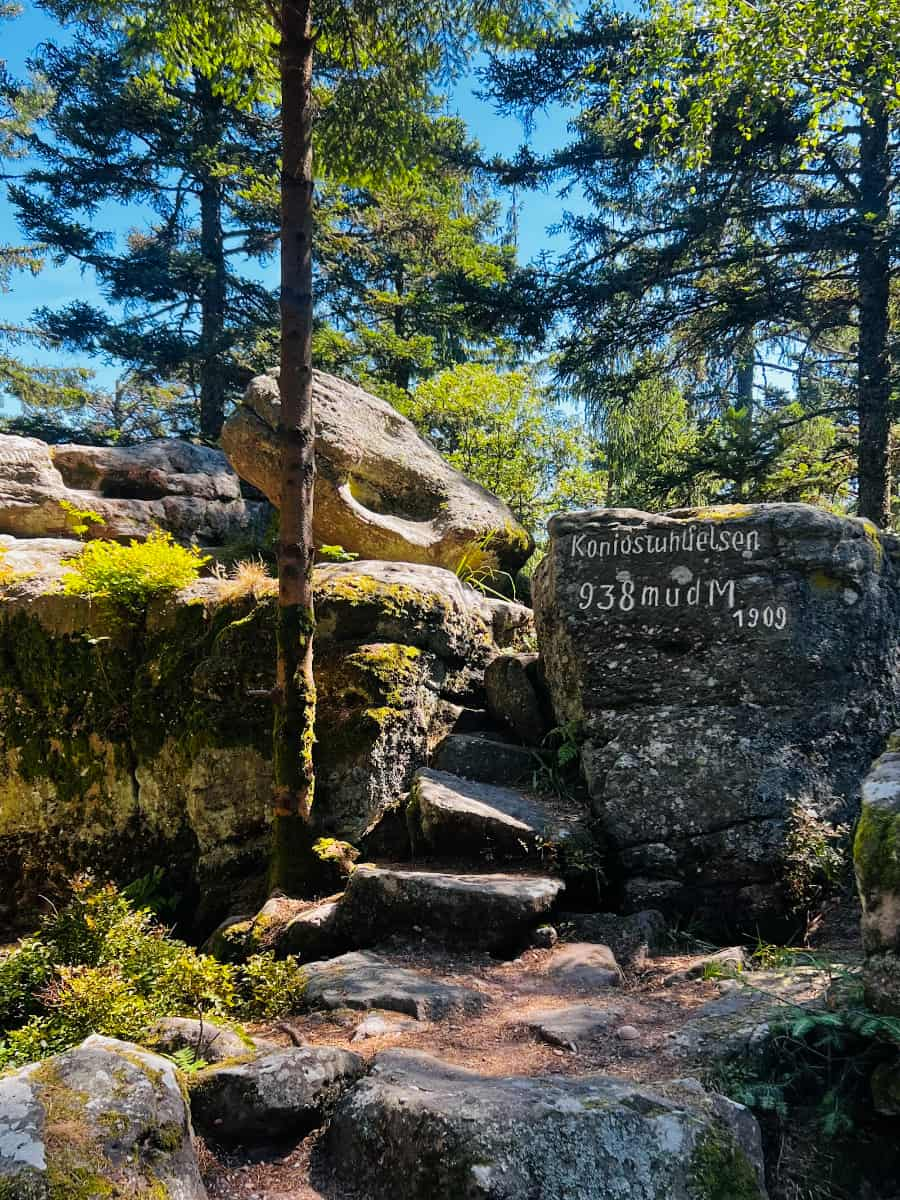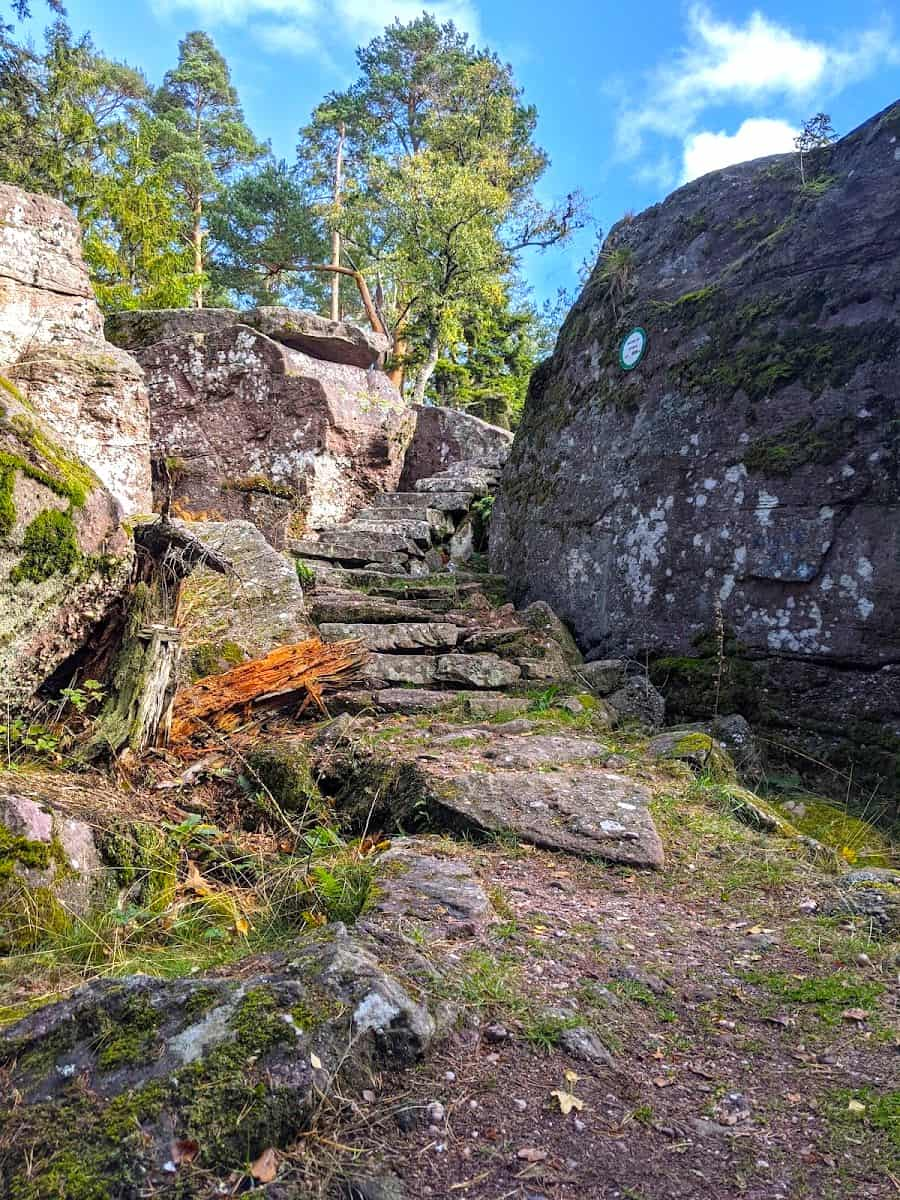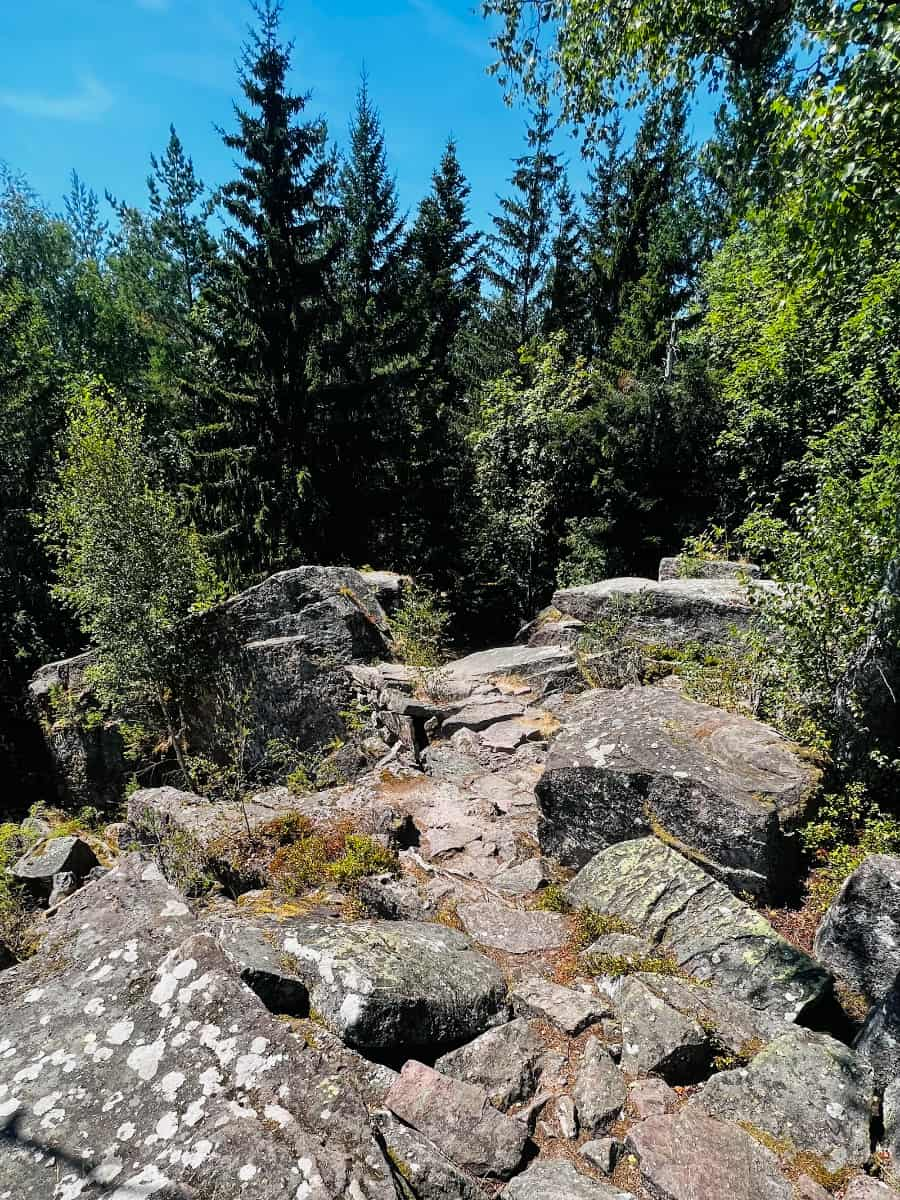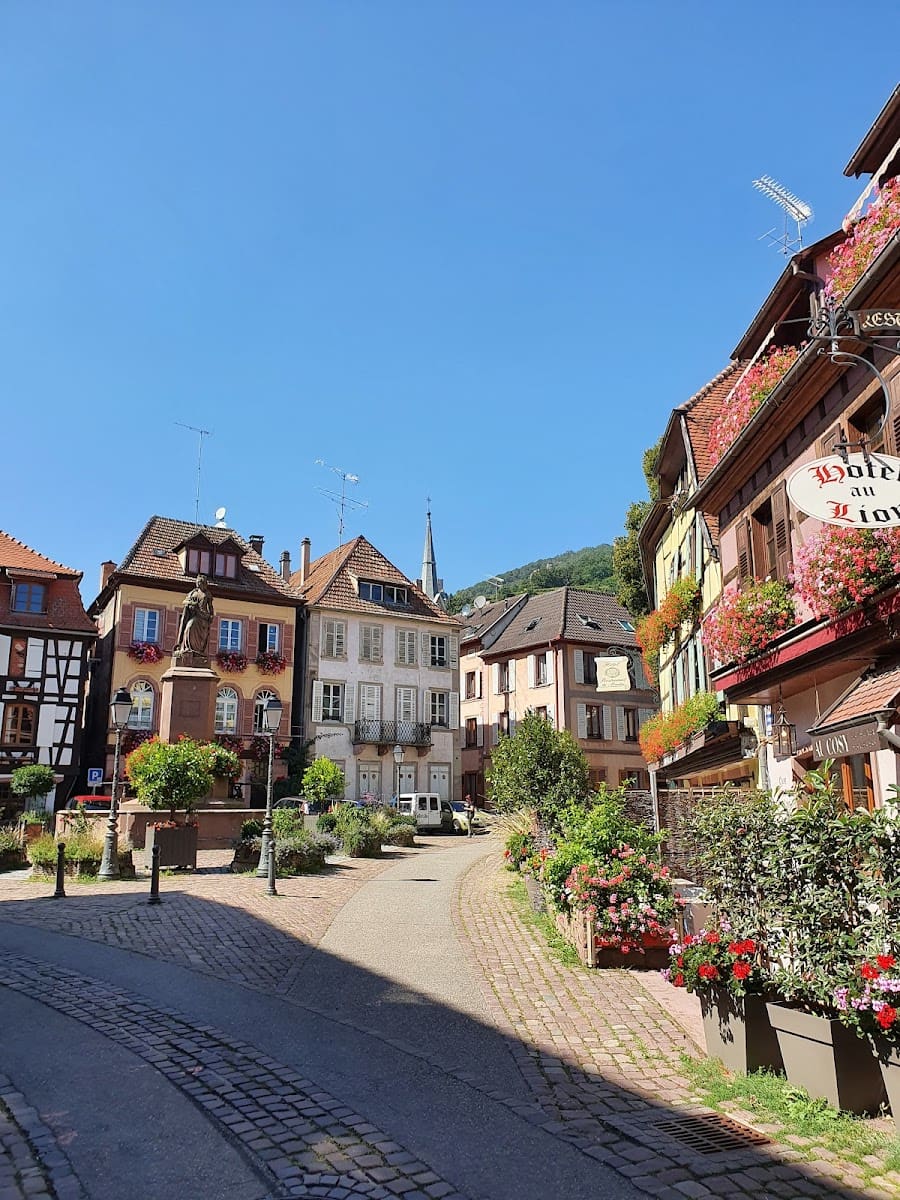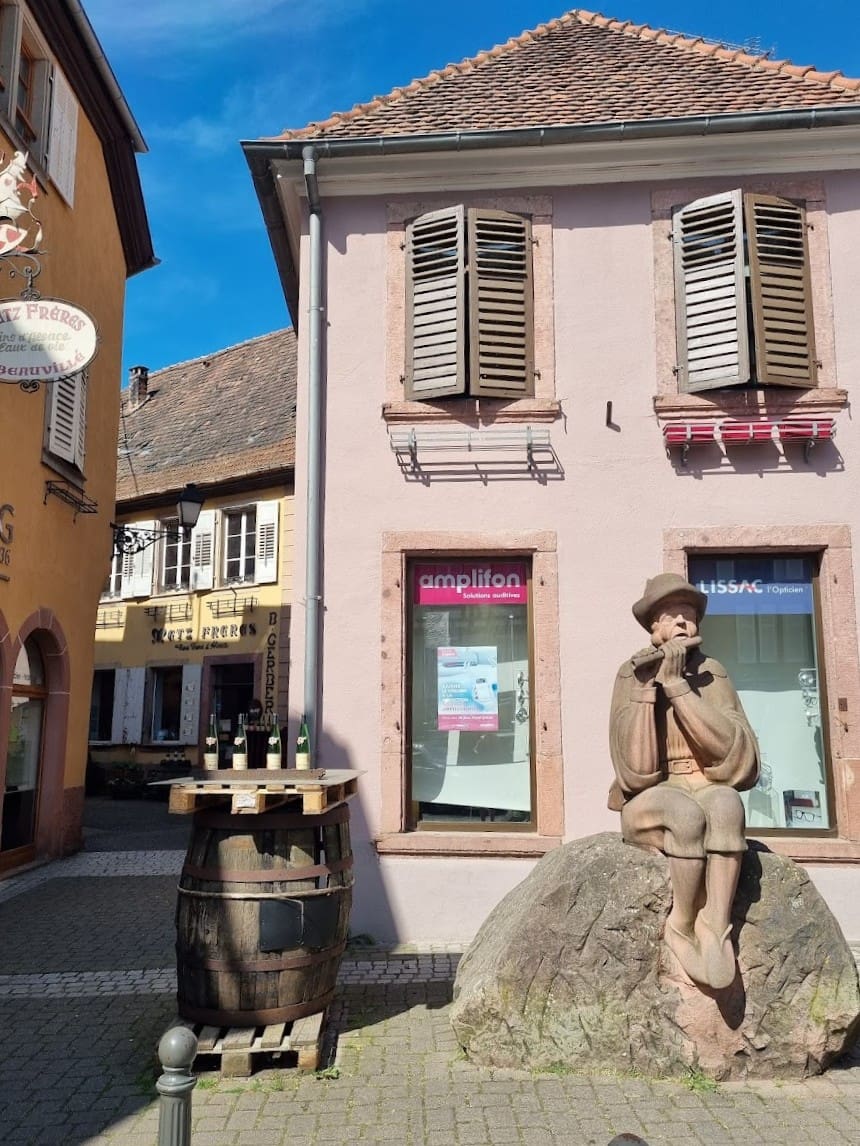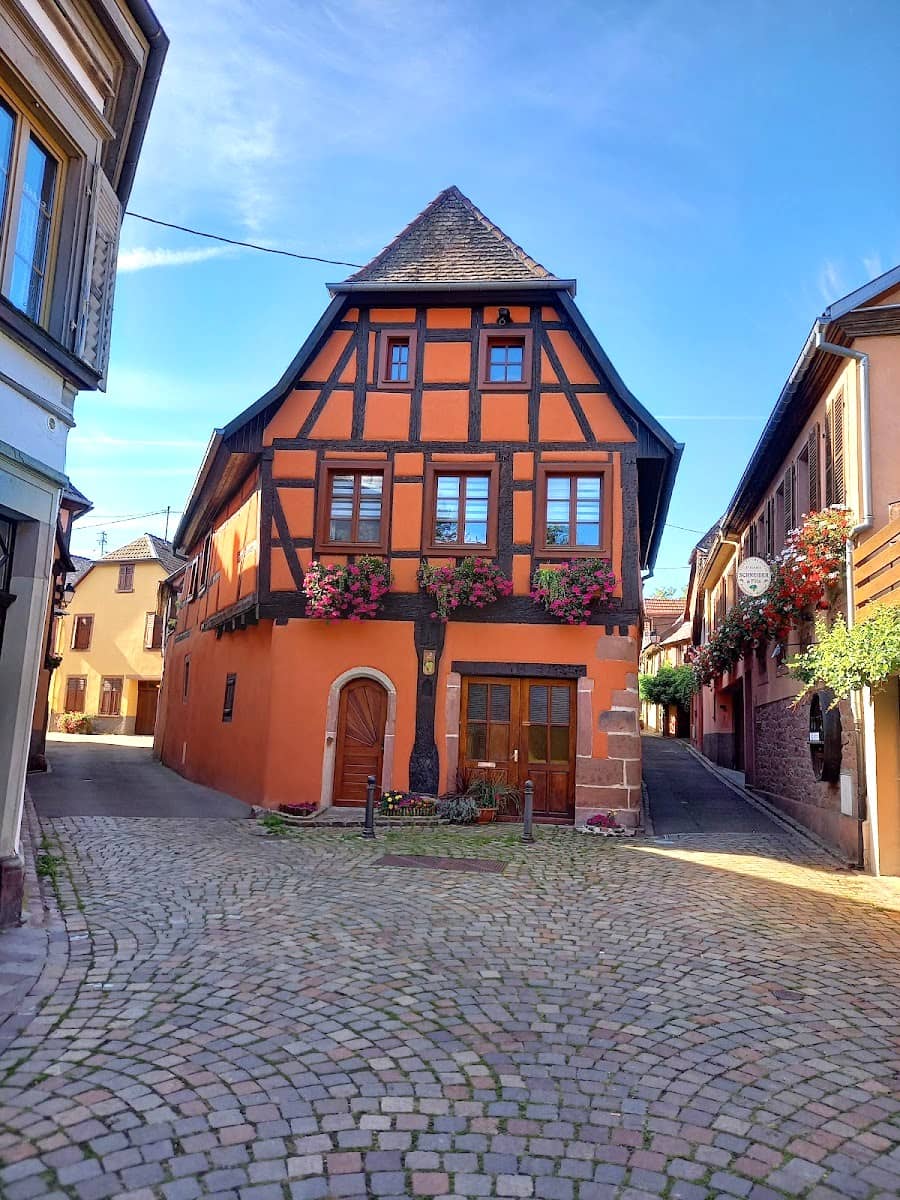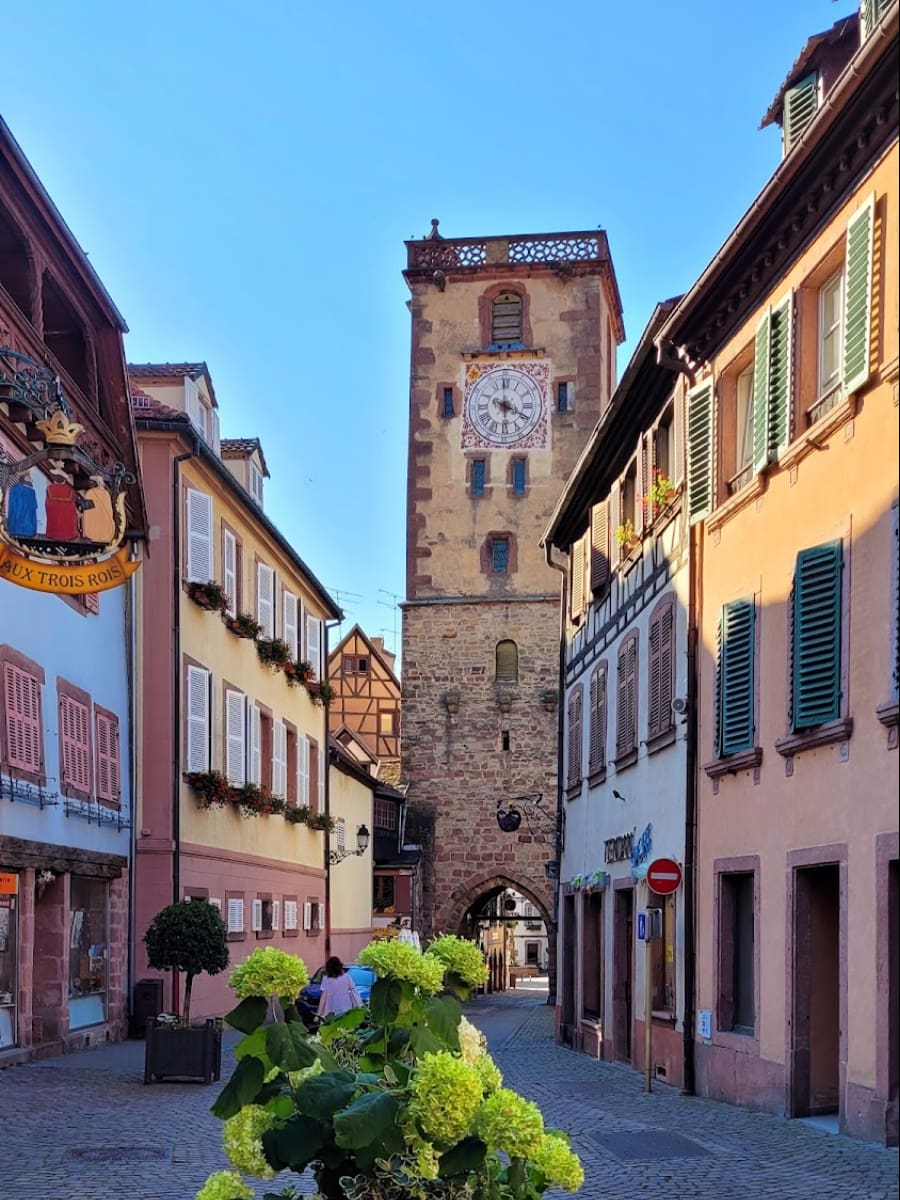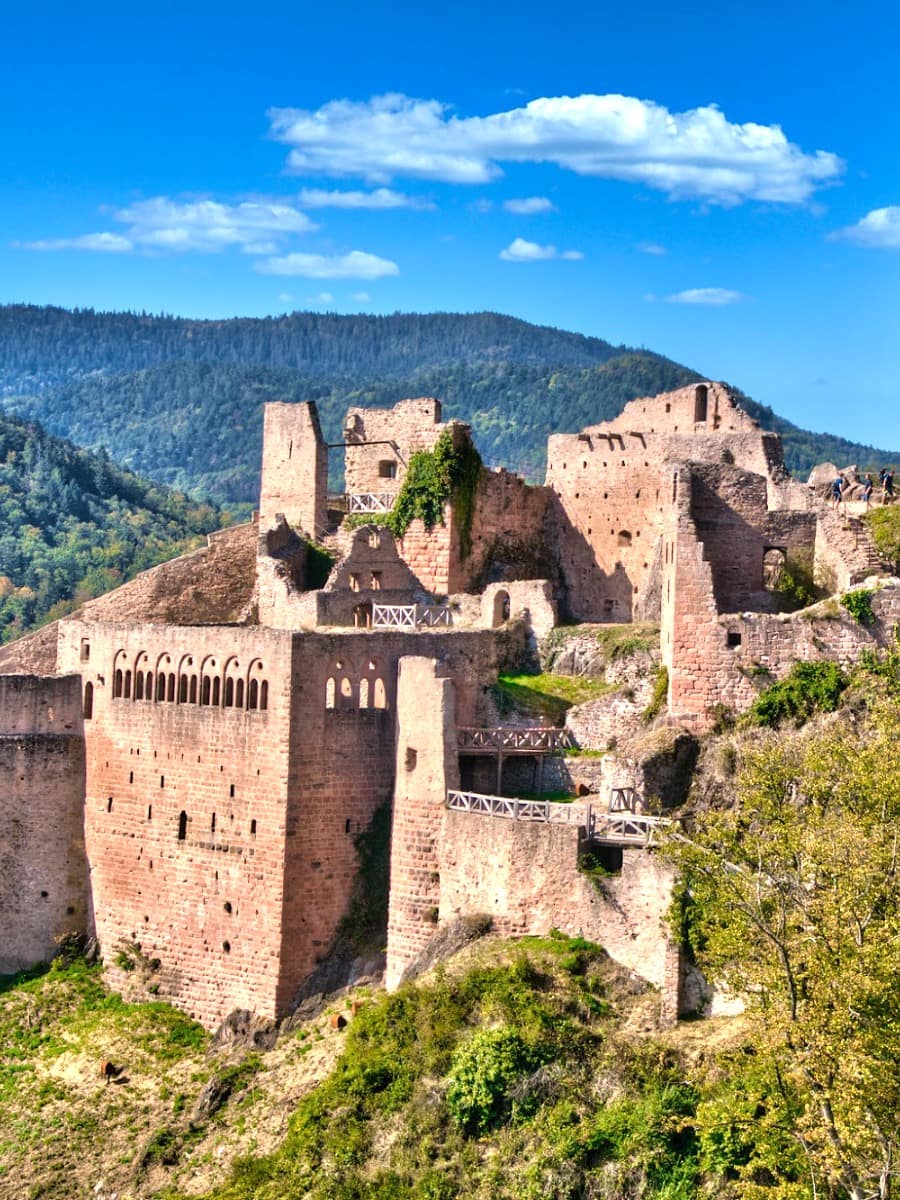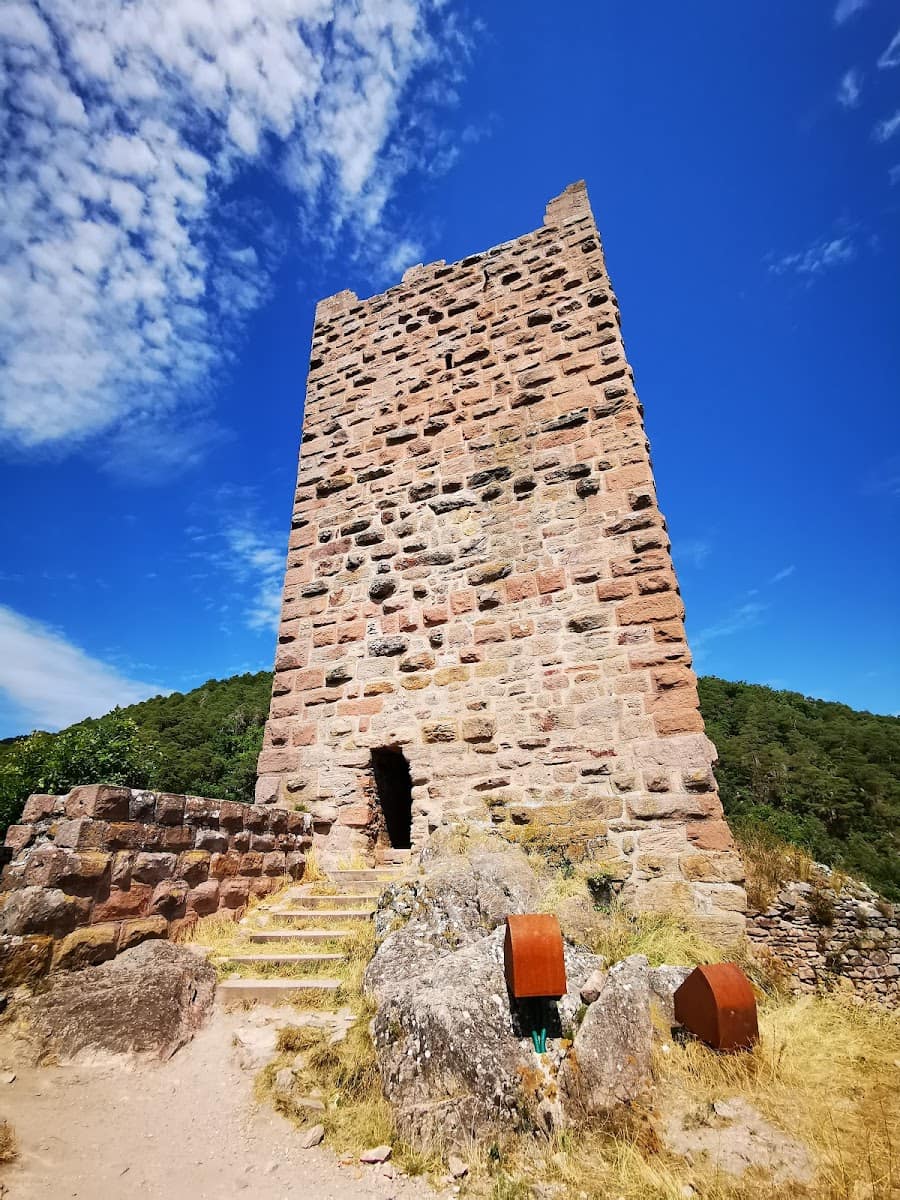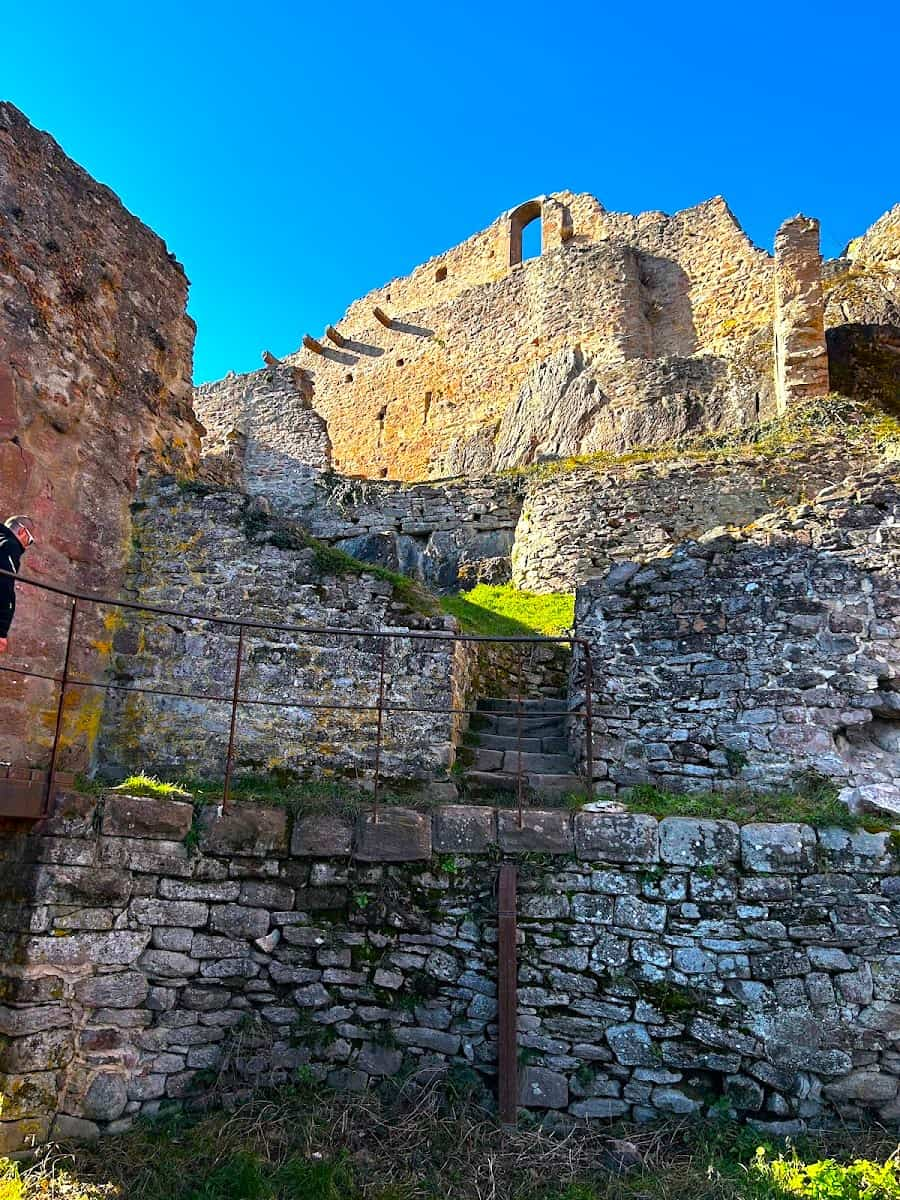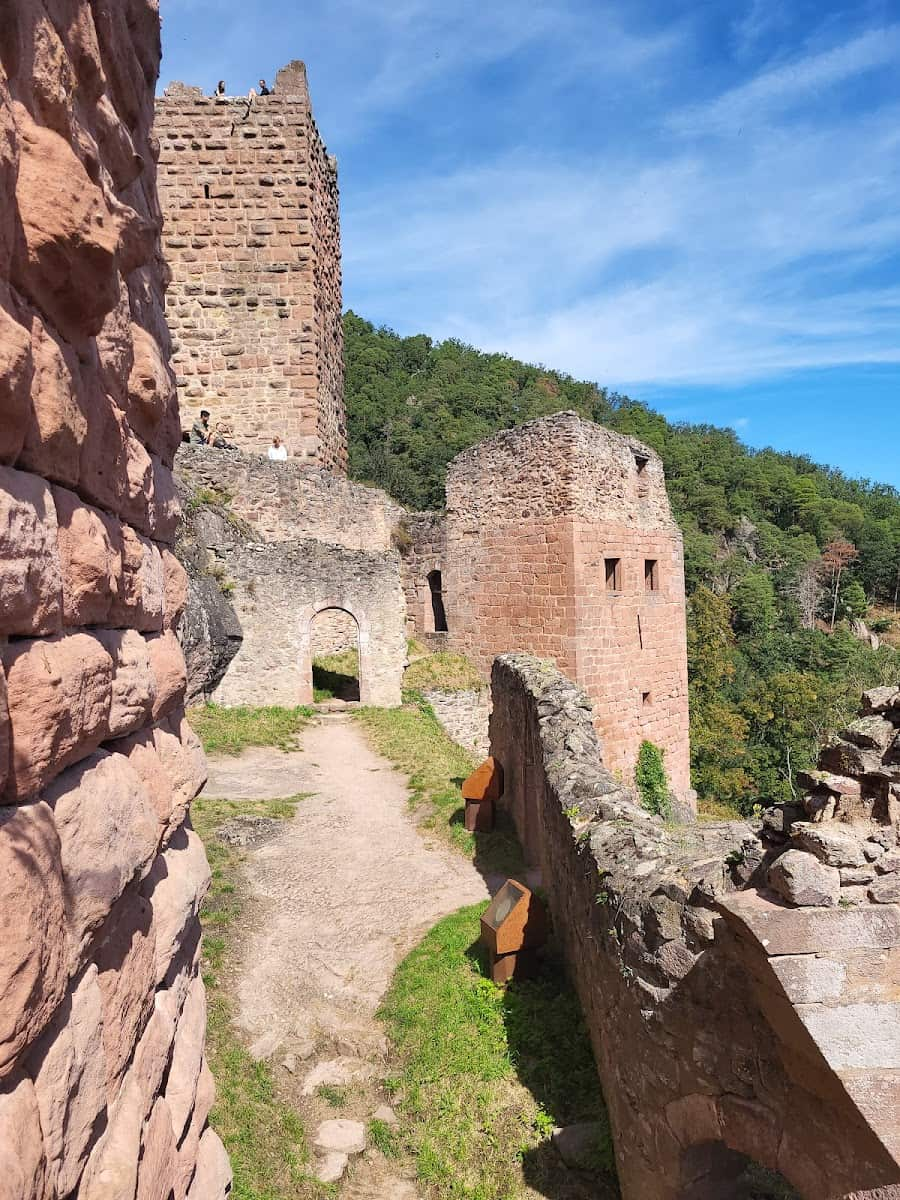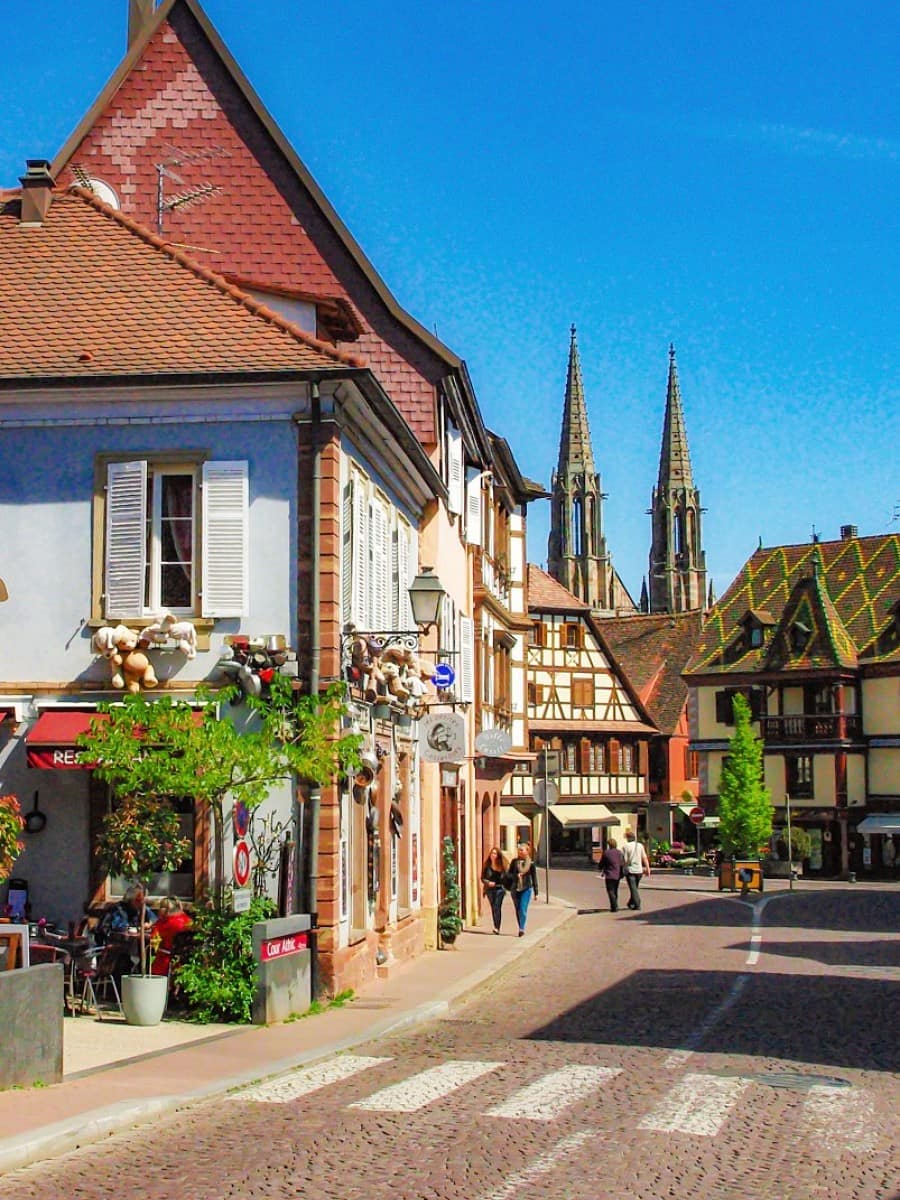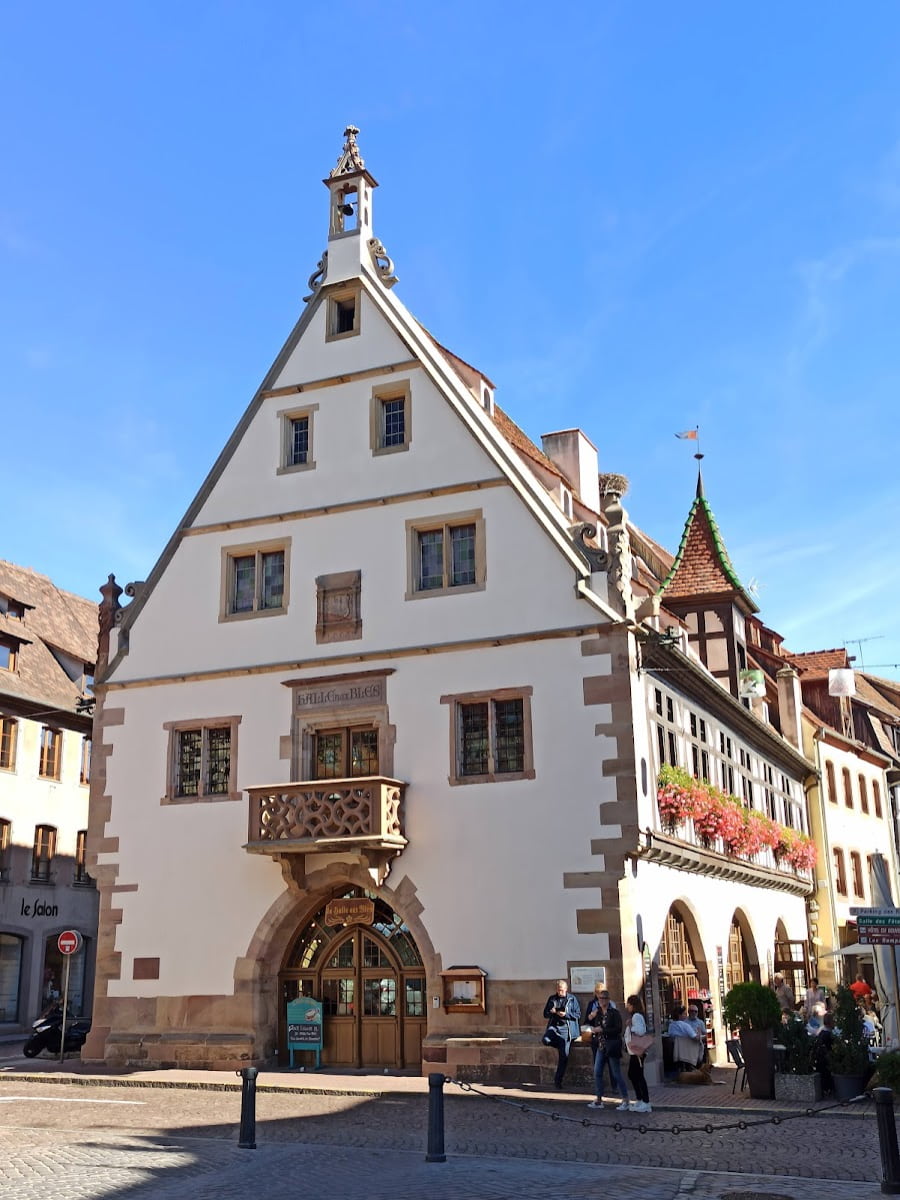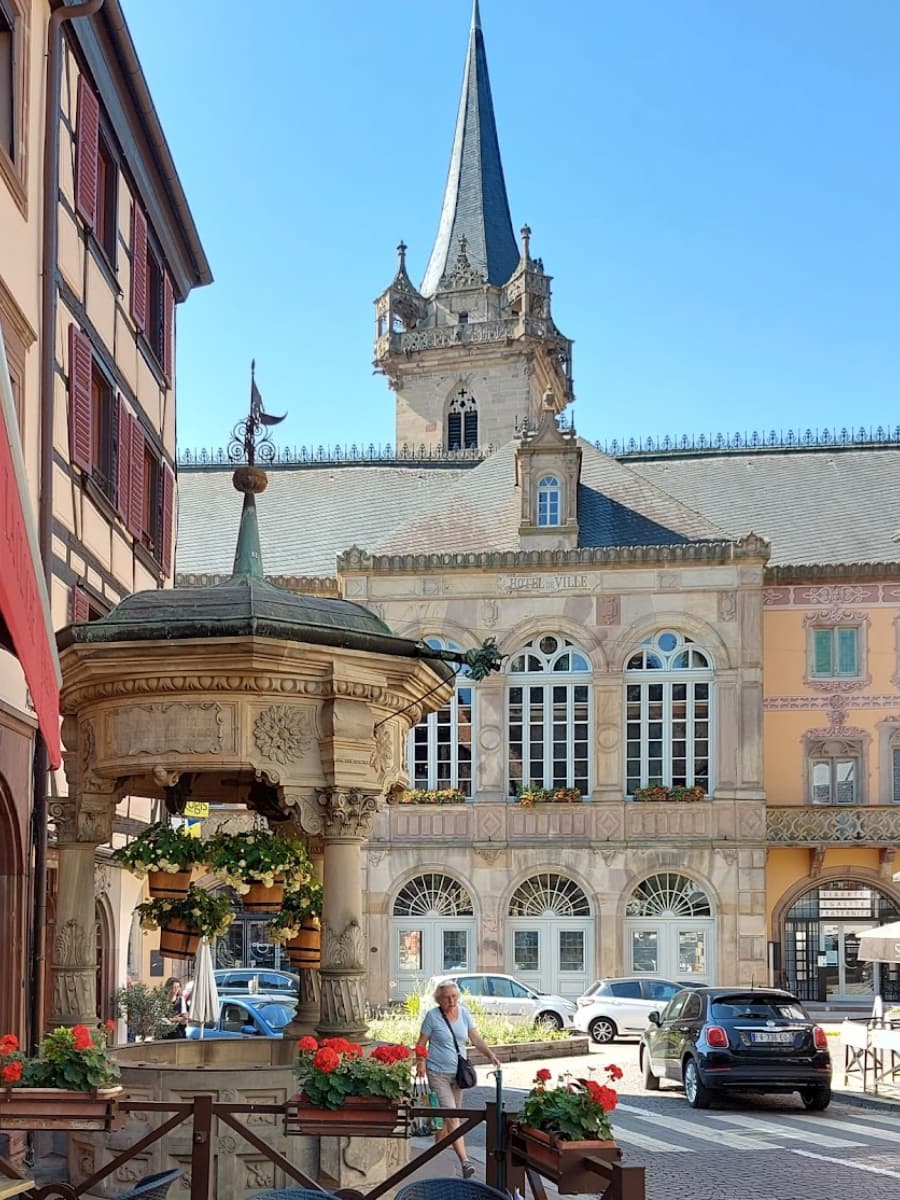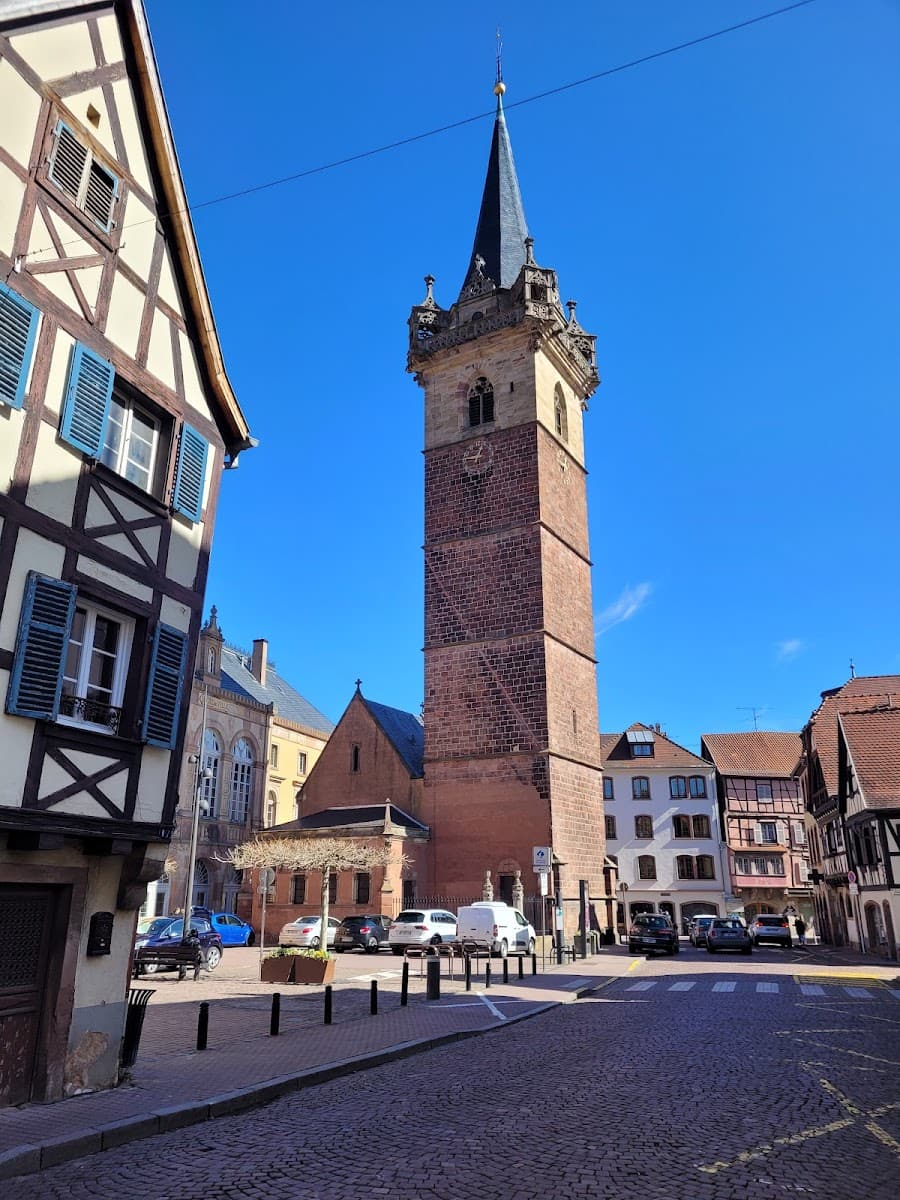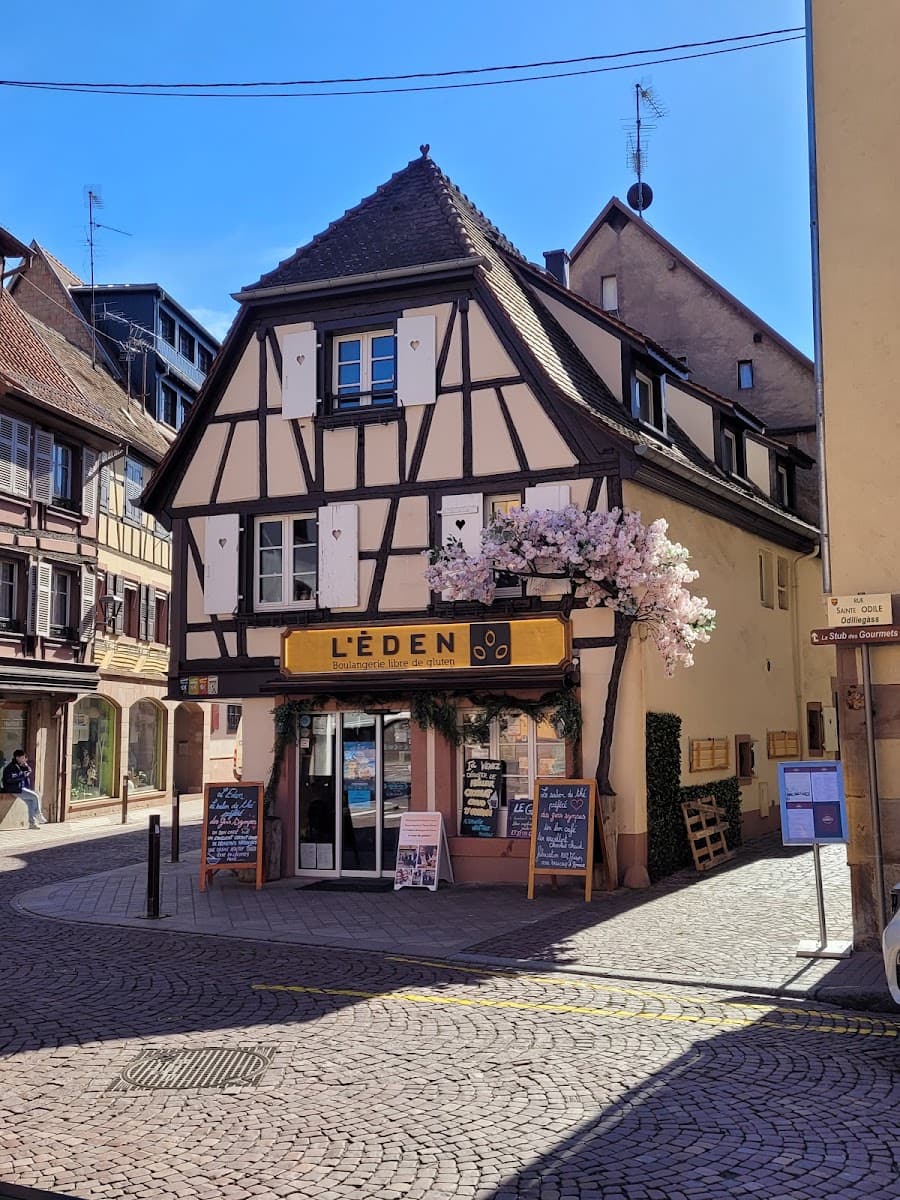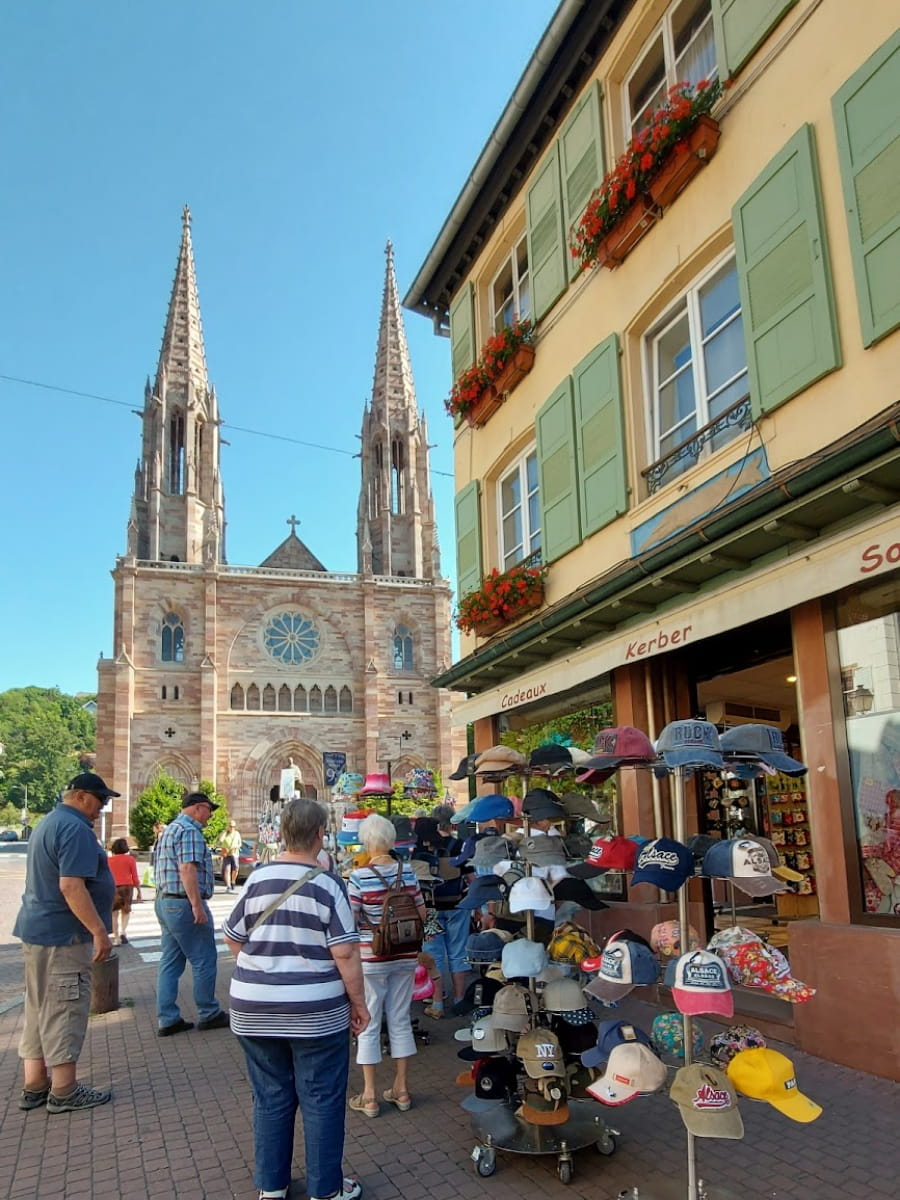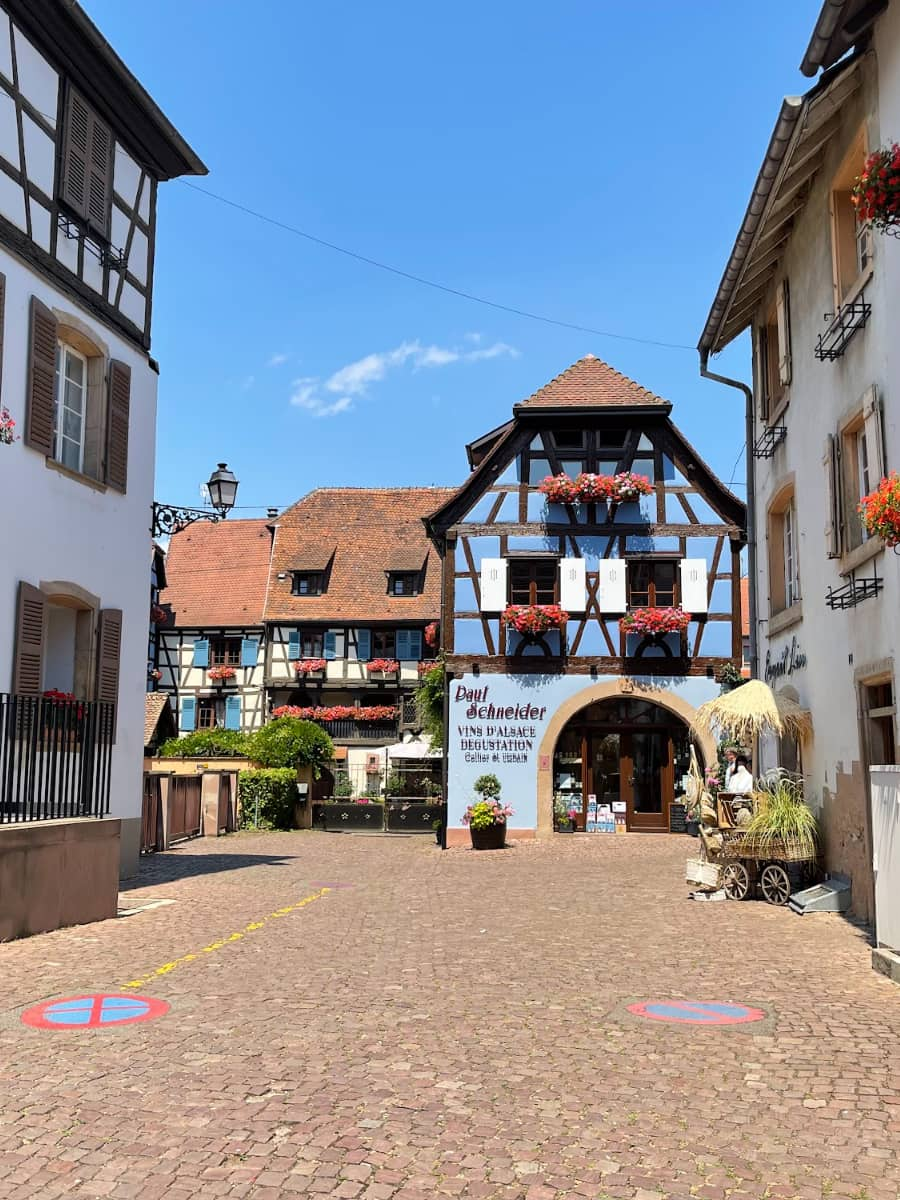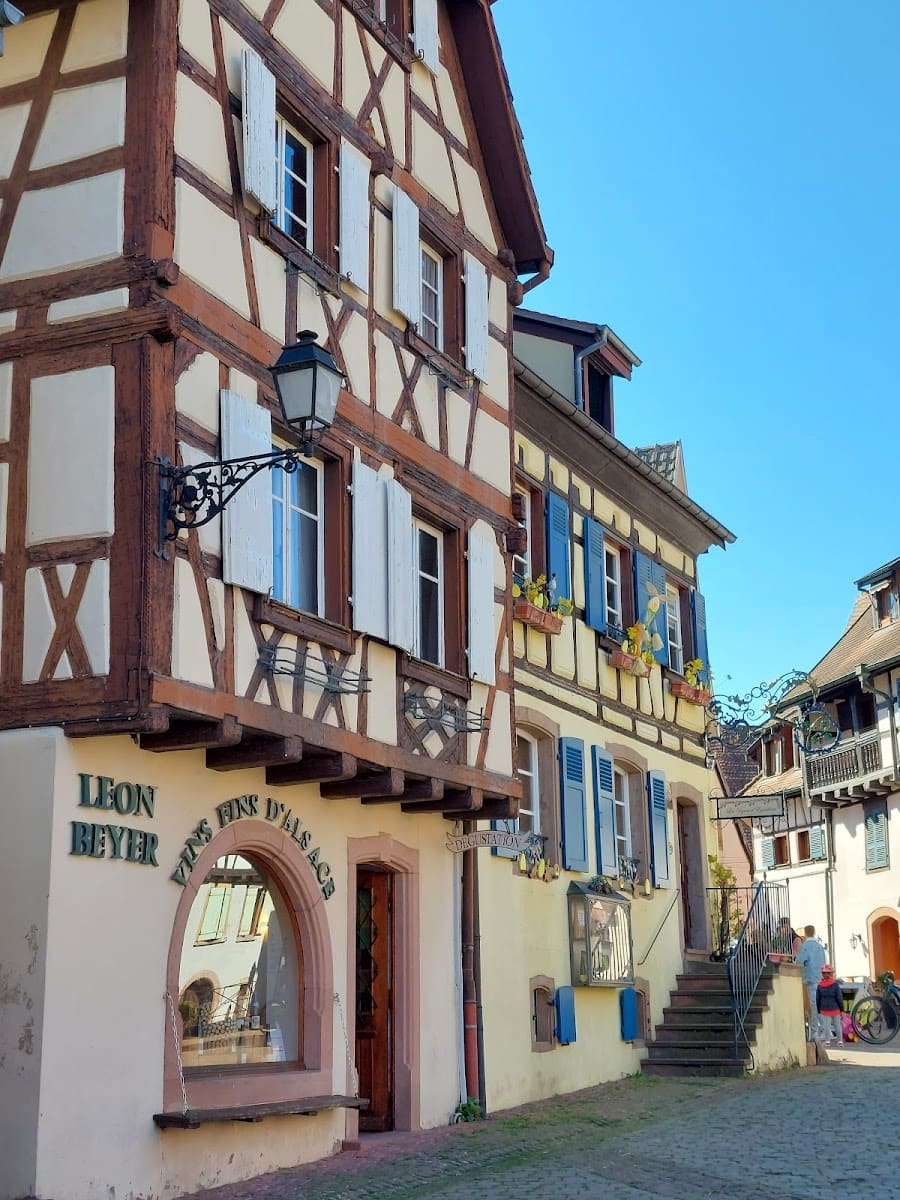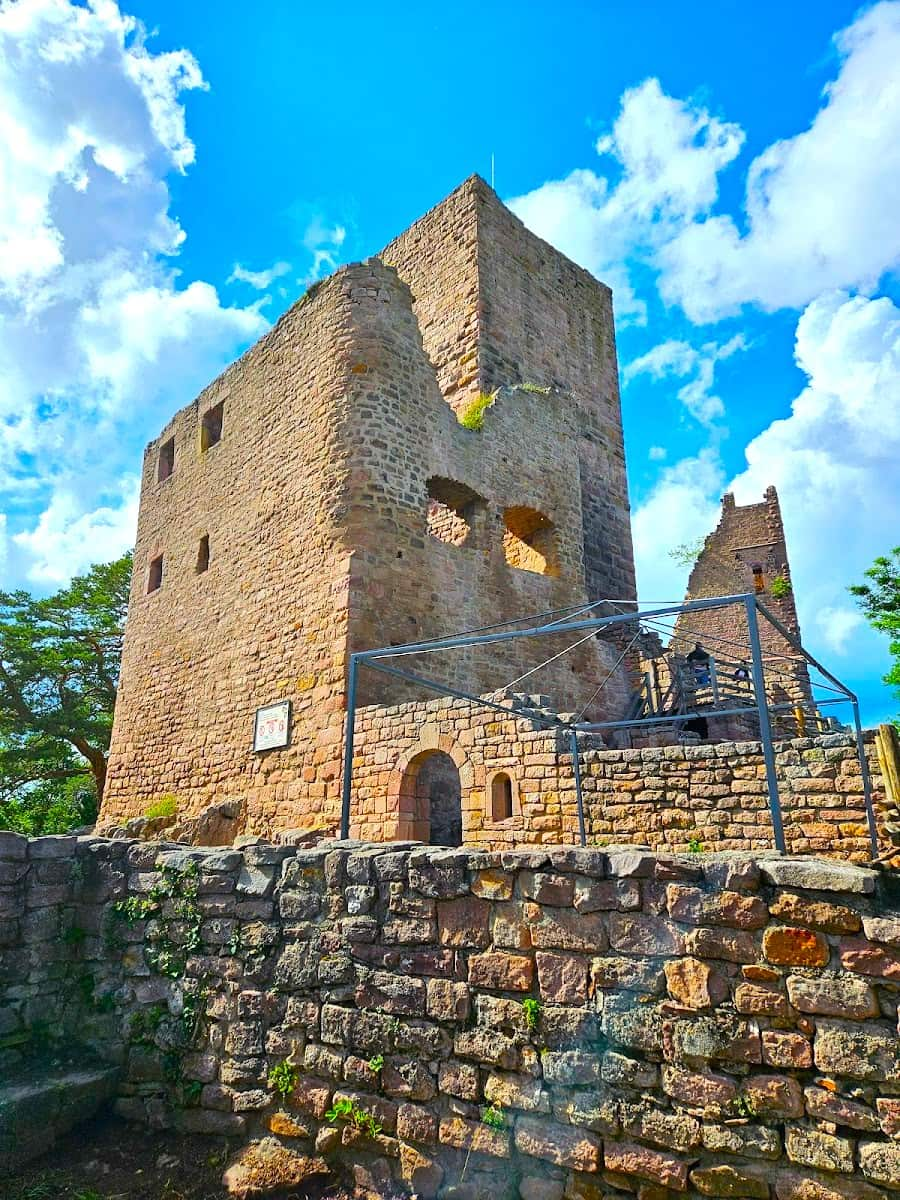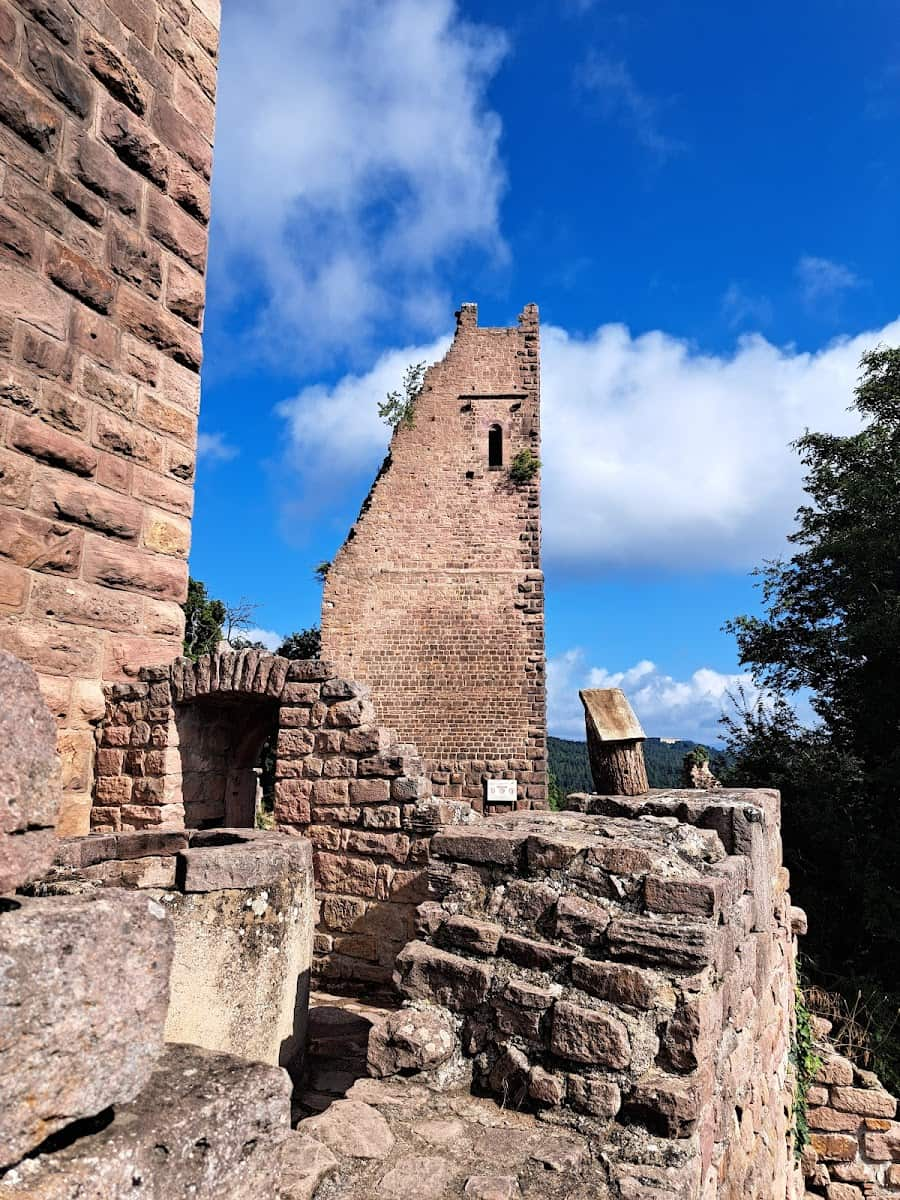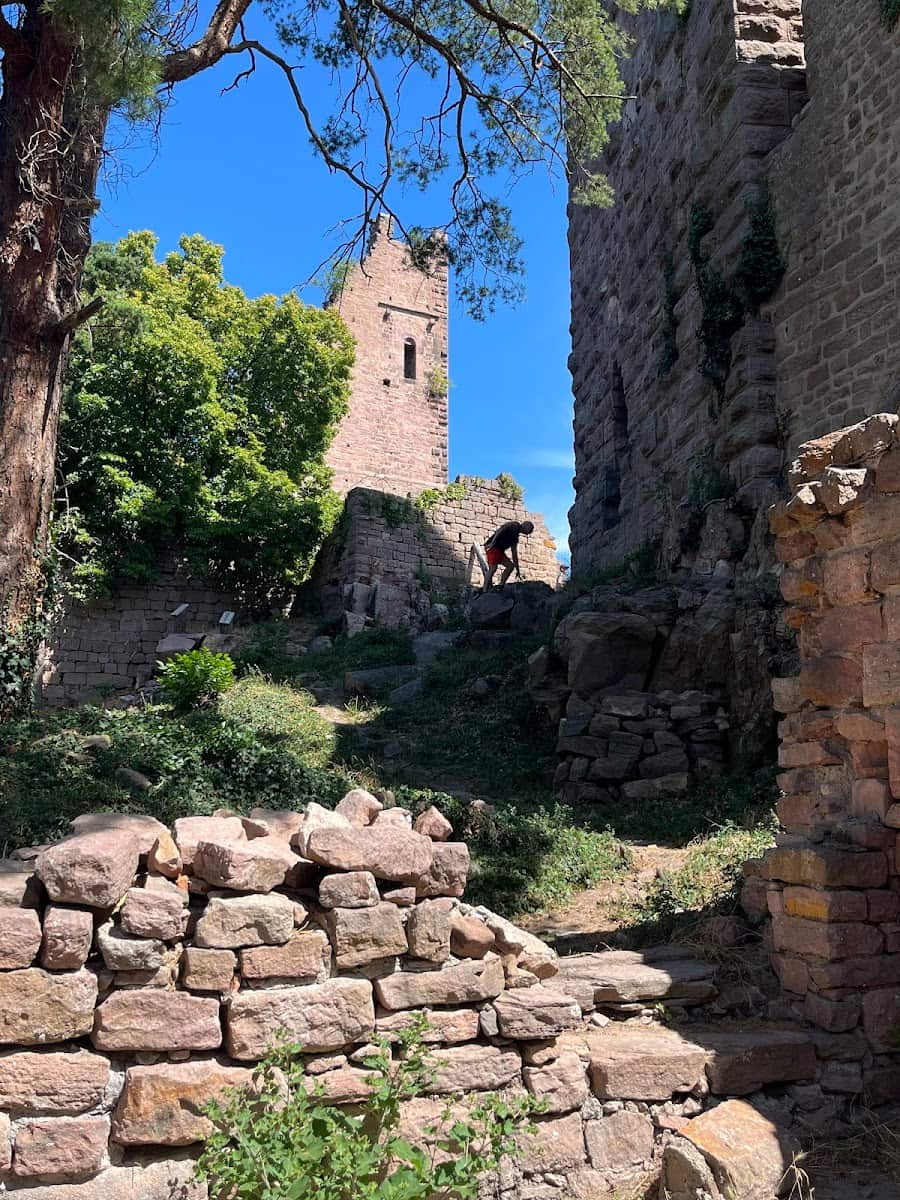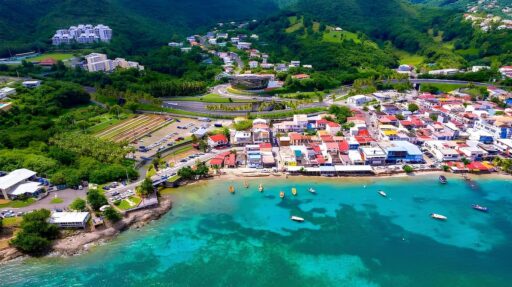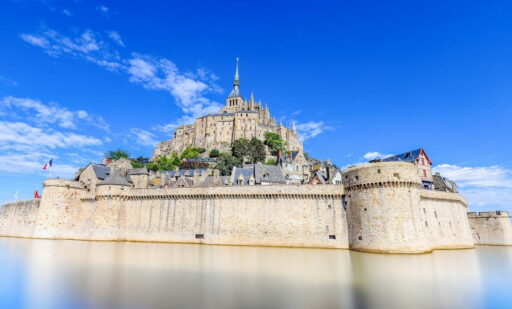Picture yourself waking up in a fairytale village where colorful half-timbered houses line cobblestone streets, and world-class vineyards stretch toward medieval castles on distant hills. This complete guide reveals the seven best places to visit in Alsace region each offering unique advantages for exploring France’s most enchanting wine region, from the romantic canals of Colmar to the UNESCO heritage streets of Strasbourg.
Inside this guide, you’ll discover detailed insights on each town’s character, the best hotels and accommodations, plus practical tips for choosing your perfect base along the famous Alsace Wine Route.
I’ve personally explored every recommendation to help you experience the region’s magical blend of French elegance and German charm, whether you’re seeking intimate vineyard stays or vibrant city experiences. Enjoy a 3-day itinerary for maximizing your stay in a charming town along the Alsace Wine Route.
Best Hotels in Alsace:🏠
- 💎 Luxury Hotel: Hôtel LÉONOR the place to live
- ✨ 5-Star: Hostellerie La Cheneaudière
- 🏨 4-Star: Husseren Les Châteaux
- 🛏️ 3-Star: Hôtel Restaurant Relais De La Poste
- 💸 Cheap: Château de Pourtalès
- 🏢 Apartment: La Suite de Vénus
- 👪 For Families: Novotel Suites Colmar Centre
- 🏩 For Couples: Pavillon REGENT PETITE FRANCE
Quick guide to the best areas to stay in Alsace: 📋
- 🍷 Wine lovers and charm: Colmar Hotels & Wine Route Stays
- 🏛️ Culture and urban experience: Strasbourg Urban Culture Hotels
- 🏰 Medieval atmosphere: Riquewihr Medieval Village Hotels
- 🥾 Castle views and hiking: Ribeauvillé Castle & Nature Hotels
- 💰 Budget and authentic life: Obernai Budget-Friendly Hotels
- 📸 Vineyard views and romance: Eguisheim Romantic Vineyard Hotels
- 🚗 Wine route access: Kaysersberg Wine Route Hotels
1. Colmar – Where to Stay in Alsace for Classic Fairytale Experience, Food and Wine
Location advantages. I chose Colmar as my base because it sits perfectly at the heart of the Alsace Wine Route, making day trips to favorite towns and surrounding villages effortless. The train station connected me directly to Strasbourg in 30 minutes, while picturesque towns like Riquewihr and Kaysersberg were just 15 minutes away by car.
Fairytale atmosphere. Walking through Little Venice each morning felt like stepping into a storybook, with colorful half-timbered houses reflecting in the canals. The cobblestone streets of the old town created that authentic alsatian charm I’d read about, especially around Place de la Cathédrale where locals gathered for their morning coffee.
Exploring nearby towns along the Alsatian Wine Route revealed why Colmar is the best place to stay for an unforgettable Alsace itinerary. Each evening, I returned to its enchanting streets, savoring the region’s magic.
Wine access. Colmar’s position along the alsace region meant I could visit three different wineries within a 10-minute drive. Local bars in Petite France offered wine tastings featuring alsatian wine varieties, with glasses starting at €6 and full tastings around €15-18.
| Wine Experience | Price (EUR) | Location |
|---|---|---|
| Wine bar tasting | €6-12 per glass | Old Town |
| Cellar tour | €15-25 | Surrounding villages |
| Premium tasting | €30-45 | Local vineyards |
Christmas magic. During my December visit, Colmar’s christmas market transformed the town into a winter wonderland. The mulled wine stands filled the air with cinnamon and clove scents, while artisan stalls sold traditional alsatian crafts along Rue des Marchands.
Food scene. Traditional restaurants served flammekueche and choucroute garni at reasonable prices – I paid €12-16 for hearty main dishes. The local bakeries on Grand Rue offered fresh kougelhopf and pretzels, perfect for breakfast before exploring the wine route.
Best Hotels in Colmar
Luxury Hotels
- Relais & Châteaux La Maison Des Têtes – This magnificent 17th-century mansion features ornate Renaissance architecture with carved heads decorating the facade, offering elegant rooms and a Michelin-starred restaurant in the heart of old Colmar.
- Hôtel Saint-Martin – This charming 3-star hotel combines traditional Alsatian character with modern comfort, featuring well-appointed rooms in a renovated private residence with Louis XVI facade.
Best Mid-Range Hotels
- James Boutique Hotel – This charming hotel combines traditional Alsatian character with modern comfort, featuring well-appointed rooms and a perfect location near the Unterlinden Museum.
- Hôtel Maison Turenne – A comfortable family-run hotel offering cozy rooms with traditional décor, friendly service, and easy walking access to the historic center and wine bars.
Best Budget Options
- ibis Budget Colmar Centre Gare – This modern 2-star budget hotel provides 74 clean, air-conditioned rooms in Colmar’s city center, just 300 meters from House of the Heads and 600 meters from Saint-Martin Collegiate Church.
- Hotel Primo Colmar Centre – This modern 2-star budget hotel provides 79 clean, air-conditioned rooms with excellent value in the heart of Colmar. Located just 300 meters from Unterlinden Museum and the Christmas market, it offers 24-hour reception, free Wi-Fi throughout, and convenient access to all major tourist attractions within a 5-minute walk.
2. Strasbourg – Where to Stay in Alsace for Urban Wine Experience
Big city vibes. Strasbourg gave me the best of both worlds – proper city life with amazing restaurants and bars, plus easy access to wine country. The tram system made getting around super simple, and I could reach the first vineyards in just 20 minutes by car from the city center.
For my trip to region of Alsace, I loved how Strasbourg, located in the Alsace region, served as the perfect base to go wine tasting in nearby villages. Each outing revealed the region’s vibrant culture and stunning landscapes.
Amazing food spots. I discovered some incredible places to eat around Grande Île. Au Pont Corbeau served the best coq au riesling I’ve ever had for €18, while Maison Kammerzell offered traditional alsatian dishes in a stunning 15th-century building. The Saturday morning market at Place du Marché aux Poissons had fresh local produce and artisan breads.
Wine bars galore. The Krutenau district became my favorite spot for evening wine tastings. Cave des Hospices de Strasbourg offered flights of local wines for €12-15, open until 10 PM on weekdays. Les Caves du Palais had over 200 alsatian wines, with knowledgeable staff who spoke perfect English.
Just a short stroll away, the historic La Petite France district captivated me with its picturesque canals and cozy wine bars right on the Wine Route. Sampling regional vintages there felt like a perfect blend of history and flavor.
| Wine Spots | Price Range | Opening Hours |
|---|---|---|
| Cave des Hospices | €8-15 per glass | 10 AM – 10 PM |
| Les Caves du Palais | €6-18 per glass | 2 PM – 11 PM |
| Wine Corner | €10-20 per flight | 4 PM – midnight |
Getting around. The CTS tram network connected me to everything I needed. A day pass cost €4.60 and covered all zones. Bike sharing through Vélhop made exploring the old town fun – I paid €1 for 30 minutes and discovered hidden courtyards around Petite France.
Culture and shopping. European Parliament tours happened every Saturday at 2 PM (free with ID), giving me insights into EU politics. Place Kléber had great shopping, while the Strasbourg Cathedral’s astronomical clock show at 12:30 PM drew crowds but was worth seeing once. Exploring Strasbourg, located in eastern France, offered a vibrant glimpse into this dynamic part of France.
Best Hotels in Strasbourg
Luxury Hotels
- Cour du Corbeau Hotel Strasbourg - MGallery Collection – This magnificent 4-star property occupies a historic 16th-century building dating back to 1528 in central Strasbourg. Featuring 63 unique rooms with Renaissance charm, modern amenities, and a peaceful courtyard, it sits just 350 meters from tram connections and offers excellent access to Strasbourg Cathedral and historic attractions.
- Hotel & Spa REGENT PETITE FRANCE – This stunning 5-star property occupies converted historic ice mills from the 17th century in UNESCO-listed Petite France district. Featuring elegant rooms with canal views, a world-class spa with sauna and hammam, champagne bar with 20+ varieties, and Michelin-level dining – all in the heart of Strasbourg’s most picturesque quarter.
Best Mid-Range Hotels
- HANNONG Hotel & Wine Bar – This elegant 4-star hotel sits in the heart of Strasbourg, just 5 minutes walk from the TGV train station, Petite France district and the Cathedral. Featuring 72 individually furnished rooms with air conditioning, premium bedding and a sophisticated wine bar, guests consistently praise its excellent location and helpful multilingual staff.
- Hôtel de l'Europe by HappyCulture – This 4-star architectural gem nestled in a former 15th-century coaching inn perfectly combines historic charm with modern facilities. Located in the heart of Petite France, it offers 67 tastefully decorated air-conditioned rooms and serves a gourmet buffet breakfast rated 8.7 by guests.
Best Budget Options
- Best Western Plus Monopole Métropole – This 4-star hotel in a charming 19th-century building offers contemporary accommodation just 400 meters from Strasbourg Train Station. With 81 bright air-conditioned rooms, modern bar with local art, and underground parking, it provides excellent value near La Petite France district.
- Hôtel Du Dragon – This charming 3-star hotel occupies a 17th-century building surrounding a peaceful patio garden. Located just 5 minutes walk from the Cathedral and 2 minutes from Petite France, it offers modern comfortable rooms, 24-hour room service, and friendly staff who provide personalized local advice.
3. Kaysersberg – Where to Stay in Alsace for Wine Route Access
Perfect location. This little town sat right in the middle of everything I wanted to see. I could walk to three different wineries in under 15 minutes, and the drive to either Colmar or Riquewihr took just 10 minutes on quiet country roads. It was the perfect base for exploring the best wineries to visit, including those offering the oldest wine in the region. The town’s charm made it one of my favorite destinations in France.
Local wine scene. Domaine Weinbach, just outside town, offered tastings for €8 per person from Monday to Friday, 9 AM to 5 PM. Cave de Kaysersberg in the town center had reasonable prices – I bought excellent Gewürztraminer for €12-18 per bottle and Riesling for €9-15.
Castle hiking. The ruins above town made for a great morning walk. The path started behind the church and took about 45 minutes up. I packed snacks from Boulangerie Gilg on Rue du Général de Gaulle – their pain aux raisins cost €1.50 and kept me going on the climb.
Essential stops in Kaysersberg:
- Maison Brief (historic house museum) – €4 entry, open 10 AM-6 PM
- Église Sainte-Croix (medieval church) – free, amazing wood carvings
- Place de la Mairie (main square) – perfect for morning coffee
- Fortified bridge – great photo spot, especially at sunset
Local flavors. Restaurant Au Lion d’Or served fantastic baeckeoffe (traditional stew) for €16, and their wine list featured only local producers. The weekly market on Friday mornings brought vendors selling fresh cheese, honey, and seasonal vegetables to Place de l’Ancien Hôpital.
Easy day trips. From Kaysersberg, I visited six wine villages in one day using the Route des Vins signs. Ammerschwihr was 5 minutes away, Ingersheim took 8 minutes, and Turckheim was just 12 minutes – each offered different wine experiences and specialty shops. The nearby towns to visit, like Riquewihr and Eguisheim, added their own unique charm and tastings to my journey.
Best Hotels in Kaysersberg
Luxury Hotels
- Relais et Châteaux Le Chambard – This exquisite 5-star family-run hotel combines traditional Alsatian charm with modern luxury in an 18th-century mansion. Featuring spacious rooms with vineyard views, a 2-star Michelin restaurant by Chef Olivier Nasti, traditional Winstub, spa facilities with indoor pool and sauna, plus stunning panoramic terraces overlooking the medieval town center.
- Hotel KLE, BW Signature Collection – This sophisticated 4-star boutique property occupies a former winegrower’s house in Kaysersberg’s historic center. Offering 22 individually designed rooms combining old-world charm with modern amenities, wellness area with sauna and steam room, plus an atmospheric Alsatian cellar serving local wines and gourmet breakfasts.
Best Mid-Range Hotels
- Hotel Les Remparts – This charming 3-star family-run hotel sits just outside Kaysersberg’s medieval walls, offering large comfortable rooms with authentic Alsatian décor and private balconies. Located only 2 minutes walk from the old town gate, it provides excellent value with free parking, buffet breakfast, and friendly multilingual staff who offer local recommendations.
- ART Hôtel – This cozy 3-star hotel features 8 uniquely designed rooms with exposed beams and modern amenities in a central location. Offering a sun terrace, play area, wine bar serving European cuisine, plus convenient access to Kaysersberg’s historical museum just 150 meters away and easy walking access to local wineries.
Best Budget Options
- Gîtes Hassenforder – This welcoming family-run establishment provides comfortable gîte accommodations with personal touches and authentic Alsatian hospitality. Offering spacious rooms with private bathrooms, free toiletries, and insider knowledge about local wine estates from friendly hosts who truly care about their guests’ experience.
4. Riquewihr – Where to Stay in Alsace for Medieval Charm
Time travel feeling. Walking through Riquewihr’s gates felt like entering a movie set. The medieval walls kept cars out, so I explored everything on foot through narrow streets lined with 16th-century houses. Every corner revealed another perfect photo opportunity. This gem, one of the most beautiful villages in France, enchanted me with its timeless charm and vibrant history.
Wine central. This tiny town packed in more wine shops than anywhere else I visited. Caves Dopff & Irion offered free tastings daily from 10 AM to 6 PM, while Hugel & Fils (founded in 1639) charged €5 for premium tastings but included historical wine cellar tours. With its vibrant wine culture and charming streets, this town is absolutely worth a visit.
Shopping paradise. Rue du Général de Gaulle became my favorite street for local products. Distillerie Artisanale Miclo sold fruit brandies and liqueurs for €15-35 per bottle. Au Tire-Bouchon specialized in corkscrews and wine accessories – I found unique gifts starting at €8.
| Wine Shops | Specialties | Tasting Prices |
|---|---|---|
| Dopff & Irion | Grand Cru wines | Free daily |
| Hugel & Fils | Historic vintages | €5 per person |
| Cave Zimmer | Organic wines | €3 per glass |
| Domaine Specht | Crémant d’Alsace | €6 for 3 wines |
Food discoveries. Le Sarment d’Or served traditional tarte flambée for €11 in a cozy half-timbered building. Their outdoor terrace overlooked vineyards, and service ran from noon to 9 PM. Pâtisserie Beyer made incredible kougelhopf – I bought a small one for €6 that lasted two days. Exploring nearby towns and villages during my 3 days in the Alsace revealed more culinary delights and picturesque settings.
Museum culture. The Torture Museum (Musée de la Torture) might sound weird, but it showed fascinating medieval history for €7 entry. The Christmas Museum operated year-round, displaying ornaments and traditions for €5 – perfect for understanding alsatian holiday culture.
Best Hotels in Riquewihr
Luxury Hotels
- Best Western Plus Hotel & SPA Le Schoenenbourg – This prestigious 4-star spa hotel sits surrounded by vineyards opposite the ramparts of medieval Riquewihr village. Featuring 69 rooms and suites with vineyard views, indoor/outdoor pools, spa facilities with sauna and hammam, plus eco-friendly Green Key certification. The property offers spacious rooms with period furnishings, modern comforts, free parking, and a restaurant serving Alsatian cuisine.
- Hôtel De La Couronne – This intimate 3-star charming hotel occupies an authentic 16th-century half-timbered building in the heart of Riquewihr’s historic center. Featuring 41 individually decorated rooms with antique furniture across three colorful buildings (yellow, orange, and blue houses), each with private bathroom, WiFi, and unique character. Includes a cellar bar renovated in 2020, electric car charging station, and peaceful courtyard.
Best Mid-Range Hotels
- Hôtel le Saint Nicolas – This charming family-operated hotel occupies three 17th-century half-timbered buildings in central Riquewihr, just 350 meters from the Christmas market. Offering comfortable rooms with traditional Alsatian character, Restaurant Le Manala specializing in regional cuisine and local wines, plus excellent breakfast buffet rated 8.1 by guests. Perfect location 400 yards from Riquewihr center.
- Hôtel Le Riquewihr – This welcoming 3-star family hotel sits at the entrance to medieval Riquewihr, offering 49 rooms and suites plus a large independent apartment. Features include private parking with electric terminals, summer terrace, body care center with swimming pool and sauna, plus an ideal location for exploring wine shops and medieval architecture along the main street.
Best Budget Options
- Hôtel à l'Oriel – This budget-friendly 3-star guesthouse sits right in Riquewihr’s center around a peaceful central courtyard. Offering clean, comfortable rooms with authentic village atmosphere, wine cellar for tastings, summer courtyard seating, and multilingual staff. Excellent value at approximately $84 per night for exploring the medieval town and surrounding vineyards on foot.
5. Ribeauvillé – Where to Stay in Alsace for Castle Views
Three castles above. I spent my first morning hiking to the castle ruins on the hills above town. The easiest path to Château de Ribeaupierre took 30 minutes from the town center, while the more challenging hike to all three castles needed about 2 hours round trip. From this vantage point in one of our favorite towns, I could see the wine route spans 170 km, weaving through picturesque vineyards and villages.
Festival town. Ribeauvillé hosts amazing events throughout the year. The Fête des Ménétriers in September brought medieval music and costumes to the streets – entry was free and food stalls offered local specialties.
The Christmas market in December filled Grand’Rue with handmade crafts and mulled wine for €3 per cup. Unlike the hill towns of Tuscany, Ribeauvillé’s fairytale-like towns charm visitors with their vibrant festivals and Alsatian allure.
Wine experiences. Cave de Ribeauvillé, the local cooperative, offered excellent value tastings for €6 per person from Monday to Saturday, 9 AM to 7 PM. Domaine de la Confrérie Saint-Étienne specialized in Grand Cru wines, with guided tastings at €12 including cheese pairings.
Local food spots:
- Restaurant Au Zahnacker – traditional alsatian cuisine, mains €14-22
- Winstub zum Pfifferhüs – cozy atmosphere, famous for choucroute €16
- Boulangerie-Pâtisserie Dock – fresh bread daily, croissants €1.20
- Ferme-Auberge du Taennchel – mountain restaurant, weekend only
Family activities. The town had great stuff for kids too. Parc de loisirs et animalier de Ribeauvillé featured local animals and playground equipment for €8 entry. The narrow-gauge train to Riquewihr ran weekends in summer for €12 adults, €6 children – a fun way to see countryside.
Shopping finds. I loved browsing the antique shops along Grand’Rue. Antiquités Alsaciennes sold vintage wine tools and traditional pottery. The weekly market on Saturday mornings brought fresh produce vendors to Place de la République – perfect for picnic supplies before castle hiking. Exploring these small towns, with their unique charm and vibrant markets, is well worth a visit.
Best Hotels in Ribeauvillé
Luxury Hotels
- Resort Barrière Ribeauvillé – Located on the Alsace Wine Route, it offers 2 restaurants, 2 indoor pools, full-service spa with hammam and sauna, casino, and outdoor terraces with stunning vineyard views. The property provides free WiFi, self parking, and direct access to wine cellars and hiking trails.
- L'Hôtel & Spa Ribeauvillé – Featuring individually decorated, soundproofed rooms with air conditioning, flat-screen TVs, and memory foam beds, plus a full-service spa with indoor heated pool, sauna, steam room, and hot tub. The hotel offers exceptional service with multilingual staff and is just 3 minutes walk from local wineries.
Best Mid-Range Hotels
- Logis Hôtel-Restaurant du Mouton – This charming 14th-century family-run hotel sits in the heart of Ribeauvillé’s historic center, featuring 13 comfortable rooms combining tradition and modernity.
- Logis Hôtel de la Tour – This unique 3-star hotel occupies a former winery in Ribeauvillé’s medieval center, just 50 meters from the town center. Featuring 31 comfortable, individually decorated rooms with details of the original Alsatian building, plus free access to wellness facilities including sauna, hammam, and hot tub.
Best Budget Options
- Mirabelle Bed & Breakfast – Located just 350 meters from Ribeauvillé center at 9 rue Flesch, it provides free WiFi, private parking, garden area, and outdoor dining space. The welcoming hosts offer insider knowledge about local wine estates and hiking trails, making it perfect for budget-conscious travelers exploring the Alsace region.
6. Obernai – Where to Stay in Alsace for Relaxed Wine Experience
Authentic daily life. Obernai felt like a real working town rather than a tourist destination. I joined locals at Café de la Cloche for morning coffee (€2.50) and watched kids walk to school past the medieval ramparts.
This gave me a genuine taste of modern alsatian life. With enough time to visit, Obernai serves as a perfect starting point for exploring the Alsace’s charming villages and vineyards
Great wine values. Cave d’Obernai offered some of the best prices I found anywhere. Their Sylvaner cost just €6 per bottle, and Pinot Noir was €8-12. They offered free tastings on weekdays and sold local honey and preserves too. Opening hours were 9 AM to 6 PM Monday through Saturday.
Thursday market magic. The weekly market transformed Place du Marché into a food lover’s paradise. I bought fresh munster cheese for €4 per piece, local apples at €2 per kilo, and homemade bread from three different bakers.
The market ran from 8 AM to 1 PM and drew people from surrounding villages. This vibrant scene in an Alsatian town offered a delightful taste of local life, perfect for exploring culinary treasures around the Alsace.
| Market Highlights | Typical Prices | Best Vendors |
|---|---|---|
| Fresh munster cheese | €3-5 per piece | Fromagerie Haxaire |
| Seasonal vegetables | €1-3 per kilo | Ferme Bio Klein |
| Artisan bread | €2-4 per loaf | Boulangerie Wagner |
| Local honey | €6-8 per jar | Rucher des Vosges |
Food traditions. Restaurant La Fourchette served hearty portions of baeckeoffe for €15, and their flammekueche came in six varieties for €9-13. I also discovered Winstub La Dime, hidden in a side street, where the owner explained wine pairings with each dish in perfect English.
Easy exploring. Obernai made a perfect base for discovering lesser-known spots. Molsheim was 15 minutes away with its beautiful abbey church. Rosheim took 10 minutes and had stunning romanesque architecture. Both towns had free parking and fewer crowds than famous wine route stops.
Best Hotels in Obernai
Luxury Hotels
- Le Parc Hôtel Obernai & Yonaguni Spa – This elegant 4-star hotel sits 800 meters from Obernai center, offering refined accommodations with spa facilities, beautiful gardens, and exceptional service. The property features the award-winning Yonaguni Spa (voted best luxury spa), two indoor pools, sauna, hammam, and the Yonasaya Spa area included in your stay.
- Hôtel Les Jardins d'Adalric – Located just 600 meters from Obernai’s historic center, the family-run property offers an outdoor swimming pool, tennis court, two bars, free parking, and air-conditioned rooms with modern amenities. Guests consistently praise the peaceful atmosphere, excellent service from multilingual staff, and the perfect balance between tranquil garden setting and convenient access to the medieval town center and local wine estates.
Best Mid-Range Hotels
- Hotel & Spa A la cour d'Alsace by HappyCulture – This traditional 4-star family-owned hotel occupies the former residence of the Barons de Gail in Obernai’s heart. Located at 3 Rue de Gail, it provides comfortable rooms with authentic Alsatian décor, friendly service, and an excellent location near the weekly market square. Features include a wellness area with heated indoor pool, sauna, hammam, plus a 1,200 m² tree-planted garden.
- Hotel Le Colombier – This reliable 4-star choice sits in the heart of historic Obernai at 6-8 rue Dietrich, offering well-appointed rooms with modern amenities and easy access to local wine caves and traditional restaurants. The hotel features a wellness zone with massages, sauna, and fitness center, plus fully renovated rooms combining contemporary design with refined materials.
Best Budget Options
- Hôtel La Diligence – This friendly hotel sits right on Market Square (23 Place du Marché) in Obernai’s historic heart. Nestled in a superb Alsatian building that has retained its typical character, it offers 33 rooms and suites with contemporary decor, top-of-the-range comfort, plus Le Comptoir café for snacking. The property was remodeled in 2021 and provides excellent value in an authentic Alsatian town.
- Le Gouverneur Hotel – This charming 3-star budget hotel sits ideally in Obernai’s heart at 13 Rue De Selestat, just 350 meters from Saints Pierre and Paul Church. Features include soundproof individually decorated rooms around a central courtyard, free Wi-Fi, buffet breakfast served on the terrace, 24-hour front desk, and secured parking. Guests consistently rate it 8.4/10 for excellent location and value.
7. Eguisheim – Where to Stay in Alsace for Vineyard Views
Circular village charm. Eguisheim’s unique round layout made exploring simple – I just followed the circular streets and ended up back where I started. The medieval design meant every house faced either vineyards or the village center, creating amazing views from every angle. Located along the Alsace Wine Route, this charming village offered stunning vistas and easy access to nearby wineries.
Wine heritage central. This birthplace of alsatian wine culture had serious credentials. Domaine Léon Beyer, operating since 1580, offered educational tastings for €10 per person including historical background. Cave Wolfberger ran tours every afternoon at 3 PM for €8, explaining traditional winemaking methods.
Stork watching. Eguisheim had the most stork nests I saw anywhere in Alsace. The information center on Grand’Rue provided free maps showing 12 active nests around town. Best viewing times were early morning (7-9 AM) and late afternoon (5-7 PM) when storks returned from feeding.
Top village activities:
- Wine cellar visits – most open 10 AM-6 PM, €5-12 per tasting
- Stork nest viewing – free, best spots marked on village map
- Rampart walk – 20-minute circuit around medieval walls
- Local craft shops – pottery, wood carving, textile arts
Dining gems. Restaurant Caveau d’Eguisheim served excellent regional dishes in a 14th-century wine cellar for €18-26 per main course. Their wine list featured only Eguisheim producers. For lighter meals, Pâtisserie Bebert made incredible fruit tarts using local ingredients for €4-6 per slice. Dining here added a delicious highlight to my trip to Alsace, showcasing the region’s rich culinary heritage.
Festival calendar. The village celebrated its wine heritage with events throughout the year. Fête des Vignerons in August brought free wine tastings to the streets. The Christmas market, though smaller than others, had a cozy family atmosphere with handmade ornaments and local food specialties. One of the top places to visit in this wine region is by car, as scenic routes wind through vineyards and charming hilltop towns.
Best Hotels in Eguisheim
Luxury Hotels
- L'Hostellerie du Château – This prestigious hotel sits in the heart of medieval Eguisheim at 2 rue du Château, offering elegant rooms with vineyard views and refined dining featuring wines from surrounding estates.
- James Vignoble Hôtel – The family-run hotel offers intimate access to local wine culture with indoor and outdoor heated pools, sauna, jacuzzi, and spa facilities, all surrounded by Grand Cru vineyards just 3 minutes walk from Eguisheim center.
Best Mid-Range Hotels
- The Originals Boutique, Hôtel La Ferme du Pape, Eguisheim – This charming 3-star family-run hotel sits at 10 Grand Rue, offering comfortable rooms with traditional Alsatian character and excellent regional cuisine.
- Hôtel L'Auberge Alsacienne – This welcoming 3-star mid-range option sits at 12 Grand’Rue, providing well-equipped rooms with modern amenities and friendly service. The hotel features a traditional restaurant, bar/lounge, snack bar, and offers free Wi-Fi in public areas, plus easy walking access to stork nests and historic wine cellars just 250 yards from Eguisheim Christmas Market.
Best Budget Options
- Hôtel Colmar Vignes Eguisheim – This budget-friendly 3-star guesthouse sits at 2 rue des 3 Chateaux, offering 17 simple, clean rooms with authentic village atmosphere and excellent value. Located in the heart of Eguisheim next to the three castles between vineyards, it provides rates starting from $112/night and serves as perfect base for exploring the birthplace of Alsatian wine.
- Auberge du Rempart – This cozy bed and breakfast sits at 1 rue du rempart sud, providing comfortable rooms with personal touches and homemade breakfast. The charming property receives excellent ratings (8.6/10) for its central location in the historic heart of medieval Eguisheim, offering insider knowledge about local wine producers and village festivals from welcoming hosts.
FAQs about Visiting Alsace, France
What’s the best time to visit Alsace for wine lovers?
I found late spring (May-June) and harvest season (September-October) perfect for wine experiences. The vineyards are beautiful, weather’s mild, and many wineries offer special harvest activities. Avoid January-February when some smaller wine estates close. Each town on the Alsace wine route offers its own charm during these months, with tastings, cellar tours, and seasonal festivities.
How many days do you need to explore the Alsace wine route properly?
My sweet spot was 5-7 days. This gave me time to stay in 2-3 different towns, visit 8-10 wineries, and explore surrounding villages without rushing. A long weekend works for one base town, but you’ll miss the diversity. With the wine route stretching 170 km, planning at least a few days in the Alsace wine region lets you experience both the popular spots and hidden gems.
Is it better to rent a car or use public transport in Alsace?
Definitely rent a car for maximum flexibility along the wine route. Public transport connects major towns like Strasbourg and Colmar well, but reaching the small towns of the Alsace—especially favorite towns in Alsace like Hunawihr or Bergheim—is much easier with your own wheels. If you’re planning to visit in the Alsace for wine tasting in Alsace, having a car lets you explore at your own pace.
Should families with children stay in bigger towns or small villages?
Bigger towns like Strasbourg or Colmar work better for families. They have more dining options, activities beyond wine tasting, and better medical facilities if needed. Smaller villages can feel limiting with young kids. That said, many charming places to stay in Alsace can be found in the quieter villages, perfect for a peaceful base if you’re traveling without a packed itinerary.
What’s the average cost per night in different Alsace areas?
From my research, expect €80-120 in the small towns of the Alsace, €100-150 in Colmar, and €90-140 in Strasbourg. Prices jump 30-40% during Christmas market season and harvest time. Boutique hotels in Colmar and boutique hotels in Strasbourg often book out early during these peak periods, so it’s worth reserving well in advance—especially if you’re using the town as a point for exploring the Alsace or visiting the Alsace region more broadly.
Can you do wine tastings without a car in Alsace?
Yes, but with limitations. Colmar, Strasbourg, and Obernai have wine bars and shops within walking distance. Some vineyards offer shuttle services from train stations during peak season. Consider bike tours as an alternative. Each stop on the Alsace wine route offers something unique, and since the Alsace wine route stretches 170 km, planning your itinerary around train-accessible towns can really help.
How crowded do Christmas markets get in Alsace towns?
Extremely crowded on weekends, especially in Colmar and Strasbourg. I recommend visiting Tuesday-Thursday for a more relaxed experience. Smaller towns like Kaysersberg and Eguisheim offer magical christmas atmospheres with manageable crowds. Many villages of Alsace decorate their streets and squares with traditional lights and crafts, creating an unforgettable festive charm without the big-city bustle.
Do people speak German in Alsace, or is French enough?
French works everywhere, but many locals appreciate German greetings. English is common in tourist areas and wine establishments. Learning basic French wine terms like “dégustation” (tasting) and “cave” (cellar) helps immensely. When I visited a town in the Alsace along the Alsace Wine Route in France, making the effort to speak a few local words often led to warmer welcomes and extra pours.
Can you cycle the entire alsace wine route?
The official véloroute du vignoble d’alsace covers 170km through vineyard landscapes. It’s mostly flat with well-marked paths. I recommend cycling sections rather than the full route—rent e-bikes for hillier areas around Riquewihr. Including a few cycling segments while visiting the Alsace wine region is a great way to explore at a slower pace and discover off-the-radar cellar doors. If you’re planning a visit to Alsace, this is one of the most memorable ways to spend your time in Alsace.
